
In this issue:

NUTRITIONAL CHALLENGES:
Enhancing the value of flour in combating micronutrient deficiencies
- The dirty duo: Ridding the industry of Methyl Bromide and Sulfuryl Fluoride
- Combat raw material nutrient variability and boost profits with NIR
- GEAPS Exchange: 2024 event in Kansas City, Missouri breaks all records



Milling and Grain . Volume 135 . Issue 4 . April 2024 millingandgrain.com April 2024 Proud supporter of Download the Milling and Grain app to your smart phone
Volume 135 Issue 4
YOUR GLOBAL PARTNER
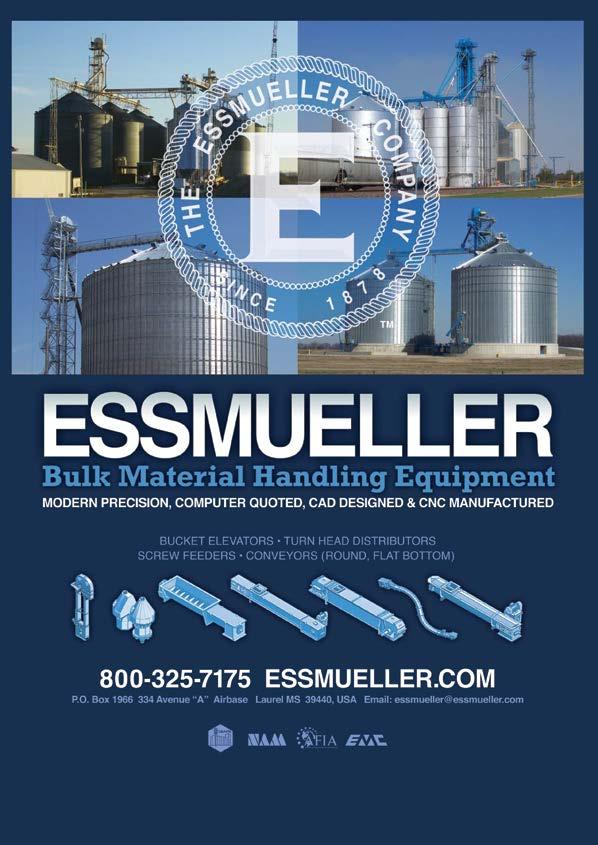

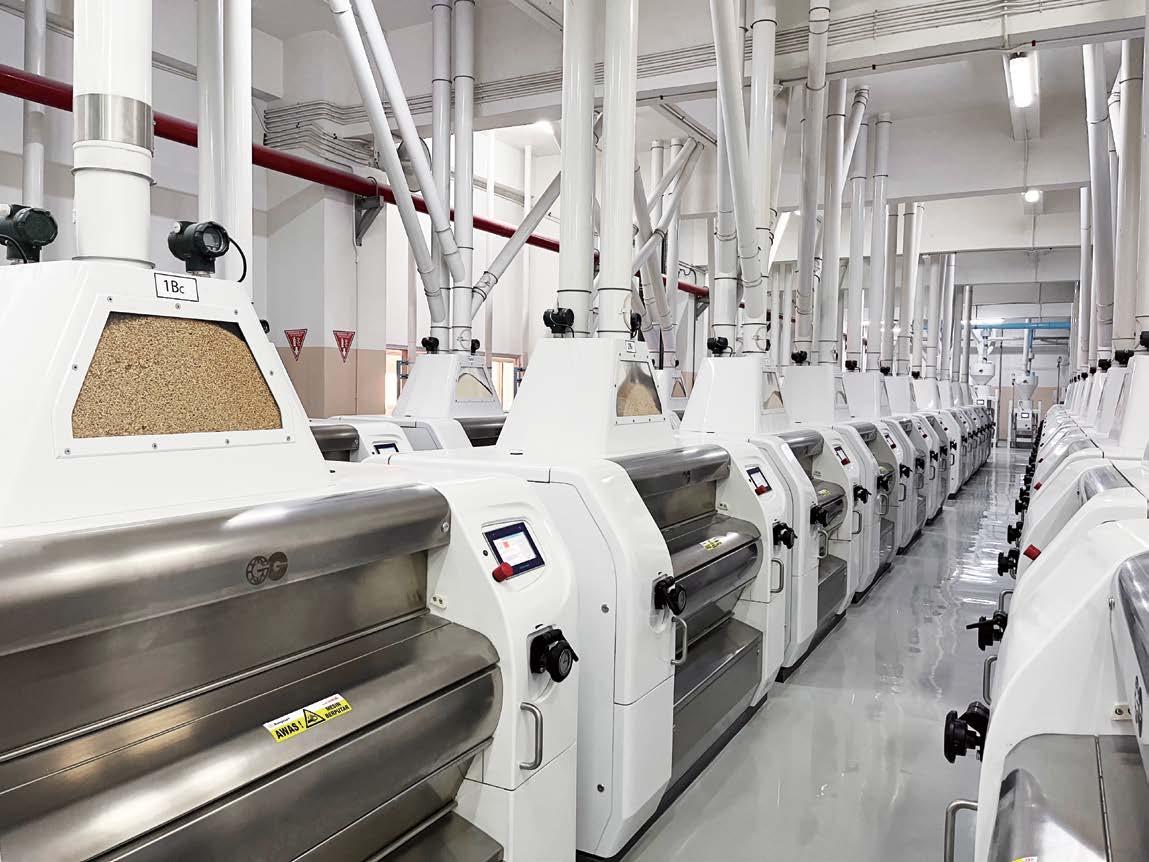

WHAT WE DO Designing FLOUR MILLING Manufacturing Turnkey project Service +86 371 68631308 info@g-grain.com www.g-grain.com SCAN ME FOR BROCHURE

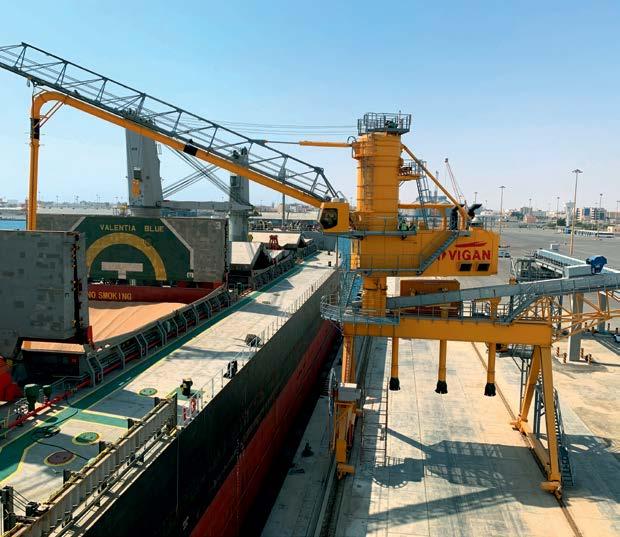
Handle bulk with efficiency and reliability
Pneumatic and mechanical ship (un)loaders
Up to 2500 tph for loaders and up to 1200 tph for unloaders.
Low noise & no dust emission
Turnkey solutions for cereals, soy flour, fertilizer, pellets and more...




Nigeria Marketing Team
Nathan Nwosu
Tel: +234 8132 478092 nathann@perendale.com
Egyptian Marketing Team
Mohamed Baromh
Tel: +20 100 358 3839 mohamedb@perendale.com
Turkey, Eurasia and Middle East Marketing Team
Mehmet Ugur Gürkaynak
Tel: +90 537 3646457 mehmetg@perendale.com
Editorial Manager
Joy (Jyothsna) Nelloolichalil joyn@perendale.co.uk
Editorial Assistant
Shannon Parsons shannonp@perendale.co.uk
Niamh Cassidy niamhc@perendale.co.uk
Social Media Journalist’
David Harvey davidh@perendale.com
International Editors
Dr Roberto Luis Bernardi robertob@perendale.com
Professor Wenbin Wu wenbinw@perendale.com
Mehmet Ugur Gürkaynak


8 10 24 33 36 39 80 82 86 94 100 103 104 106 Perendale Publishers Ltd 7 St George’s Terrace St James’ Square, Cheltenham, Glos, GL50 3PT, United Kingdom Tel: +44 1242 267700
Roger Gilbert rogerg@perendale.co.uk
Tel:
Team
Feng
dantef@perendale.com Latin America Marketing Team
Publisher
International Marketing Team Darren Parris
+44 1242303792 darrenp@perendale.co.uk Asia Marketing
Dante
Tel: +886 227930286
Cristina María Roldán Otero Tel: +44 1242 267700 cristinaot@perendale.co.uk
mehmetg@perendale.com
& Events
Tan
Manager
antoinet@perendale.co.uk millingandgrain.com ISSN No: 2058-5101 ©Copyright 2024 Perendale Publishers Ltd. All rights reserved. No part of this publication may be reproduced in any form or by any means without prior permission of the copyright owner. More information can be found at www.perendale.com Perendale Publishers Ltd also publish ‘The International Milling Directory’ and ‘The Global Miller’ news service Grain & Feed Milling Technology magazine was rebranded to Milling and Grain in 2015 MAXIMISED FLOUR MILLING 42 Nutritional Challenges: Enhancing the value of flour in combating micronutrient deficiencies 46 The dirty duo: Ridding the industry of Methyl Bromide and Sulfuryl Fluoride 50 ASYNCHRONOUS MOTORS: Drive belt versus direct drive 56 Egypt: The ancient heritage of grain processing 42 Combat raw material nutrient variability and boost profits with NIR STORAGE & HANDLING MAXIMISED 66 GEAPS Exchange: 2024 event in Kansas City, Missouri breaks all records THE PUBLISHER Milling News Gems from the Mills Archive Mill TRAINING FOCUS Product FOCUS Special CASE STUDY Commodities INDUSTRY EVENTS PEOPLE 20 Mildred Cookson, Mills Archive Trust, UK 27 Dr Mahmoud Riyad, Secretary-General, Egyptian Milling Association, Egypt 10 www.millingandgrain.com Find out more at: YOUR GLOBAL PARTNER VOLUME 135 ISSUE 3 April 2024 Industry Profile CHARITIES DIRECTORY the interview Regular items Feature content
Design Manager James Taylor jamest@perendale.co.uk Circulation
Tuti
tutit@perendale.co.uk Development
Antoine Tanguy
THE PUBLISHER
World Flour Day has come and gone - in a flash.
However, the response to the recognition that one day in our annual calendar is devoted to those who work producing the flour we use to produce healthy, safe and nutritious foodstuffs, that sustains us, is having wider appeal each year. It has now become well established in just six years.
 Roger Gilbert
Roger Gilbert
Milling and Grain talked about the impact of the World Flour Day and introduced a ‘Directory of Milling-related Charities’that we should all consider supporting at least once - in our March 2024 edition of the magazine.
Others took more practical measures to celebrate the day - particularly around donating - and we will be reporting on those in our May edition.
But first let me highlight what I feel is noteworthy in this edition. For instance, we report the extension of a rail transportation network in Australia; from GrainCorp’s site at Croppa Creek to the Port of Newcastle – a distance of some 560km from the north to the south-east across New South Wales.
Port Newcastle is some 160km north of Sydney.
This is a major development - in this instance for the canola crop destined for Europe - replacing some 50 B-double trucks and reducing carbon emissions associated with road transportation.
This first shipment was approximately 2600 tonnes and is the first of what will be more than a dozen similar trips to be made in the months ahead.
Called the Narrabri to North Star project, which was started back in 2021, this development involved the upgrading of lines, bridges and level crossings. A Phase II upgrade will allow for heavier freight volumes and faster speeds.
Although Phase I was completed earlier, this canola shipment is the first to take full advantage under GrainCorp.
This development signals the importance of investment in infrastructure that supports the way the world goes about feeding itself.
Ensuring our crops - and I speak from a global perspective - can make their way from cropping areas to ports and onward along international shipping lanes to markets and industries where they are needed, is vital to feeding a growing world population. And Australia is to be congratulated for making such a significant and timely investment.
Read our Case Study story on Page 84.
Talking of grain handling and transportation, we at Milling and Grain were excited to be returning to the USA in March to attend the annual GEAPS Exchange event, which focuses on grain storage and transport.
The Kansas City, Missouri location has become a more permanent home for this important event which, due to its more settled location, is attracting an increasing number of international visitors and exhibitors.
Our report this year (see Page 70 onwards), highlights individual booth holders, their companies and their key products and services being provided through a ‘picture caption’ approach.
While it may be that equipment “speaks for itself,” it’s the people and the services they provide that makes all the difference in having reliable technology to ease the task at hand and to carry out processes that do
MILLING AND GRAIN | ApRIL 2024
not damage or reduce the quality of grain – from harvest through to the mill.
In contrast over the recent Easter weekend I was fortunate enough to be taken for lunch at the cafe in the ‘Old Prison’ at Northleach, which is not far from our home town Cheltenham. Now a museum (and closed in 1857, when modern railways allowed for prisoners to be moved to more modern facilities - see https://www.theoldprison.co.uk/history). I was astonished to see in the Old Prison’s exercise yard and under cover a wide range of 18th and 19th Century horse-drawn hay and wheat wagons that had been carefully restored along with a display of a forge and the resident blacksmith’s equipment for wheel-making.
It brought home to me, in stark relief, the way we take for granted how our grains are harvested and transported today compared to the hard work and labour that was required to achieve those same tasks just 100-or-so years ago. The juxtaposition of the two visits within a month was palpable.
This collection of old wagons and farm implements, on behalf of the Cotswold District Council, was originally owned by Miss Lloyd-Baker, a landowner at Hardwick Court. She gathered the collection together in the decades following the second World War with pieces dating from the end of the 19th Century through to the first quarter of the 20th Century.
It makes me think that World Flour Day is also a time to consider just how far we have come, and in keeping with this magazine’s focus on history and the importance we place on developments over time, it is good that so many both within and from outside our industry are encouraged to take an interest in where thiese staples in our diets comes from. (If you’re interested in Miss Lloyd-Baker’s collections, please see - https://www.theoldprison.co.uk/rural-life-collection).
Progress is not always based on what comes next but is built on developments and improvements that have been hard won in the past. And with that in mind I would like to recommend the Mills Archive Trust as a starting point if you want to become more familiar with how our industry functioned prior to the development of newer technologies and since moving away from stones and onto roller mills.
Without roller mill technology it might be fair to says that we would have either missed out on a regular consumption of a sound source of protein, minerals and carbohydrates, etc – now staples in our diets - or be costing too much for the majority of us to gain access to.
As with all things we shouldn’t overlook or devalue the work that our forebears have done that allows us to enjoy the choices of foodstuffs we have today and that is why World Flour Day – March 20th – should be celebrated by everyone for the contribution millers have and are still .
Finally, I had the opportunity to interview the CEO of Bühler, Mr Stefan Scheiber, earlier this month following the announcement by the company of its financial outcome for 2022-23. A video interview with Mr Scheiber is now on MAGTv/RongoRoingo Live and he also appears as our guest interviewee on page 104. Happy reading!


Annual Subscription Rates Inside UK: UK£100 Outside: US$150/€133 More Information www.millingandgrain.com http://gfmt.blogspot.co.uk Milling and Grain has a cooperative partnership with COFCOET
8 | April 2024 - Milling and Grain


Stefan Scheiber, CEO of Bühler Group in Switzerland speaks to Roger Gilbert, Publisher of Milling and Grain following the issuing of the company’s annual financial report for 2023.
Mr Scheiber talked about Bühler’s drive for innovation in alternative foodstuffs, as there is a growing acceptance of new products worldwide, and despite a recent fall back in uptake the company foresees a promising future for new protein replacement foods. Mr Scheiber anticipates higher investments over the coming years in his industry, with sustainability emerging as a crucial concern for both key players and consumers. Technological advancements are revolutionising modern mills, which in turn is emphasising the importance of training and skill accessibility to ensure sustainable food production via the milling industry meeting the needs of a growing population.
Science and technology play pivotal roles, not only in creating awareness of sustainability challenges but also in fostering transparency around CO2 footprints throughout the food-supply chain.
Mr Scheiber states, “We should not see the industry as the problem, but rather the solution.” It’s also important to recognise the importance of addressing cost concerns in a positive mindset - an investment in the future, he adds. Looking ahead, meeting basic nutritional needs amidst population growth poses significant challenges, demanding innovative solutions facilitated by science and technology. “While the journey ahead will not be easy, believing in our capacity to solve these problems is essential,” he says.

Welcome back to Milling and Grain magazine, specifically, the April edition of the Global Miller. Spring has begun so it’s the season to prep those boots and fertilise the ground as it’s time to begin planting crops. If the weather is good then we may even get to see some cherry trees and azaleas blossom.
I like to research some facts about each month and farming for some inspiration on what to write here and I found a few interesting things, my favourite that is most relevant to this magazine is that wheat is the most popular grain directly consumed by people. Both surprising and not when you truly think about it. Wheat has been in use for centuries as flour through the consumption of bread and bread-derived foods, a cheap and filling staple for most meals.
Last month we even celebrated World Flour Day. FlourWorld Museum took an initiative, as a celebration of global solidarity and charity, to make this year’s World Flour Day a “Giving Day” where the milling industry makes a difference in the lives of those in need. So far in 2024, they have delivered nearly 29 tonnes of product, benefiting more than 20,000 people. And it is a pleasure to know that they are extending World Flour Day beyond March 20.
Wheat though, is a derivative of grain, which is as we all know, incredibly important to our society. Growing annually, they play a role in feeding both people and livestock, along with being used in the manufacturing of industrial products. Talking about feeding people, India is one of the biggest producers of grains and in
Our titles are available
order to seek minimum price guarantees for their crops, thousands of Indian farmers are set to resume their march towards Delhi, the country’s capital. After a young farmer passed away during the protest, the farmers decided to call off their strike at the end of February. Delhi’s borders are closely guarded, and police have been deployed in to stop the march. As India heads to election, the government should take the demands of farmers with paramount importance as they play the main role in feeding the worlds’ most populous nation. Farmers not getting enough support from the authorities is an issue all around the world since always. It’s clear that we need to change this aspect of agriculture if we’re going to attract the next generation of farmers.

Taking a sneak peak into other news, you’ll come to find that the Turkish company, Alapala have completed 21 turnkey projects in 2023 throughout 15 different countries. What an achievement! Cimbria also dips their toes into the world of AI and takes sorting to a new level with their new AI powered software Brian. Alongside this, Yemmak is honoured with the European Product Design Award for one of their machines. Read their news to find out which.
Lot of events for the Milling and Grain team have been happening these last few months too and we’re excited to talk about them with you! Be prepared to read about all the fun everyone had at GEAPS Exchange 2024 and TUSAF in Antalya,

10 | April 2024 - Milling and Grain Milling News
IN PRINT ONLINE MOBILE


Novus acquires enzyme company BioResource International
Novus International announced that it has completed the acquisition of US-based enzyme company BioResource International (BRI). Under the terms of the agreement, Novus becomes the owner of all BRI’s products and intellectual property and takes control of the company’s facilities.
“This move will allow us to serve our customers better and expand our innovation pipeline further,” says Novus President & CEO Dan Meagher. “Enzymes are vital tools for producers to ensure animal health and well-being and help deliver on-farm profitability. We’re very excited to offer our customers more options, as well as aspire to develop new feed additives.”
The relationship between the two companies isn’t new. Novus has partnered with BRI since 2008 to manufacture its protease product, Cibenza Enzyme Feed Additive. Meagher says having full ownership and control of the product line and the option to expand Novus’ portfolio beyond protease enzymes is a natural fit in the company’s long-term strategic plans.
“As a leader in intelligent nutrition, Novus’ priorities include investing further in functional proteins and the gut health segment, growing our portfolio, and achieving stronger control of our supply chain,” he says. “Along with
supporting these goals, acquiring BRI also increases our capabilities to develop innovative solutions in the fermentation space.”
BRI’s co-founder and CEO Giles Shih says the acquisition and tapping into the knowledge of employees in both BRI and Novus allows for the continued growth of the company he helped create 25 years ago.
“We are super excited about the future where BRI’s products and people combine forces with the global reach and deep industry knowledge Novus brings to the feed additive space,” shih says. “This deal is not one of happenstance. Our two companies have worked closely together since 2008 to launch the first generation of heat-stable protease feed enzymes and shape how they are developed, marketed and optimised to add value to customers worldwide. This acquisition will enable Novus to innovate the next generation of proteases and enzymes that will do even more, from promoting gut health to promoting the bottom line.”
Along with BRI’s current product portfolio, Novus also takes over the company’s facilities in North Carolina in the US.
Meagher says continuity is key for current BRI customers and they should experience “business as usual” during the integration process.

12 | April 2024 - Milling and Grain Milling News


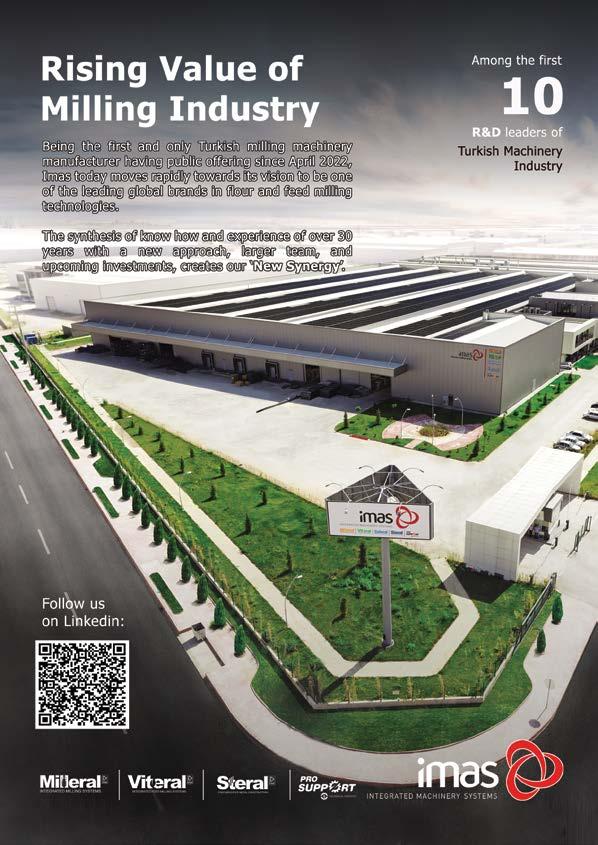
Yemmak wins award in global design competition
Yemmak was honoured with an award in the industrial design category of the European Product Design Award for its Fine Grinding Hammer Mill. Yemmak, a leading manufacturer of machinery and equipment in Turkey’s feed industry, aims to strengthen its success in the global arena with the design award it has received.
Halil Yırtımcı, Vice General Manager of Yemmak, said “We export a large portion of our production to 46 countries worldwide and are among the leading companies in the sector. With this success, we continue to create value for Turkey. This award we have received is the most important indicator that Yemmak combines the principle of sustainability in its equipment with design.”
Yemmak’s FGHM series Fine Grinding Hammer Mills play a critical role in the production of fish feed and petfood. Designed specifically to reduce raw materials with a diameter of 10mm to as small as 50 µm, these mills play a vital role in the production process. This machine, which attracts attention with its new design,



is made from recyclable materials and features dynamic and masculine lines. The product was elevated according to various criteria such as innovation, aesthetics, functionality and ergonomics. This design, which also boasts a modern and minimalist appearance, has been conceived in line with Yemmak’s corporate identity.

Scan the QR-Code to find your die! WWW.PCE.EU Are you in search of high-quality ring dies that perfectly fits all brands of pellet presses? Milling and Grain - April 2024 | 15 Milling News
BoMill collaborates with Baltijos Javai for upgrade of BoMill InSight
Based in Kaunas, Lithuania, UAB ‘Baltijos Javai’ provides processing and trading capabilities as well as consultancy services to the barley value chain. In September last year the company ordered BoMill InSight with two sorting units for a value of EUR 270,000 to further secure the quality and optimise supply of malting barley in the region. In partnership with Viking Malt, one of the top ten largest malt producers in the world, the equipment is installed at the malt house site in Panevėžys, Lithuania.
Following a few months of use, Baltijos Javai has decided to purchase six additional sorting units for a total value of EUR 260,000 to upgrade the existing installation and reach the maximum 15 tonnes per hour sorting capacity offered by BoMill InSight. Thanks to the modular design of the BoMill solution, these six sorting units will be easily added onto the frame already equipped with two units, from the previous order. The delivery of the additional units is scheduled for Q2 2024.
“We are excited about this agreement which is another milestone for BoMill InSight. This capacity upgrade is
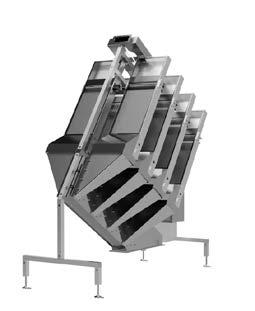
a repeat order confirming our customer recognises the reliable performance and strong return on investment of our technology. We look forward to further supporting Baltijos Javai and Viking Malt in their development” stated Andreas Jeppsson, CEO of BoMill AB.
Reduce costs and prevent risks
Optimize your entire production chain
Guarantee higher quality products
BESTMIX® Feed Formulation, Quality Control, Ration Calculation and ERP solution.



Scan to learn more: www.bestmix.com
TIME FOR THE NEXT GENERATION SWISS PREMIUM MILLING TECHNOLOGY Stay tuned LinkedIn SWISCA 16 | April 2024 - Milling and Grain Milling News
The most advanced software solutions for feed production:
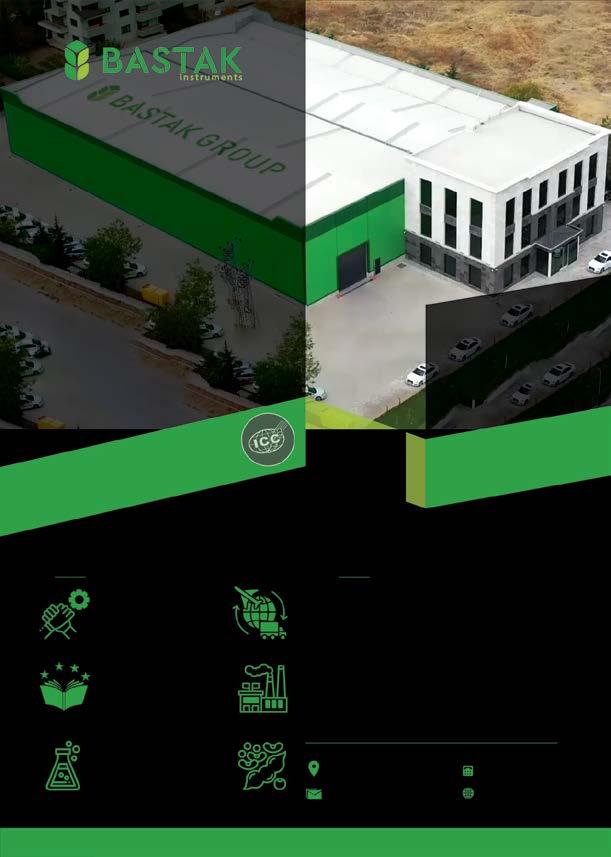



Erhan İncioğlu Highlights Grain Cleaning at IAOM
At IAOM MEA Regional Milling Forum in Lusaka, Zambia, Mr. Erhan İncioğlu, Sales and Marketing Director at Tanis Milling Technologies, took the stage to shed light on the pivotal role of grain cleaning and conditioning in agricultural processes.
The presentation, titled ‘Grain Cleaning & Conditioning: Enhancing Quality, Efficiency, and Sustainability in Agricultural Processes,’ delved into the significance of these practices within the agricultural supply chain.
Grain cleaning and conditioning were emphasised as indispensable steps in the processing of wheat, ensuring the quality and safety of the final product. The removal of impurities, such as dirt, dust, stones, and foreign materials, emerged as a critical aspect to guarantee the high quality of flour, affecting taste, texture, and overall consumer satisfaction.
higher-quality flour, free from contaminants that could compromise the end products’ taste and texture. The prevention of contamination by mycotoxins, molds, and other harmful substances was underscored as a crucial aspect of grain cleaning, directly impacting the safety of the end consumer.
Moreover, the presentation touched upon how clean and conditioned wheat optimizes the milling process, preventing equipment damage and reducing wear and tear on machinery. This, in turn, enhances operational efficiency and lowers maintenance costs. The adjustment of moisture content during conditioning was discussed as a key factor in achieving pliable wheat grains, reducing breakage during milling and resulting in higher yields and less flour waste.
In addressing insect pests, grain conditioning was presented as a method to control their growth and reproduction, preserving the quality of the grain. Additionally, the removal of impurities and controlled moisture content contribute to an extended shelf life for both the wheat and the final flour product, crucial for storage, transportation, and ensur-


Milling and Grain - April 2024 | 19 Milling News


Moinho Central, Sao Paulo, Brazil
Milling journals of the past at The Mills Archive
by Mildred Cookson, Mills Archive Trust, UK
This important Brazilian mill was introduced in “Milling” in June 1937. In the 1930s Brazil was still suffering a great deal of political and financial instability with revolutions and coups d’état. Despite this, new industries were developing, particularly in Sao Paulo, the country’s greatest industrial centre. Standing 2,500 feet above sea level and yet only 50 miles from its port of Santos, it turned over 25 million tonnes of grain annually. The State Ministry of Agriculture controlled an Agricultural Institute in Campinas, a Biological Institute in Sao Paulo and hundreds of agricultural experimental stations.
Although South Brazil had areas that were suitable for wheat cultivation, they produced only a soft, weak type, that had been neglected in favour of more suitable crops with a better return. Up to the latter part of the nineteenth century, all flour had to be imported into Brazil, mostly from Argentina.
It was soon decided that it would be more economic to import wheat and grind it in Brazil. Several plants were quickly erected, notably ‘Simon’ plants for the late Count Matarazzo in Sao Paulo and for the Rio de Janeiro Flour Mills called ‘the English Mill’. Moinho Central, one of the Sao Paolo mills was destroyed by fire in 1934. The owners, Bunge & Born Ltd., a leading South American company for flour millers, grain exporters, decided to rebuild the mill and equip it in such a manner that it would incorporate all the recent developments in milling practice, and so become a monument to the progress of industrialism in the country. The better-known milling engineers of the time were
consulted and after a careful and detailed investigation of the various systems put forward, Henry Simon was chosen.
The site was to be between two railways, on one wheat would be received from the port of Santos, and flour could be dispatched towards the coast, on the other flour could be sent to all parts of the interior.
There were three main buildings, the silos and preliminary cleaning department which could hold 5000 tonnes of wheat, warehouses each three floors high, with facilities for loading both to railway and road. The silos and warehouses had been saved from the 1934 fire.
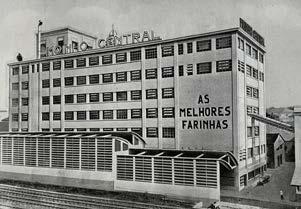
Main roller floor
20 | April 2024 - Milling and Grain
Moinho Central with the enclosed wagon way in front

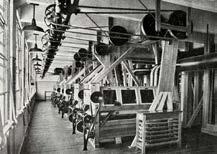
Due to the high cost of steel the use of reinforced concrete was used for the building. The mill was built with seven storeys each around 12ft high with a flat roof on which a separate two storey building contained water tanks and controls. Cutting right through the building were two expansion cracks, to allow for the big variation in temperature experienced in Sao Paulo. The inside resembled more of a baronial hall than a mill with its vast expanse of polished floors.
Along one side of the building ran an enclosed wagon way. Steel fire escapes were fitted outside the building. Access to the mill, screen room and packing departments floors was through fire proof doors which would close automatically in case of fire, shutting off the stairs completely from the mill.
The ground floor was divided into a bag department for marking up new bags and where empty ones were cleaned and repaired. The first floor contained the elevator boots, exhaust trunks and drives to the rolls. Here also were the motor houses for the two mills, screen rooms and packing department (all had their own
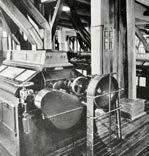
separate motors). The rolls were on the second floor that also housed the main electrical control cabin. The third was the spout floor, the fourth was the purifier floor with Germinal brushes, and on the fifth flour were the plansifters, dust filters and wheat washers. On the sixth floor were the elevator heads, detachers, flour and offal weighers, fans, waterwheel dampers and the laboratory.
On arrival at the mill the trucks with the wheat were shunted under the covered wagon way, here a long grill, which covered a series of hoppers opened onto a band conveyor which ran in between the two tracks. The wagons were opened to empty by themselves, and the grain conveyed to the silo. A sample of wheat was taken from each wagon and sent straight to the laboratory for analysis.
Of the two mill plants ‘A’ was the larger and had a capacity for 30 sacks per hour, whilst the ‘B’ plant had a capacity of 15 sacks per hour. Both plants would be expanded to their full use of 45 & 30 sacks.

 A line of Simon Plansifters Further Simon Plansifters showing exhaust trunking and sampling table
A line of Simon Plansifters Further Simon Plansifters showing exhaust trunking and sampling table
Milling and Grain - April 2024 | 21
One of the roller mills
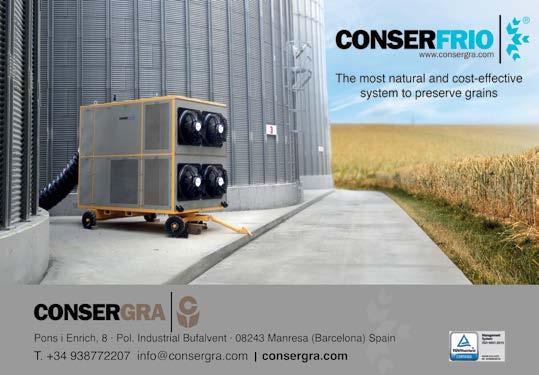
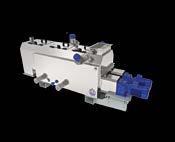
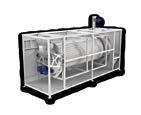


C M Y CM MY CY CMY K pubblicità italiana_MOD.pdf 1 27/01/22 10:59 22 | April 2024 - Milling and Grain
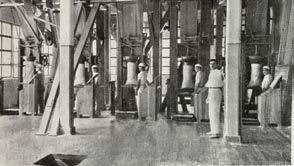
The flow of each plant was identical, the only difference being ‘A’ could deal with 200 bushels per hour and ‘B’ 100 bushels. The purification system on plant ‘A’ comprised three grades of semolina, a separate third break semolina, coarse middlings fourth coarse, fourth fine, and fifth breaks. Plant ‘B’ had only two grades of semolina, a single scratch system and less re purification. The 44 kilo bags of flour were machine sewn and sent down chutes to the warehouse.
Lighting used arc floodlights, each floor having 90 points. Lighting also illuminated four large neon signs: “MOINHO CENTRAL” along the top of each side of the mill.
The engineer in charge of the mill building and erection was Senor Belotti, engineer in chief to Messrs. Bunge. The technical manager of the mill Mr C A. Lockwood, trained in England and before going out to Brazil was milling in Kenya. He was brother to J F Lockwood of Henry Simon Ltd and author of Provender Milling (1939) and Flour Milling (1945).

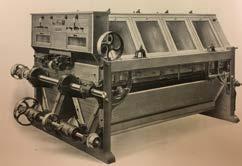


Infestation control = CO2 monitoring

The iGRAIN CO2 Sniffer Cable is the most unique contribution to safe, efficient, and advanced infestation monitoring of stored crops. First introduced by
Advantages:
• Earliest possible infestation warning
• iGRAIN Risk Factor classification showing level of infestation (1-6) for each silo
• Predicts number of safe storage weeks left
• Alerts about insects and fungi in the daily report
• Effective way to avoid Aflatoxins, Mycotoxins, Ergot, and Fumonisins
• Connects with the iGRAIN Smart App
The iGRAIN CO2 Sniffer Cable alerts about any infestation (fungi and insects) weeks before temperature monitoring would.
T0: Temp. + CO2 are not increasing = NO Infestation
T1: Temp. stable, CO2 slowly rising, beginning infestation
T2: Temp. stable, CO2 rapid increase, serious infestation
T3: Temp. rising, high CO2, serious grain spoilage
This is an example from a flour mill where all grain was spoiled, 1.800 tonnes lost

The Simon Fanless purifier
iGRAIN in 2010 and now installed in thousands of grain silos.
AIO Sniffer Cable iGRAIN - Denmark - info@i-grain.net - www.i-grain.net CO CO Hot spots 9300 8600 7900 7200 6500 5800 5100 4400 3700 3000 2300 1600 900 200 CO 2 35 30 25 20 15 10 5 0 Temperature (C) 2023 /01 /01 2023 /01 /17 2023 /02 /02 2023 /02 /18 10,000 PURPLE = CO2 concentration in the silo ORANGE = average of all sensor points RED = warmest sensor point in the silo BLUE = coldest sensor point in the silo T0 T1 T2 T3
MAG Half Page 04-2024 CO2 monitoring B.indd 1 20/02/2024 15.42.17 Milling and Grain - April 2024 | 23
Insects Fungus
Gems from the Mills Archive
The Reservist Mill
by Nathanael Hodge, Mills Archive, UK

As well as their practical function, mills have often been used as symbols throughout history and have a variety of meanings in different cultures. The power of mills to transform wheat into flour makes them particularly suited to being used as a metaphor for other kinds of transformation.
An unusual example is this postcard, dating to before the First World War, entitled ‘Die Reservisten Mühle’ – ‘the Reservist Mill’. Aimed at encouraging Germans to recruit in the armed forces, the postcard depicts civilian German men entering a windmill and exiting as reservists.
On the left we can see man embracing his beloved under the words ‘Rekruten – Abschied’ – ‘Recruits, farewell!’. In the centre is the mill, with ‘Die Rekruten’ – the recruits – entering on the left with their bags and belongings, and ‘Die Reservisten’ – the reservists – exiting triumphantly on the right in their new uniforms. A signpost points to ‘die Heimat’ – home, and above we see their arrival home by train to be reunited with their families.
The poem below the windmill sums up the metaphor:
Sowie das Korn germahlen fein
Und kommt als Mehl heraus
Der Rekrut geht in die Kaserne ein
Und kehrt als Reservist nach haus
‘Just as the corn is finely milled And comes out as flour
The recruit goes into the barracks And comes home as a reservist’
A space over the mill’s doorway allowed the recruit to write down the number of days he had left to spend in the barracks – in this case 190.
The postcard was produced at a high point of German militaristic nationalism. Following their victory in the Franco-Prussian War of 1870-1871, the Kingdom of Prussia under its chancellor Otto von Bismark had led the way in unifying the German nation. By 1914 Germany had the most efficient army in Europe and had implemented universal mass conscription. Men were recruited into compulsory military service which lasted for three years, followed by four years as a reservist.
‘Mailing cards’ such as this were introduced in Germany in 1865 by Heinrich von Stephan, the Postmaster General of the German Empire. The first legally printed postcard carried a similar Prussian militaristic theme, with a picture of a German Artillery man loading a cannon. From these origins, Germany would become the leader of the postcard printing industry, with a particular boom of ‘postcard mania’ in 1903.
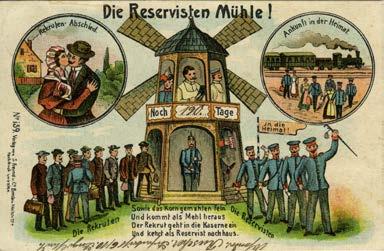


www.millsarchive.org
24 | April 2024 - Milling and Grain


If you can think it, we can pack it!

With over 150 years of combined experience, we help you find your individual packaging solution. Over the years, we have developed machines that cover a range of weights from 50 grams to 25 kg for flour based products. In addition, we help you meet global environmental challenges without compromising on performance.
















The Packaging Group GmbH · Germany · www.tpg-packaging.com
create your perfect flour packaging solution!
Let’s
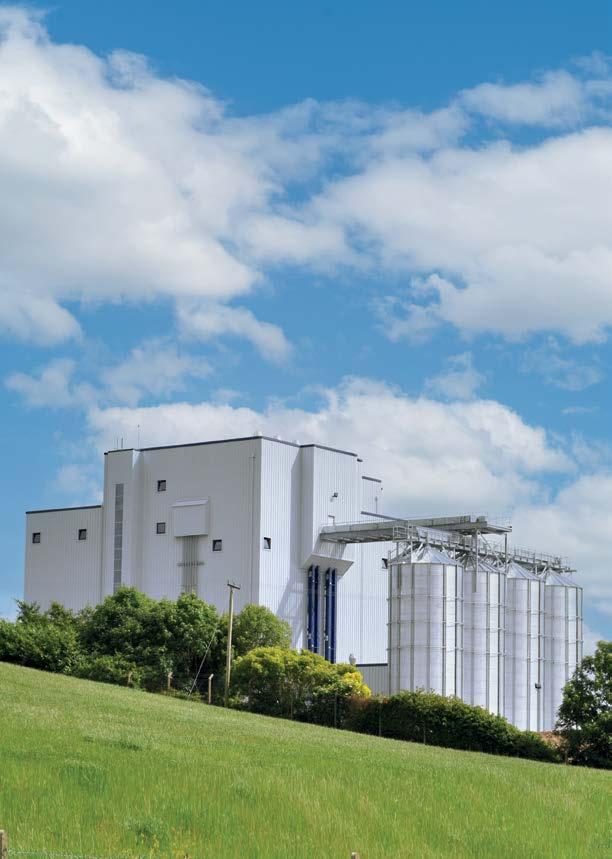
Looking for a total feed mill solution? We’re listening
As industry experts, we understand the unique challenges you face in the animal feed industry. That’s why we are committed to assist you throughout the entire journey, from concept to complete installation. We are fully equipped to bring your vision to life!
Fane Valley, Ireland
»
Let’s talk partnership

 by Dr Mahmoud Riyad, Secretary-General, Egyptian Milling Association, Egypt
by Dr Mahmoud Riyad, Secretary-General, Egyptian Milling Association, Egypt
Egypt raises wheat procurement price in new harvest season
Egypt’s cabinet has increased the local wheat procurement price by 25 percent from EGP 1600 to EGP 2000 per ardeb (1 ardeb = 150 kg) (One Dollar = EGP 47.25) for the forthcoming harvest season.
The decision is meant to support Egyptian farmers, stated Mohamed ElHomosany, the cabinet spokesperson, on Wednesday 13, March.
Egypt has been adopting a series of measures to encourage farmers to sell more wheat to the government. The goal is to increase local production amid the disruption in the food supply chain caused by the Russia-Ukraine war.
In November 2023, the government increased the procurement price by 6.6 percent to EGP 1600, up from EGP 1500. The step followed the rolling of a package of incentives for farmers.
Egypt’s annual wheat consumption is estimated at around 20 million tonnes, according to the Ministry of Supply and Internal Trade.
Egypt produces nine million tonnes of wheat annually.
According to the UN Food and Agriculture Organization (FAO), Egypt
imports over 12 million tonnes of wheat – a figure likely to increase to more than 15 million tonnes by 2028.
A cabinet report stated that Egypt needs 7.7 million tonnes of wheat in 2024 to make 93.5 billion bread loaves, an Egyptian staple.
Unsubsidized bakeries decided to raise the price of a loaf of bread to EGP 2, up from EGP 1, in early 2024 as a result of fluctuations in dollar exchange rates.
In January, the Ministry of Supply and Internal Trade suspended trading in wheat in the Egyptian Mercantile Exchange (EME) due to price speculation in the local market.
At the time, Abdel-Ghaffar El-Salamouni, deputy head of the Chamber of Grain Production at the Federation of Egyptian Industries, denied a shortage in the domestic wheat supply, adding that the fluctuation in the exchange rate is among the reasons behind the price speculation
In 2023, Egypt’s wheat imports amounted to around 10 million tonnes, 68 percent of which came from Russia.
Egypt has been grappling with a wheat shortage since the onset of the Russian-Ukrainian crisis in 2022. About 80 percent of Egypt’s imported wheat comes from Russia and Ukraine.
Egypt’s strategic wheat reserves are sufficient for 4.2 months, oil for 5.3 months, and sugar for 5.4 months, said Minister of Supply and Internal Trade Ali Al-Moselhi.
The remarks came after the minister inspected the West Port Said Silos project, which is located on an area of 15,000 square meters and has a storage capacity of 100,000 tonnes.
Al-Moselhi said Egypt imports six million tonnes of wheat annually through its ports, explaining that no silo has been built in the ports since 1984.
A cabinet statement said earlier this month that the country had planted 3 million fedans (3.1 million acres) worth of wheat since November 2023, an increase of almost half a million acres, Egypt Today reported.







Milling and Grain - April 2024 | 27

Alapros unveils flour factory project in Tajikistan
Alapros, a pioneering force in the milling machinery sector, has unveiled plans for a groundbreaking project set to revolutionise the flour industry in Tajikistan. The company has announced the construction of a state-of-the-art single-line flour factory, boasting an impressive daily capacity of 1200 tonnes. Expected to be the largest of its kind in the region, this venture signifies a significant leap forward for Tajikistan’s milling capabilities.
This innovative endeavor promises to introduce novel solu-
tions never before seen in the industry. The flour mill will feature entirely new infrastructure, including cutting-edge buildings and silos, showcasing Alapros’s commitment to pushing the boundaries of technological advancement.
Scheduled to commence operations in 2025, the project holds immense promise for both the industry and the regional economy. By leveraging advanced milling techniques and modern facilities, Alapros aims to enhance productivity, quality, and efficiency in flour production, thereby catalyzing growth and development in Tajikistan and beyond.
With anticipation building for the unveiling of this transformative venture, stakeholders eagerly await the positive impacts it will bring to the milling sector and the broader economic landscape of the region.








28 | April 2024 - Milling and Grain Milling News
FROM CONCEPTION OF THE PROJECT TO MANAGEMENT

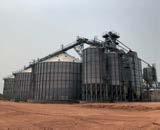
• GRAIN STORAGE INSTALLATIONS
• GRAIN PORT TERMINALS
• GRAIN DRYING FACILITIES
• INDUSTRIAL PROCESSES
• DESIGN
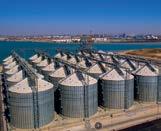
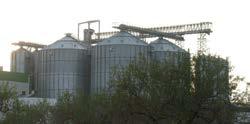
Agribusiness facilities
Silos Córdoba provides engineering services for product quality control, storage and handling equipment, ensuring convenience, reliability, efficiency and profitability in plant management.

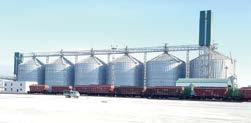
Turn-key projects
Silos Cordoba mainly operates in the post-harvest sector where it offers comprehensive solutions for your grain storage, handling and conditioning needs.
Silos Grupo S.L. Glorieta de las Tres Culturas Nr. 1, 4º A 14011 Córdoba. Spain T +34 857 835 623 info@siloscordoba.com www.siloscordoba.com
SCG




APPROX 40 MILLION TONS OF GRAIN IS SAFELY STORED IN MYSiLO SILOS.
CONTINENTS more COUNTRIES than 5 80’




more more CUSTOMERS PROJECTS than than 2000’ 2500’ HAPPY WITH MYSiLO GRAINS MYSiLO GRAIN STORAGE SYSTEMS INC.CO. Erenler OSB Mah. R. T. Erdoğan Blv. No: 30 Aksaray / TURKEY info@mysilo.com | www.mysilo.com | +90 382 266 22 45

We will be seeking enrolments from June ...

Spread over the study year, the cost of a module is less than £12 a week
Study increases competence thereby freeing up your time
All students are allocated a tutor with a wealth of specialist knowledge
O S T E F F E C T I V E
C
T I M E E F F I C I E N T I N D U S T R Y E X P E R T I S E
learning Distance learning PROGRAMME
Distance
. . . F I N D O U T I F S T U D Y W I T H U S I S R I G H T F O R Y O U A N D Y O U R T E A M W E ' R E H E R E T O H E L P - F I N D O U T M O R E O N L I N E O R E M A I L U S : W W W . U K F L O U R M I L L E R S . O R G | T R A I N I N G @ U K F L O U R M I L L E R S . O R G
IFF Practical course: Pelleting of compound feed
In the EU, about 75 percent of the industrially manufactured compound feed is pelleted. The essential evaluation parameter for pellet quality is the abrasion resistance, which depends on many parameters. Physical and chemical properties of the feed formulations are to be considered as well as steam quality, conditioning, press parameters, cooling, and the stability of thermolabile additives.
Conditioning, pressing, and cooling consume more than half of the energy needed to produce compound feed. Rising energy costs require the use of savings potential. It’s worthwhile to expand knowledge and skills to ensure the economically successful operation of compound-feed production!
Expertise in pelleting is presented in an easy-tounderstand form in presentations by scientific and technical staff of the institute as well as with external support from the field and deepened in practical exercises in the institute’s
technical centre. Various measurement and test methods are introduced, and their handling trained.
Course participants are enabled to master the pelleting process in their daily professional practice and to control it with simple means. The target group are primarily employees who work directly with the pelleting process and are responsible for the quality of the pellets produced.
The course mainly appeals to employees who are directly involved in the pelleting process and can significantly influence the essential quality properties of the produced pellets (abrasion stability, moisture) by their technical know-how and experience.
The participation in this course is especially recommended for the training and further education of persons who have entered the compound-feed industry from other industries.
The course runs from 6-7 May 2024. The first day includes two hours of lectures and discussion, on agglomeration, milling and grinding, and material properties.
The second day runs for approximately two and a half hours, with lectures and discussions on the evaluation of the pellet quality, and influencing factors and processes around pelleting (Stem, conditioning, pelleting, and cooling).

Milling and Grain - April 2024 | 33
TRAINING
Mill
AFMA and Nef Feed Milling Short Course
The African Feed Manufacturers’ Association (AFMA) has partnered with Nef Feed Milling Consulting to offer an intensive Feed Miller Short Course. This comprehensive program is slated to run from May 6th to May 16th, 2024, at The Conclave Country Lodge, located just north of Pretoria.
Attendees can expect to gain practical knowledge in the application of machinery and process technology, ultimately enhancing feed mill efficiency. The course particularly emphasizes the practical intricacies of core processes within
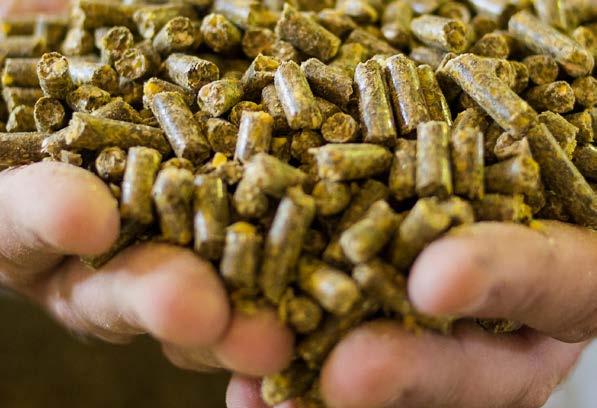
compound feed production plants.
Spanning over nine days with a weekend break, the curriculum delve into various facets, including manufacturing processes, aspiration systems, batch mixing, size reduction, liquid addition, hygienizing, compacting, expansion, drying, cooling, and mechanical conveying.
Renowned industry experts will lead the course, with Ernst Nef from Nef Feed Milling Consulting at the helm. Notably, Ernst Nef brings a wealth of experience, having previously served as the Executive Director of the Swiss Institute of Feed Technology (SFT).
The course is divided into two weeks: May 6th to 10th, and May 13th to 16th, 2024. A social dinner, generously sponsored by Bühler, will be held on May 9th, fostering networking opportunities among participants.
The Conclave Country Lodge, Welgedacht, Pretoria, will serve as the venue for this learning experience.

We train the workforce of tomorrow. Expand your knowledge, exchange ideas and gain experience in our academies around the world. Let’s shape the future together
Scan the QR code for more information.
millingacademy@buhlergroup.com

.
Innovations for a better world. 34 | April 2024 - Milling and Grain Mill TRAINING
Product Spotlight - The Holmen NHP300 Fully Automatic Inline Pellet Durability Tester by Tekpro
The is a fully automatic pellet durability tester used for calculating Holmen N H P300 the Pellet Durability Index (P D I) of animal feed pellets, by simulating the transportation environment from mill to trough.
The pinnacle of pellet durability testers
The N H P300 automatically extracts and tests samples from a busy production line and displays the results in the N H P300 Windows control software, or alternatively in your existing mill management system software. After the test, samples can be returned to the production line or discharged into a waste container without operator intervention.
By testing pellets during the production process, near realtime results can be used to help maintain the quality of output, by adjusting the mills settings at a time that will save energy and minimise waste.
Fitted as standard with a 2.5mm diameter perforated hopper, the N H P300 is ideal for testing pellets with a diameter of between 3 to 12mm.

Automatic pellet sampling

OLM

Samples are extracted from the process line using an in-line Samplex IL50 sampler. The optimum extraction point is between the pellet press and the cooler Samples are taken at set intervals, and can be taken from up to four different production lines into one single N H P300 machine.
The N H P300 cools and de-dusts the pellets prior to testing, weighs the sample, tests the pellets, weighs the remaining sample and calculates the P D I, all fully automatically without user intervention.. Additionally, it has the ability to calculate the amount of Fines if required.
Results are sent to the included Windows control software or can easily be integrated into the mills current mill management software.
N H P300 proprietary control software
The software supplied with the Holmen NHP300 offers direct compatibility with any Windows X P, Windows Vista, Windows 7 and Windows 10 based operating system.
The software allows for individual pellet details, ration identity, test and delay parameters to be entered prior to process line production.
The results after each test are displayed graphically in the N H P300 Control Software, or with the addition of a printer, by hard copy The easy to understand graphical display of the results alerts the operator to any inconsistency and deviation from the preset desired durability, enabling the operator to make timely adjustments to the manufacturing process parameters to maintain and stabilise the required durability An audible alarm can also alert operators if the pellets are outside of the preset target.
Each test result is also saved into an S Q L Server Database, where the end user has the ability to interact with this information. This data can be imported and used to assist with control parameters of the mill control system, or can be used for performance analysis and production optimisation purposes.
Global demand increasing for Holmen testers
The NHP300 is perfect for larger companies who manufacture pellets in bulk, together with inline samplers to test directly after the press before too much product has been produced. This can significantly help reduce the need for rework, and optimise production efficiency. Tekpro have seen a significant increase in demand globally this year from some of the worlds leading multinational feed milling companies, as well as independent feed mills focussed on achieving consistent feed pellet durability for their end users.


To access further free information on the entire range of Holmen Pellet Durability Testers, exclusively Made in Britain by Tekpro, or to find out how you could join the growing number of feed manufacturers already using Holmen to check their PDI, scan the following QR code:




in Britain,
Worldwide.
5k Insect Detector
Made
Trusted
We are
N H ®
FOCUS Product
April 2024
In every edition of Milling and Grain magazine, we dedicate this page to taking a look at the products that will save you both time and money in the food and feed milling process.
Should you have a new product or service that you would like to feature on this page in a future edition of our magazine, be sure to contact us at editorial@ perendale.co.uk
Flat Bottom Silos by Simeza
Simeza corrugated steel sheet
Flat Bottom Silos are designed for agricultural, industrial, commercial and strategic applications such as big farms, inland storage facilities, grain terminals, industrial plants fed with cereals such as flour mills, feed mills, rice mills, oil mills, and biofuel facilities. They can be used for both short -and long- term storage of cereals, maize, soya, paddy, oilseeds and any other granulated free flowing materials.
They can be designed according to either ASAE / ANSI American or Euro-Code European norms as per tender specifications or client choice and are manufactured in order to withstand the stress caused by continuous use, extreme temperatures, high winds, heavy snow and seismic loads. They also offer greater resistance to corrosion through thicker galvanisation on the steel sheets.
Simeza flat bottom silos cover a wide range of models from 4,6 meters to 30,6 meters in diameter and from 80 to 18.000 m³ individual capacity.
www.simeza.com
mymag.info/HrnK
STORM PRO by AGI
The speed, accuracy and flexibility of the STORM PRO seed treater provides the ultimate seed treating solution for your operation. Industry leading speed and capacity propels your business to the next level, allowing true just-in-time treating. The STORM PRO is a completely selfcontained, turn-key seed treater that uses an auto-calibration system and is safe enough to use on all seed types, including soybean, pulse and cereals. The STORM PRO offers the versatility of treating seed when you need it, where you need and can be controlled by the easy-touse touchscreen controls or by phone or tablet. It also meets the new industry requirements for commercial application.
Unlike other seed treaters, STORM PRO accurately measures untreated seed directly from the bin, precisely meters and applies the seed treatment, gently mixes the seed for consistent, even coverage and then transfers the treated seed into the truck, ready to be planted in the field.
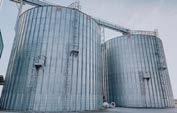
Yestimun® by Leiber
Yestimun® is a natural 1,3/1,6-beta-glucan extracted from the brewers’ yeast cell wall. It is made from high-quality Brewers’ Yeasts (Saccharomyces cerevisiae) with the natural component like barley, hops and water. Yestimun® is a light beige-coloured, fine, spray-dried, powder with no taste or odour of its own. For that reason, the dispersible ingredient can easily be used in a wide range of dry or even liquid product formulations. Because of this, the dispersible ingredient can be easily used in diverse dry or even liquid product formulations. Leiber Brewers´ Yeast beta-glucan is characterised by a very high level of purity and a unique molecular structure. Its highly immune-supporting effect has been proven on the basis of human studies.
Benefits include:
Can be taken daily
Free of side effects
Efficacy proved by studies
www.aggrowth.com
mymag.info/BRey
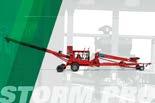
Roller belt conveyor by CESCO
CESCO roller belt conveyors RBCM are designed with a flexible concept and modular design, for gentle horizontal or slightly inclined conveying of grain, grist, pellets, and granular products in general. They realise the completely closed conveying of the product, even in reversible mode, with zero loss during the conveying, easy cleaning, maintenance, and safety during operation thanks the fully bolted system used.
General characteristics
Drive station equipped with belt scrapers.
Tensioning station equipped with belt screw tensioner up to 60 m length and with counterweight tensioner for longer configurations.
The belt runs on 2-roller or 3 roller transoms and is permanently cleaned by internal and external belt scrapers. Trippers available for applications with multiple unloading stations running along the conveyor frame.
Watertight outer top cover made by hot dip galvanised corrugated steel sheet, suitable for outside installation and fixed by bolts.
Kosher and halal-certified, nonallergenic and GMO-free Suitable for vegetarians and vegans
Already used in hundreds of products worldwide
https://yestimun.d
mymag.info/FHPV
Crusher CR from Tietjen

The crusher CR is a versatile machine for coarse crushing of bulk materials. It is suitable for crushing agglomerates or for pre-crushing coarse material pieces for further grinding.
By homogenising the raw material in the crusher, energy is saved in the further grinding in the hammer mill, as the desired grain spectrum is achieved more quickly. At the same time, the screens of the hammer mill are protected against screen breakage. Especially in pet food and fish feed production, particularly fine screens used, here the use of the crusher is particularly worthwhile.
The crusher is designed for continuous industrial operation. It convinces with its robust design with generously dimensioned inlet, long-life rotor and hardened impact plates. The beaters are also optimised for primary crushing and are made of Hardox. A variable grain size range can also be achieved in pre-shredding by using different screen sizes.
www.grainsystems.com
www.cesco-group.com
mymag.info/LldA

www.tietjen-original.com
mymag.info/oxWT
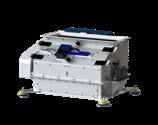
36 | April 2024 - Milling and Grain
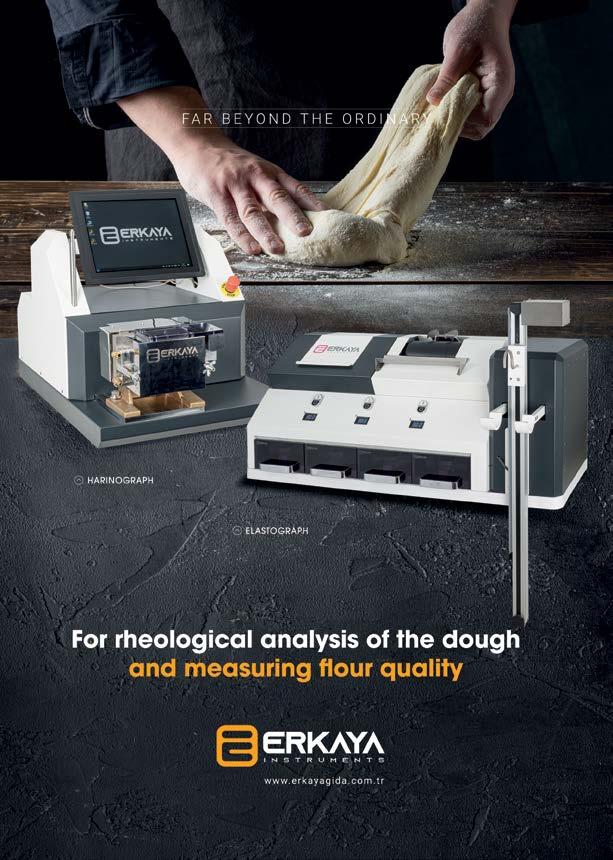
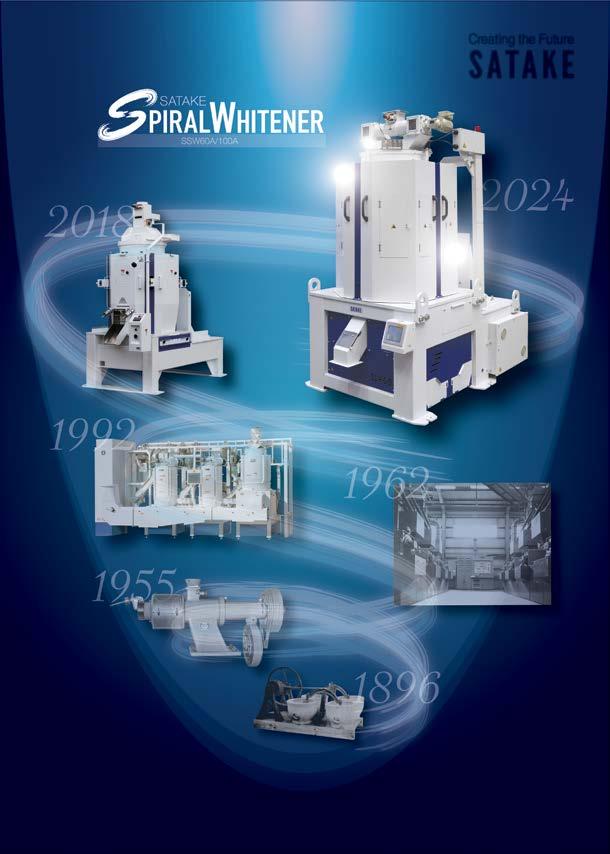
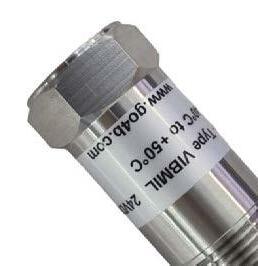
Vibmil Vibration Sensor
Revolutionising industrial vibration monitoring
4B Group has unveiled their latest innovation, the Vibil Vibrator Sensor (VibMil), a condition monitoring solution designed for continuous monitoring of vibration levels and temperature in industrial environments and hazardous areas up to ATEX/IECEx Zone 20 and Class II Div 1.
VibMil is a current loop-powered accelerometer, delivering precise vibration RMS velocity readings through a 4-20 mA output. Encased in a robust stainless-steel enclosure with a 3/4″ NPT thread for conduit connection, VibMil assures durability in the harshest industrial conditions. For added versatility, it can be supplied with optional inbuilt NTC or PT100 temperature sensors. Designed with ease of use in mind, the VibMil. comes equipped with a female 1/4″-28 UNF mounting thread, allowing secure attachment using screws, studs or mounting studs. Optional converts to M8 and M6 male threads provide additional flexibility. Integration into control systems is
seamless, thanks to the 2-wire, loop-powered accelerometer, providing linearised output from 4 – 20mA, proportional to the sensor’s measuring range.
“The VibMil has been designed with our core markets in mind”, explains Sam Payne, 4B Group CTO for electronics. “The mandatory requirement to have ATEX/IECEx/Class II Div 1 approved products within dust hazard location means that many similar products on the market are not suitable. The VibMil can be installed with confidence within the most demanding dust hazard areas. Also, the added temperature sensor option means the condition monitoring applications which were previously surface temperature only, can now add that extra level of analysis and visibility of the running state of a machine.”
The VibMil Vibration Sensor sets a new standard in industrial vibration monitoring, providing reliable and accurate data to optimise performance and ensure equipment longevity.







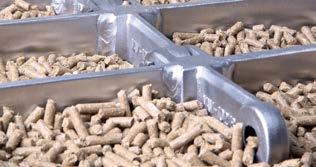
FOCUS Special
Elevator parts Conveyor chains www.vav.nl contact@vav.nl +31(0)71 40 237 01 Milling and Grain - April 2024 | 39
ai-lati.com


simaimpianti.net
BEYOND MAKES US SEE KNOWLEDGE THE HORIZON



ocrim.com
paglierani.com

Nutritional Challenges
ENHANCING THE VALUE OF FLOUR IN COMBATING MICRONUTRIENT DEFICIENCIES
Although the enrichment of foods dates back to ancient times, the principles governing this practice were established through regulations in 1987. This regulation outlines three different purposes for the addition of nutrient elements to foods. The first, known as ‘restoration’, involves replacing lost nutrients during processing, storage, and transportation. The second, termed ‘standardisation’, refers to adding missing nutrient elements to products similar to some traditional foods. The third is ‘fortification,’ involving the addition of deficient nutrient elements to foods in cases of mandatory nutrient deficiencies.
Fortification practices are regulated by the Food and Drug Administration (FDA) in the United States. The FDA’s fortification policy permits the addition of only mandatory nutrient elements. Additionally, the added nutrient quantity must not exceed the approved nutrient supplement level or exceed the Generally Recognized as Safe (GRAS) level.
Micronutrient deficiencies
Globally, over two billion people suffer from micronutrient deficiencies!
Contemporary issues related to healthy nutrition, a fundamental human right, include various problems. Among these, micronutrient deficiencies and inadequate nutrition issues such as stunting, dwarfism, and weakness are widespread worldwide. Micronutrient deficiencies represent a global public health
problem, indicating the absence of essential micronutrients in the body. The most common micronutrient deficiencies include iron, folate, vitamin A, zinc, and iodine deficiencies. These deficiencies can lead to slowed growth and cognitive development, decreased intelligence, perinatal complications, and increased morbidity and mortality. Women of reproductive age and children under five are more affected by micronutrient deficiencies due to their higher micronutrient needs.
The fact that more than two billion people globally experience micronutrient deficiencies highlights a significant and attentionworthy public health problem, and food fortification is seen as a crucial intervention.
Food fortification can be rapidly implemented, with its benefits quickly realised; it is also a safe and cost-effective method for communities at risk of micronutrient deficiencies. The fortification of staple foods can make a significant contribution to combating hidden hunger globally, addressing the issue of nutrient-poor diets.
Adding value to flour in the fight against micronutrient deficiencies
Turkey, the genetic centre of Anatolia, has been home to the world’s first settlement, Göbeklitepe, near Urfa, for 12,000 years. As the world’s largest flour exporter since 2025 with a 21.1 percent share among 150 countries, Turkey plays a significant role in the distribution of enriched flour and combating global malnutrition. Modern humans’ first source of nutrition, flour, is produced through the milling process of grains. Wheat and flour production, the most crucial activity in the country’s economy related to agriculture and food sectors, carry substantial
42 | April 2024 - Milling and Grain F MAXIMISED FLOUR MILLING






120.000 TONS G R O U P ELECTRIC MOTORS & GENERATORS
importance in terms of production, labour force, environmental impact, sustainability, and socioeconomic aspects.
Wheat and corn, in their natural state, may lose a significant portion of essential vitamins and minerals during milling processes. Therefore, adding some of these micronutrients back to the milled flour is referred to as flour fortification. The added nutrients include:
Iron: Vitamins and minerals used in fortification are vital to prevent health disorders associated with nutrient deficiency, such as anemia (iron deficiency), affecting approximately 2 billion people globally.
Zinc: Zinc is essential for supporting the immune system and cellular functions. Fortifying flour can reduce the risk of zinc deficiency. Enriching 100g of grain with 20 ppm of zinc can provide children with 20 percent of their daily zinc requirements.
Folic Acid: Particularly important during pregnancy, folic acid added through flour fortification can reduce the risk of neural tube defects.
B Vitamins (Thiamine, Riboflavin, and Niacin): B vitamins are crucial for energy metabolism and nervous system health. Fortification aims to prevent deficiencies in these vitamins. Especially, fortifying flour with B vitamins protects against neurological damage.
In some countries, flour fortification may also include other nutrients such as Vitamin A, Calcium, and B12. These additions aim to support general health and prevent nutritional deficiencies.
Bastak’s solution
Bastak Instruments, the first and only accredited laboratory in the country approved by the Ministry of Industry and Technology, serves with its 90 specialised branches and more than 265 expert
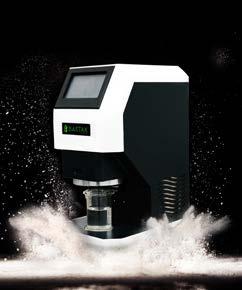
personnel in its 5-star research and innovation
centre. With our state-approved Additive Production License, Ministry of Agriculture and Forestry Operation Registration Certificate, and Ministry of Health Production Permit Certificate, we provide flour fortification solutions worldwide, adding health and flavour, and tirelessly working for the health of future generations!

SCE.BE Milling and Grain - April 2024 | 45 F
A SQUARE APPROACH FOR A WORLD WITHOUT FOOD WASTE. DISCOVER OUR TAILORED SOLUTIONS ON OUR WEBSITE

Ridding the industry of Methyl Bromide and Sulfuryl Fluoride
While often overlooked by the general public, logistics is our industry’s key operational competency, ensuring a dependable and sufficient supply of food to populations across the world. For staples such as wheat and other grains, the ability to transport and store product reliably and safely is critical to global food security and stability Geopolitical shocks, extreme weather events, and outbreaks of destructive pests can all disrupt these precious supply chains, with potentially catastrophic results on the availability of the food we need to feed an ever-growing population.
To be ready for the first two risks, farmers, growers and the supply chain often perform unsung feats of mastery to re-balance existing routes to market around a blockage or re-negotiate supply contracts to fill a specific need. However, to protect against the third risk, which can be just as complex, fumigation is an essential safeguard.
During the journey from farm to fork, across and within borders, which often sees drastic changes in the surrounding environment, fumigation takes place at multiple points to keep storage facilities free of invasive pests. However, with the most commonly used chemicals for fumigation lacking effectiveness or having a severe environmental impact, industry is now looking for new solutions to ensure that feeding a global population is not contributing to the same extreme climate change events that we have been experiencing ever more frequently over the past few years.
Fumigation – a structural part of the industry
As grain travels throughout the supply chain, it is vulnerable to pests including insects and rodents. According to the United Nations Food and Agriculture Organisation, around 40 percent of the food produced annually is lost due to pest infestations. Fumigation is essential to provide the safe storage and transportation of these commodities and takes place in grain silos as well as ship holds. On average, grain silos should be fumigated every six months to ensure a pest-free environment. As well as protecting natural flora and fauna; fumigation also plays a crucial role to promote global food security. The world is increasingly reliant on efficient, cost-effective, and uncontaminated food supply chains. Amid a more challenging
climate and exponentially rising demand for food, fumigation to guarantee safe storage for bulk commodities like grain becomes ever more crucial.
Historically, the pest control industry has relied heavily on the chemicals methyl bromide and sulfuryl fluoride for its fumigation needs, but scientific analysis of their environmental impacts is prompting industry and regulators to seek out alternatives.
The go-to fumigants have an unacceptably negative environmental footprint
Methyl bromide, once the go-to fumigant, is a toxic ozonedepleting substance. Its reactivity in ozone depletion is more than 50 times greater than bromine, and evidence suggests its use has resulted in conditions including cancer and paralysis for applicators and neighbouring communities where fumigation takes place.
In fact, estimates suggest that every kilogram of methyl bromide used destroys about 4.2 tonnes of ozone. Recognising this threat, the Montreal Protocol, an international treaty, was agreed in 1987 to protect the ozone layer by phasing out methyl bromide by 2015. Some countries, including Canada, the United Kingdom as well as the European Union’s Member States have banned its use altogether within their borders. However, many countries continue to use it under quarantine exemptions, with alarming increases in its use noted in nations including Australia, China, and India for this purpose in recent years.
Searching for an alternative to methyl bromide, industry has shifted heavily towards the use of sulfuryl fluoride as an alternative. While effective, sulfuryl fluoride presents its own risk to the climate. A synthetic greenhouse gas, sulfuryl fluoride has a Global Warming Potential 4600 times that of carbon dioxide. Approximately 1000 tonnes of sulfuryl fluoride are used annually in Europe alone, resulting in emissions equivalent to 4.5 million tons of CO2, leading to renowned climate scientist Susanne Götze to label sulfuryl fluoride a ‘climate killer’.
Despite the recognised environmental harms of both methyl bromide and sulfuryl fluoride, their use in fumigation falls outside the regulatory frameworks of major environmental agreements like the Kyoto Protocol or the Paris Agreement. Currently, there are no global targets for reducing emissions from these chemicals. As a result, around 11,000 tonnes of methyl bromide and 3000 tonnes of sulfuryl fluoride continue to be used each year, contributing to the worsening climate crisis.
While historically considered to be a preferred alternative to methyl bromide, sulfuryl fluoride is now under pressure from
46 | April 2024 - Milling and Grain F

A reliable team for a reliable project YOUR

55 million m3 built Projects in 150 countries
New pendular and rotative sensors
ATEX 20 certified, the zone with the highest risk
· SY-DP1 Pendular . Robust and simple. It does not require power and maintenance.
· SY-DR1 Rotative . Sensitive. It has 2 operating modes depending on the density of storage material.
Top Project worldwide


Flexibility and adaptability
symaga.com • +34 91 726 43 04 • symaga@symaga.com
RELIABLE PARTNER



Your Team for Great Flour















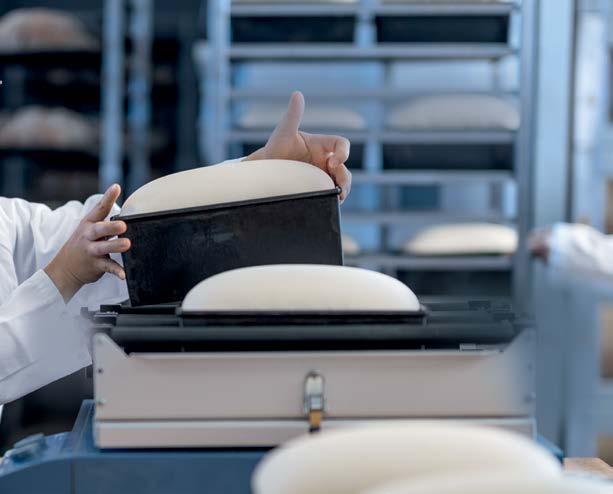

The Flourists, Part 5: Baking Technology
Protecting Baking Traditions through Innovative Ideas.




Baking industry demand for suitable ours is rising globally, and we’re supplying highly speci c answers. Developers of individual our treatment concepts: The Flourists, an interdisciplinary, worldwide networked team of experts who put their all into adapting our characteristics to the requirements of local baking ap-


plications. Thanks to our regional Technology Centers, customers get unique our additives developed locally, that are designed speci cally for local baking traditions and varying grain qualities. The result: Diversity in baking culture and consistently good baking quality in ours, for professional and home use. #the

ourists
muehlenchemie.com
regulators, especially in Europe. Last year, some EU Parliament legislators negotiating a new Fluorinated Gases Regulation called for sulfuryl fluoride to be banned. An outcome on this Regulation has still not been reached. And amid a cold snap at the turn of the year, authorities in some German states prohibited the use of sulfuryl fluoride at low temperatures due to concerns about its effectiveness, disrupting the international timber trade and causing huge backlogs at European ports.
With governments across the world imposing more stringent sustainability-related rules and obligations on business, there is now significant pressure from regulators and investors for companies to show their activities are compatible with a net zero future. There is increasing pressure on suppliers, at all levels of supply chains, to account for their carbon footprint, including their associated emissions.
Facing these challenges, the grain industry is now urgently in need of alternative options.
What are the alternatives?
While methyl bromide and sulfuryl fluoride are not the only available treatments for fumigation, there is not yet a clear alternative.
Options such as phosphine – widely used in the grain industry – as well as heat treatment, do not have the same environmental impact as methyl bromide and sulfuryl fluoride. Some countries are also actively exploring integrated pest management systems, which relies on an understanding of pest ecosystems and the changing seasons to maintain control of potential threats.
However, for all alternatives, effectiveness is king. Resistance to phosphine is being increasingly observed in some pest species. Heat treatment faces similar efficacy challenges, and in an environment of inflated energy prices, can be cost-prohibitive. Integrated pest management is 100% chemical-free, but also highly vulnerable to changes in the natural world, increasingly a problem amid a more volatile climate.
Regulators under pressure
The lack of focus from global policymakers and regulators on the environmental impact of fumigation, which is absent from any discussions in the COP process, makes life harder for an industry in need of new alternatives.
Registering a new fumigant is a challenge. Despite the known climate harm caused by traditional products, regulators often
drag their feet, resulting in a lengthy and onerous process, requiring broad and deep data sets on issues such as efficacy and environmental impact.
These same regulators more or less hold the keys to the kingdom on fumigation and so some industries are calling on them to speed up the process of registration of alternatives. As noted by The Methyl Bromide Technical Operations Committee at the UN, there is some progress on access for alternative solutions. Along with strong evidence, the backing of supply chains reliant on such products is a critical component for supporting the registration of new products.
A way forward?
Regulators in some countries, particularly those where the agricultural sector is especially important, are seeking environmentally sustainable alternatives to methyl bromide and sulfuryl fluoride. For example, in 2023, Australia registered hydrogen cyanide, a highly effective and environmentally sustainable replacement for both products for the milling and grain industry. Hydrogen cyanide is also registered in the EU, South Africa, Malaysia, and New Zealand.
In addition, and whilst not directly attributable to the milling and grain industry, both New Zealand and Uruguay’s Governments and forestry sectors aligned in opposition to methyl bromide, prompting regulators to register and approve Ethanedinitrile (EDN) as an effective, environmentally sustainable, alternative treatment for forestry products. This signals a growing industry shift towards responsible and sustainable treatment solutions.
Other countries are also exploring alternatives to the major legacy products. Yet with access to alternative products dependent on governments and regulators supporting registration and commercialisation, the voice of industry – specifically, end users – is crucial. As such, the grain storage and transportation supply chain must drive its own access to new, environmentally sustainable, alternatives by communicating the challenges and needs to decision-makers.
There is more focus than ever before on the environmental impact of supply chains and this is expected to increase. Unless new, effective and less environmentally harmful solutions are made accessible, the grain industry will continue to find itself in a difficult position. The choice, between being a laggard on sustainability, or risking the security of critical commodities, is not one our industry will want to be forced to make.

Milling and Grain - April 2024 | 49 F

ASYNCHRONOUS MOTORS: Drive belt versus direct drive
by Thomas Ziolko, Head of Product Management Wheat & Rye & Remo Friedrich, Mechanical Development Engineer, Bühler, Switzerland
In a modern flour mill, hundreds of machines are in operation, the vast majority of which are equipped with electric drives. Choosing the right type of motor and the right overdrive is vital for the efficiency, operational reliability, and maintenance requirements of the relevant application. For some years now, leading machine manufacturers have been using direct drive for some of their machines. Until now, large plansifters were an exception. They continue to be driven by an asynchronous motor with belt drive – for good reason.
Quod licet jovi non licet bovi – what is permissible for Jupiter is not permissible for cows. Even the Romans knew that it can be a good idea not to treat two things in exactly the same way. If this principle is applied to the drives of the machines and equipment in a mill, this means that what is suitable as a drive technology for a roller mill is not necessarily the best solution for a plansifter
Advantages of direct drive
The electric motor plays a central role in flour milling. Various versions of this type of motor are used with extremely diverse overdrive systems at every stage of the milling process, from the intake of raw materials through to the bagging of the end products. Over the last ten years, leading mill builders have successively replaced the classic asynchronous motor with belt drive in their machines with a direct drive or gear motor. Today, these new drive systems are mainly used to operate bran finishers, impact detachers, and modern roller mills, for example. These solutions can be divided into three categories.
Asynchronous motor with gear system
In relation to a belt drive, a mechanical gear system has a slightly higher efficiency of around 98 percent. It is also easy to maintain and comparable in price to a belt drive. However, the high efficiency of the gear system is offset by restrictions in terms of machine design. In addition, explosion protection approval causes problems for gear units with high power and low speed.
Direct drive with asynchronous motor
An asynchronous motor with direct drive has no loss of power in overdrive because the power is transmitted directly to the machine. For the most part, standard motors are used. These are available worldwide, operate efficiently, require little maintenance, have an impressively long service life, and undergo low wear.
The nominal speed of the motor must be considered in the design. If the required machine speed is outside the nominal speed, a frequency converter must be used. In addition, larger motors must be selected for lower speeds. This applies to motors used with a frequency converter as well as to motors with low nominal speeds.
Direct drive with synchronous motor
A synchronous motor with direct drive has several advantages over an asynchronous motor. It works even more efficiently and is considerably more lightweight for the same level of power. In addition, it is available in various designs, which facilitates its integration. The disadvantages are its high price and the power electronics that are vital for its use. Synchronous motors are rarely available as a standard product across multiple manufacturers. Worldwide availability is therefore not guaranteed. Finally, the required certifications (e.g. ATEX) are also difficult to obtain.
50 | April 2024 - Milling and Grain F







Behlen bins range in size from 85 to 66,000 cubic meters. These silos feature a unique trapezoidal wall panel design. COMMERCIAL GRAIN BINS Behlen hoppers are designed to ensure strength, ease of assembly, and trouble-free operation. COMMERCIAL HOPPER TANKS Behlen Steel BUILT TO LAST Behlen Grain Systems... Standing the test of time with competitive prices and Customer Service second to none. CONTACT US TODAY TO DISCUSS YOUR PROJECT! Call 1-402-564-3111 or Visit www.behlengrainsystems.com Bigger and Better than Ever!
Plansifters: the asynchronous motor in pole position
The principle of the free-swinging plansifter was developed in Germany as early as 1895. It consists of two sieve modules with a centrally placed flyweight. Thanks to this arrangement, plansifters can be suspended and allowed to swing freely. Although this option has been used for many years, after a thorough analysis of the entire system, Bühler’s engineers are convinced that for the classic plansifter, the asynchronous motor with belt overdrive is still the best choice.
The process and forces necessary to get the plansifter swinging and then keep it going can be compared to the journey of an airplane. A tremendous amount of energy must be available to launch the aircraft. However, once it has reached altitude, it switches to the most efficient type of operation possible. The situation is very similar with a plansifter. The sifter must reach nominal speed within a very short time. Otherwise, there is a risk that it will build up deep resonance. A plansifter therefore requires a very high torque “on take-off”. In “flight” mode, i.e. once the machine is running continuously, on the other hand, it consumes very little energy as a “free-swinging” device, since it never brakes or accelerates. The loss of energy due to transmission to the mill structure is also negligible, since the plansifter is suspended and allowed to swing freely. Until it reaches nominal speed, an asynchronous motor provides up to three times more torque than when in continuous operation. Consequently, this type of motor is predestined for the “take-off and flight” of the plansifter.
Plansifters: a belt drive as the best solution
But what is the ideal way to transfer force to the sifter? As extensive tests have shown, a belt drive is the optimal choice


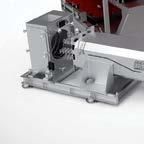







Milling and Grain - April 2024 | 53 F
for the connection between the motor and the sifter. Even if the energy efficiency is slightly lower when transferring force via the belt, there are still various advantages over a direct drive. This is due to the chosen application and the existence of straightforward supply chains for spare parts and maintenance. Belts are simple, standardized components that are available worldwide in high quality. A belt overdrive allows a high gear ratio, which makes it possible to use smaller and hence inexpensive motors. The electrical installation in the plant can be simplified accordingly. Maintenance is very straightforward and can be easily ensured by trained personnel. The belt drive also has advantages with regard to the construction of the plansifter. By design, the belt allows a certain distance to be maintained from the motor flywheel. This means that the motor can be installed where it does not take up valuable space.
Plansifters: energy consumption is secondary
The ever-increasing cost of energy is a challenge in the modern milling industry. Discussions on this issue focus on achieving the

lowest possible energy consumption. This is a very important debate. But the overall view of the energy management of a flour mill is just as important.
In which production step is the highest total power required?
Definitely not during sifting. Depending on the design, a plansifter consumes 20 to 30 times less energy than the associated roller mills. Taking an everyday example, a plansifter compartment consumes less energy than a vacuum cleaner on medium speed. The associated roller mill consumes about as much as 20 vacuum cleaners being used on high speed at the same time.
This example illustrates why, for large plansifters, the advantages of the asynchronous motor with belt drive far outweigh the disadvantage of slightly lower efficiency. It goes without saying that every opportunity is taken to further reduce the energy consumption of the plansifter drive. For example, by using asynchronous motors with a higher efficiency class.
Bühler has switched to direct drive or gear motors as its choice of drive systems for various grain processing machines. In large plansifters such as the Sirius MPAK or the Arenit MPAV, on the other hand, an asynchronous motor with belt transmission has been used for decades, even though a direct drive with synchronous motor including power electronics would be a possibility.
The advantages of an asynchronous motor with belt drive are obvious and convincing:
- Solution is not dependent on a specific provider
- A technically very robust system
- Very high energy efficiency
- Straightforward and fast availability worldwide
- Cost-effective procurement of components
- Favourable storage and easy maintenance
Outlook
The plansifter is one of the most important process machines in a flour mill. A failure can very quickly led to a complete downtime of flour production. As a supplement to regular maintenance, Bühler is working on solutions featuring state-ofthe-art sensor technology that give early warning in the event of a motor failure, overheated bearing, fluctuating loads on sieve compartments, or incorrect belt tension. In contrast to today’s solutions, this “continuous monitoring” guarantees that those responsible for maintenance will be notified early on, sometime ahead of a potential failure. Components can then be replaced in a scheduled manner without risking an unplanned shutdown.
For more information please contact us at milling@ buhlergroup.com or visit www.buhlergroup.com



BOURNE AES R C H & RECRUITMENT SELE C T I NO � CHIEF COMMERCIAL OFFICER � GENERAL MANAGERS � MANAGING DIRECTORS � CHIEF MILLERS � FEED & POULTRY MANAGERS � MAINTENANCE MANAGERS � R&D NEWPRODUCT DEVELOPMENT � SALES & MARKETING � PLANT MANAGERS � CFO’S ���� bournerecruitment.co.uk ���� +44 7764 465 897 THE EXPERT IN FEED, FLOUR MILLING AND FOOD PRODUCTION RECRUITMENT POSITIONS RECRUITED: RECRUITING GLOBALLY 54 | April 2024 - Milling and Grain F
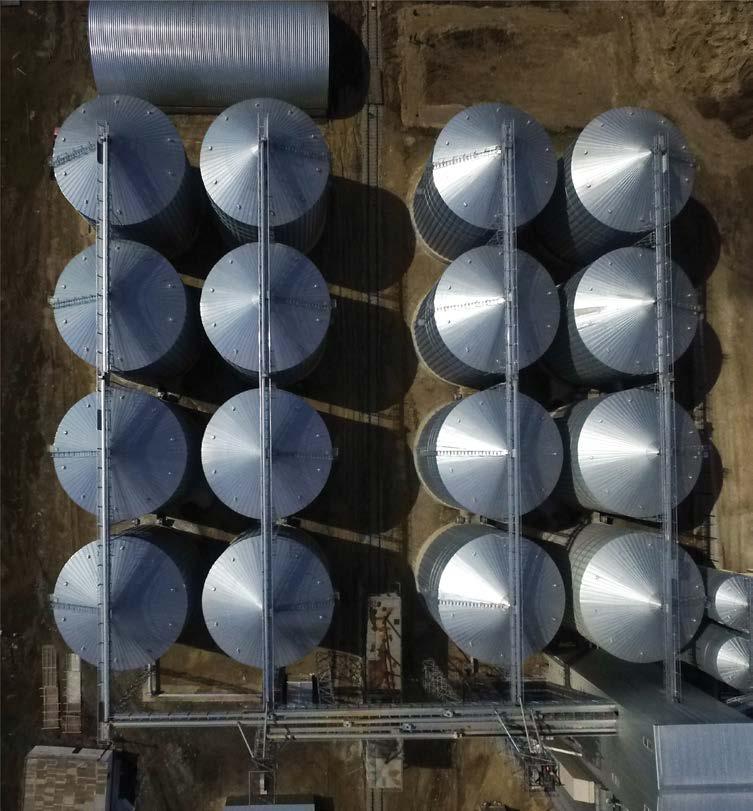

The ancient heritage of grain processing
 by Mehmet Ugur Gurkaynak, Milling and Grain, Türkiye
by Mehmet Ugur Gurkaynak, Milling and Grain, Türkiye
Stretching along the spectacular coast of north-east Africa, Egypt is surrounded to the north by the cool waters of the Mediterranean Sea and to the east by the mystical waves of the Red Sea. Its history dates back thousands of years, from the time of the Pharaohs to the legendary Great Pyramids of Giza, and is admired around the world. Strategically located as a bridge between northeast Africa and the Middle East, Egypt has been a meeting point for different civilisations throughout history. This important position was further enhanced by the construction of the Suez Canal, making it the meeting point of Africa, Europe and Asia. Combined with the fertile Nile River delta, Egypt has been engaged in agriculture for thousands of years and has been home to industries such as grain, livestock and poultry farming thanks to its fertile soils.
The art of grain processing in ancient Egypt
During excavations in Egypt, archaeologists have found drawings dating back thousands of years and have determined that mass production techniques were used in these drawings. In these drawings, the milling and cooking processes were depicted in detail. For centuries, wheat has been processed to separate the outer bran and germ from the more digestible endosperm inside. Evidence from excavated villages dating back to 6700 BC shows that stones were used to grind wheat. In addition to beating or rubbing the grain, pairs of stones were used. The wear caused
by the stones rubbing against each other created pits, leading to the evolution of simple mills. The ancient Egyptians used saddle stones, as shown in wall paintings in tombs along the Nile River and made various leavened breads by mixing sifted flour with natural yeast. Over time, arms were added to the millstones to increase the grinding power. Neolithic Egyptian society produced a variety of breads using emmer wheat, shell grains and even different types of millet. The grains were preserved in beehiveshaped storage silos for use when needed, and then ground with hand mills on flat stones and baked in ovens or heated clay moulds. Both men and women collaborated in bread-making, with men usually carrying out various tasks and women usually doing the milling. In tombs from the late Old Kingdom and early Middle Kingdom periods, female figures have been found grinding grain. To grind grain, a handful of grain was placed on a stone hearth with a slightly curved surface. The grain was ground into flour by rolling a rolling pin-shaped stone with a curvature appropriate to the grinding surface back and forth, and this flour was collected in a container at one end of the vessel.
Around 3000 BC, the ancient Egyptians discovered yeast. Using the heat of the sun, they prepared a dough mixture with yeast. They subjected this mixture to a fermentation process and, after baking, obtained a soft loaf of bread. By mastering this process, they were able to produce over forty different types of bread. The miller used to kneel on the ground and grind flour with a large hand mill; later, in the Middle Kingdom, the milling process was carried out on looms.
From the ancient times of Egypt until today, bread has been an

56 | April 2024 - Milling and Grain F

Is your herd ready for tomorrow?
Preparing for a more sustainable future demands a proactive partner with insights, innovative solutions, and precision services. One who can help you save costs and get the most value from locally sourced raw materials while reducing environmental emissions — all without ever compromising on performance. Our specialists on the ground work closely together with you to help shape a strong future for you and your business. Reduce waste, optimize pig performance, and step up to the circular economy — because sustainable farms are more efficient farms.
SUSTAI NABLE COST
RAWMATERIALS
EMISS IONS CONTROL
Learn more at dsm-firmenich.com/anh
$ $
SAVINGS

important part of the daily diet for Egyptians, rich and poor alike. A key element on the tables of the ancient Egyptians was the indispensability of bread, especially for the working class. Bread was prepared with flour made by grinding raw grains, mainly barley or emmer wheat. Although bread made from emmer wheat was common, it was more difficult to process than other wheat varieties. Hieroglyphic records reveal the existence of 14 different types of bread, including whole wheat pita bread and sourdough bread.
Rich heritage
Ancient Egyptians usually ate leavened bread at home and favoured different types of bread for temple festivals and special occasions. During the construction of the Pyramids of Giza, workers were given bread and beer as payment. In today’s Egypt, the staple bread consumed by most people is a modern version of the bread eaten by their ancestors thousands of years ago and is made from whole wheat.
Hieroglyphs and wall paintings show that the ancient Egyptians were pioneers in the production of yeast. This yeast was used to make leavened bread. In addition, the bread-making knowledge was also used to make an acidic beer drink from a lightly cooked germinated grain loaf. Another method was to mix cooked and uncooked malt with water and strain it before inoculating it with yeast.
Grain mills in Egypt are an important part of Egypt’s rich heritage. However, the mill found at the archaeological site of El-Tarqah, used for grinding grain for more than three thousand years, is one of the oldest and most recognisable. In addition to the animal-powered mills in the Dakhla Oasis, there are several
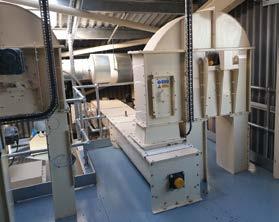


other animal-powered mills in Rashid City, north of Cairo, such as the twelfth-century Abu Shahin mill, founded by Osman Agha al-Tobji.
In the mud-brick dwellings of the Dakhla Oasis, the grinding of grain has been carried out since ancient times. To make bread, women used a mortar, a bowl made of local palm wood, and a pestle, a long stone made of acacia wood.
Later, hand mills came into use. The hand mill is one of the simplest tools in the world and is known from examples found in Egyptian tombs, which are exhibited in the Gizeh Museum in Egypt. These tools worked by placing a round, flat stone on top of another stone and operating it with human power. Some of the ancient hand mills found in the Dakhla Oasis still exist. These mills, built during the Mamluk and Ottoman periods, were usually made of hard stones; the upper stone was usually convex, 98 cm in diameter, 20 cm thick and had a hole in the centre with a
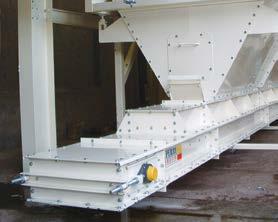

Visit us online at www.perryofoakley.co.uk sales@perryofoakley.co.uk +44 (0)1404 890300 Perry of Oakley Ltd. The UK’s Most Experienced Manufacturer of Bulk Drying, Handling & Storage Equipment Twin Trace Conveyors | Belt Conveyors | Screw Conveyors Flat Bottom & Hopper Bottom Silos | Square Bins Milling and Grain - April 2024 | 59 F
diameter of 11 cm, while the lower fixed stone had a wooden nail in the centre.
The grinding process in the Dakhla Oasis was modernised during the Ottoman period with animal-powered mills. The Abu Ishmael mill in the town of Al-Qasr was built as a symbolic structure in 1198 AH to serve the population under Turkish rule. There is also the Sheikh Ahmed Mill and the El-Prens Mill, one of the largest mills in Balat village. The millstone used in this mill is one of the largest millstones in the Dakhla Oasis. The mill was used for flour production and was built in the 4th century AD, as evidenced by the wooden beam at the entrance.
Fertility of the Nile River: Sowing and Harvesting Techniques of the Ancient Egyptians
The first step in sowing grain is to prepare the soil and break up the ground so that the seed can be covered. The most primitive tool used for this purpose was probably a sharp digging stick or a sharp stone attached to a handle. Egyptian drawings show the use of a triangularshaped tool made by joining two sticks. The longer stick served as a handle and the shorter one as a knife; this tool was used for chopping or hoeing.
To sow wheat seed in the soil, the ancient Egyptians usually sowed the seed directly into the mud left behind by the annual floods of the Nile. Cattle were ploughed over the area to embed the seed in the soil. For harvesting, ancient Egyptians made sickles of sharpened flint and mounted them on wooden stalks. The harvested wheat was then dried in the sun, sorted, sieved and finally milled. The grains were first sorted and soaked, then placed on a grinding stone in a rehaa. During the grinding process, the stone rolled back

and forth and the wheat was ground into flour, which was collected in a container at one end of the vessel. Archaeological excavations and ancient Egyptian hieroglyphs show that the first grinding tools were wooden or stone, and later metal mortars in which the grains were crushed by impact.
Later, Egyptians began to grind grain between two large flat stones, which were powered by animal power for the grinding process. These stones were grooved or chipped to allow fine flour particles to escape. Grinding mills soon began to harness the power of running water to turn the wheels. Once the grain was milled, it was transferred into baskets and stored. A record-keeper counted and recorded the number of baskets before the grain was transferred to the granary.

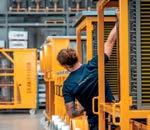

• Protection against insects & fungi
• Without chemical treatment
• Short amortisation period
• Independent of ambient wheather
• Low energy demand
• No respiratory losses The natural way of grain preservation
frigortec.com Made in Germany GRANIFRIGOR™ Grain cooling 60 | April 2024 - Milling and Grain F

































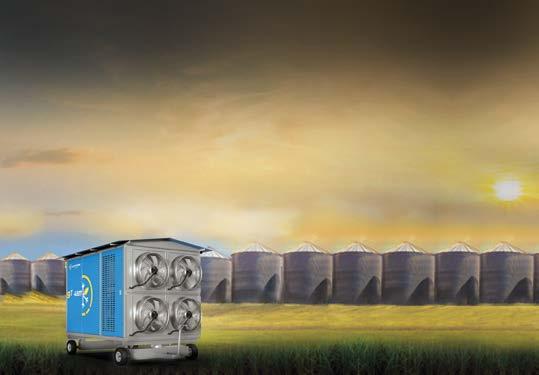









World Leaders in Microwave Moisture Measurement Oil Animal Feed Coffee Rice Grain Hydro-Probe XT Hoppers, chutes, belt conveyors Hydro-Mix XT-FS Mixers, conveyors, Ducting System Hydro-Mix XT-EX Certified for use in ATEX, IECEx and NEC/CSA Hazardous Locations (Dust) Hydro-Mix HT-EX Mixers, conveyors, Ducting System, High Temperature Non Food-Safe available Non EX available Non EX available enquiries@hydronix.com Contact us for more details hydronix.com Hydronix-Milling and Grain-Advert Mar 2023 215x140mm.indd 1 28/02/2023 13:55 Milling and Grain - April 2024 | 61 F
COMBAT RAW MATERIAL NUTRIENT VARIABILITY AND BOOST PROFITS WITH NIR
 by Markus Wiltafsky-Martin, Director Service Commercialization, Evonik Animal Nutrition, Germany
by Markus Wiltafsky-Martin, Director Service Commercialization, Evonik Animal Nutrition, Germany
It is no secret that animal protein producers’ profit margins have been dwindling in recent years. Concerns within the agriculture sector have regularly hit mainstream news headlines around the globe. A perfect storm of geopolitical issues, the Covid pandemic, supply chain issues, and the war in Ukraine, have made for highly volatile raw material costs, pushing up the cost of production. All the while, demand for animal protein is rising, consumer focus on sustainability is increasing and the push for industries to reduce carbon emissions is greater than ever.
So how can the animal protein business be kept profitable? One approach that can lower costs, increase animal efficiency and support sustainability and environmental goals, is managing feed nutrients to formulate low-protein diets.
Feed is the biggest cost in livestock production, making up 50-70 percent of total outgoings. Among the costliest components of livestock feed is protein. Dietary protein over-supply and unbalanced diets are linked to metabolic stress and excessive nitrogen excretion. Low-protein diets with targeted amino acid (AA) supplementation have been shown to maximise growth, performance, profitability, and lower environmental impact.
Studies consistently show that each percentage point of crude protein reduced from the diet leads to an equivalent reduction of about 10 percentage points in nitrogen excretion. To achieve this reduction, an accurate understanding of the feed’s nutritional profile is of up most importance. That is why precise analysis of the quality of ingredients used in feed should be an essential part of any feed strategy.
Quality control
Precise nutrition can ensure optimal animal performance and productivity – and consequently, better return on investment. Optimising feed composition is a proven way to significantly influence animal health, meat yield, meat quality and carbon emissions. The challenge, however, comes in the variation in nutritional contents within raw materials, which can sometimes be significant; in finished feeds, raw materials are responsible for up to 70 percent of variation.
Variability is a particularly pertinent concern when we look to regions of the world experiencing unprecedented weather conditions, including floods, droughts and extreme temperatures, which heavily impact raw material quality.
Not having the tools to accurately measure and analyse the nutritional composition of raw materials can lead to overcompensation and oversupply in the diet. Surplus AA and crude protein content leads to potentially compromised animal health and increased nitrogen excretion, increasing emissions per animal.
Oversupply of nutrients also equates to an increase in cost because of unnecessarily high dietary inclusion rates of expensive proteinrich raw materials. Whereas, determining the precise nutritional composition of feed ingredients allows feed millers to formulate feeds which perfectly meet the needs of the animals. In addition, it lays the basis to make better purchasing decisions.
This is where quality control comes in. Traditionally it is something that has been carried out to catch products that are not up to specification. Today near-infrared spectroscopy (NIR) is an established tool to analyse incoming raw materials and finished feeds with minimal effort. Reliable NIR calibrations have been developed
62 | April 2024 - Milling and Grain F
to derive relevant information on the nutritional composition, not only for proximate parameters like dry matter content and crude protein, but even on nutrients including amino acids and fatty acids. Importantly, NIR analysis can also detect where ingredients have been under- or over-processed. This is crucial, because under- and over-processing lowers AA digestibility and depletes the nutritional value of soybean products, which can result in poorer feed quality and decreased animal performance. To compensate, feed millers would have to implement high safety margins, resulting in an increase in greenhouse gas (GHG) emissions and reduced profitability.
Built on decades of science-based research and expertise, Aminonir® (Evonik) can be used at the feed mill to determine and record the precise nutritional content of feed ingredients or finished feeds, delivering reliable results in a matter of minutes.
One NIR machine can easily analyse more than 10,000 ground or unground samples per year, enabling seamless quality control and building valuable data sets. These data sets can then be used to extract extra benefits beside quality control. Evaluation of the data sets will identify qualitative differences between raw materials of different geographical origins or differences between different suppliers or processing methods. These evaluations help reduce overall variation and can ensure a competitive advantage based on verifiable superior quality.
Broiler trial
Understanding the true nutritional value and energy content of raw materials can ensure accurate low-protein feed formulation, resulting in improved animal health, optimized costs, and reduced environmental impact.
The benefit of a low-protein concept is well highlighted by the results of a 2021 feeding trial conducted by the University of Applied Sciences Osnabrück, where 205,000 broilers were fed a ‘standard’ diet and 205,000 broilers fed a protein-reduced diet. The standard diet represented the commercial standard feeds based on mainly wheat, corn and soybean meal and supplemented with DL-methionine, L-lysine sulphate, L-threonine and L-valine. The diet consisted of four feeding phases.
The protein-reduced diet included the same ingredients as standard feeds but had reduced levels of dietary protein (except for starter diets), plus digestible AA levels balanced with DLmethionine, L-lysine sulphate, L-threonine, L-valine, L-isoleucine and L-arginine.
In addition, a finisher II diet was introduced which was blended with finisher I diets at different proportions on a daily basis, with 100 percent finisher I at day 25 and 100 percent finisher II feed at days 40 to 42. The feeding regime consisted of five phases.
The study found that average final body weights across three crops was higher in protein-reduced birds (2,372g/bird) than their standard-diet-fed counterparts (2,278g/bird). Moreover, it concluded that broilers on the protein-reduced diets had a lesser impact on the environment and reduced their global warming potential.
The content of soybean meal and nitrogen was lower in the protein-reduced diets, resulting in lower ammonia emissions from the housing and manure management. The terrestrial eutrophication, which is mainly induced by ammonia emissions, showed a reduction of environmental impact by about 9 percent between the standard diet and the protein-reduced diet.
Overall, therefore, the global warming potential of the broiler

Milling and Grain - April 2024 | 63 F

flock on the reduced-protein diet was lower than of the flock on the standard diet, showing the positive impact of reducing crude protein content and using AA to achieve more targeted, effective and sustainable nutrition.
Using Evonik’s science-based Amino software solutions, such as Aminochick®, AminoHen®, AminoPig® and AminoCow®, nutritionists can determine the ideal amino acid levels to reduce crude protein intake per species and age phase, and thus reduce costs and carbon footprint. The solutions can be tailored to the demand of the animals, even down to individual flocks in individual housing conditions.
The calibrations of Aminonir® comprise of more than 60 commonly used raw materials and finished feeds covering the needs of the feed industry. The NIR calibrations are continuously updated with actual samples from all over the world. This way, relevant changes in quality and composition are picked-up and integrated into Aminonir® making it always up to date. Aminonir® delivers all the nutritional data which are needed for precise feed formulation and meeting the animal’s requirements for optimal performance. This way it is increasing resource efficiency and reducing the environmental impact of animal husbandry.
In addition to Aminonir®, Evonik is offering Aminodat®, which is the most comprehensive animal nutrition database in the world, with data of more than 278,000 feed ingredient samples and over 13,000,000 analytical results. Aminodat® is updated once per year providing an easy-to-use overview of feed ingredients per country and quality, based on a robust database. Thus, it serves as a reliable source of information and is used as reference.

Conclusion
To maximise animal health and performance and formulate feed as close to the animals’ requirement as possible, it is essential to continually monitor the quality of the raw materials that go into the animals’ diet. By gaining in-depth and real-time insights into the nutritional values of feed ingredients through NIR, feed millers and livestock producers can utilise reliable, up-to-date, scientific data to make better business decisions and improve outcomes.
These technological solutions and services can ensure the most cost-efficient and effective diets that fulfil the nutritional needs of livestock, to help maximise productivity – and ultimately, profitability.

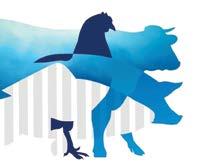










Organized by MOST COMPLETE TRADE SHOW FOR LIVESTOCK PROFESSIONALS IN SUB SAHARAN AFRICA VIV AFRICA 2024 KIGALI, RWANDA 2-3 OCTOBER WWW.VIVAFRICA.NL PAVILION DAIRY PAVILION FEATURING Milling and Grain - April 2024 | 65 F

GEAPS EXCHANGE 2024 EVENT IN KANSAS CITY, MISSOURI BREAKS ALL RECORDS
Records were broken at the biggest GEAPS Exchange 2024 event held in the Kansas City’s Convention and Expo Centre last month. GEAPS, the Grain Elevator and Processing Society of the USA, featured many conferences, demonstrations, numerous networking opportunities, competitions, an Ideas Exchange and the widest range of equipment for the grain handling and processing industries yet gathered.
And we should not overlook the keynote presentation which kicked off this three-day event following Chuck Kunisch, Board President and John Caupert, GEAPS Executive Director announcement of the
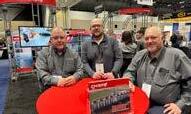
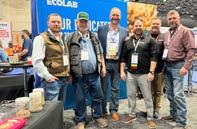
GEAPS Members’ Awards. That proceeded the introduction of rockand-roll drummer Sandy Gennaro, who provided a motivational address that captivated the 1000-plus attendees prepared to take time out at 08:00 on a Sunday morning to consider ‘positive visualisation’ as a way to ‘beat-the-odds’ in life and in work. Mr Gennaro translates his moto into one word: B for belief, E for enthusiasm, A for attitude, T for tenacity and S for service; which cumulates int BEATS, and which he demonstrated with a drumming rendition of th emost favourite recordings he had played on the drums.
Inspired? Yes, the US grain milling industry was captivated.


 On the Chief Agri stand were (from left) Jeff Schmidt, Travys Woodside and Paul Allen. Chief has been exhibiting and supporting GEAPS for 37 years
Dillon Phillips, milling sales with Britney proudly presents the Cimbria SEA.IQ high-end optical sorter at GEAPS 2024
Tom Boehm and Hamza Aziz of Rayhawk from Saskatoon, Canada are making efficiencies and savings in railcar top-loading solutions using computer vision, machine learning and autonomous operations combined to open and close railcars for grain loading while minimising worker risks and speeding up throughput
On the Chief Agri stand were (from left) Jeff Schmidt, Travys Woodside and Paul Allen. Chief has been exhibiting and supporting GEAPS for 37 years
Dillon Phillips, milling sales with Britney proudly presents the Cimbria SEA.IQ high-end optical sorter at GEAPS 2024
Tom Boehm and Hamza Aziz of Rayhawk from Saskatoon, Canada are making efficiencies and savings in railcar top-loading solutions using computer vision, machine learning and autonomous operations combined to open and close railcars for grain loading while minimising worker risks and speeding up throughput
66 | April 2024 - Milling and Grain F STORAGE & HANDLING MAXIMISED
Justin Musgrove, Larry Busch, Perry Nettles, Justin Moses, Alexander Luce, Jason Hendrick, Ecolab in Kentucky, USA. Jason shows off his pet cockroach to illustrate the pest elimination programmes and the services his company offers to those storing grains for food and feed production. The company has a skilled technical team in food safety, pest management, pest identification and employee training


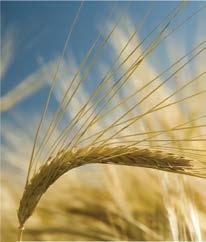





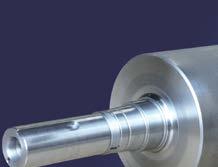























AGI DELIVERS A CUSTOM FULL-SYSTEM SOLUTION FOR FEEDCO
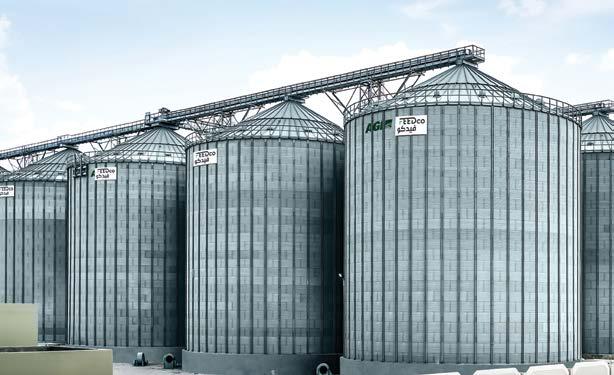
About AGI
For over 30 years, AGI’s Europe, Middle East, and Africa (EMEA) division has been focused on providing manufacturing solutions that meet the unique needs of key grain, rice, feed, and fertilizer producing regions across the world. From its headquarters in Ozzano dell’Emilia, Bologna, Italy, AGI EMEA serves a wide range of customers in various industries including farm, grain trading, milling, and feed mills.
Project background
The focus of FeedCo’s operations is on bolstering food security, through the development of feed milling solutions that underpin the entire livestock, poultry, and feed production sectors. To meet the growing demand for these solutions, and in particular the increased demand for grain across the Saudi market, early in 2020, FeedCo began considering the addition of a new large-scale grain storage and handling facility at their Dammam, Saudi Arabia location, to come onstream in 2021.
Meeting the challenge
After meeting with officials from FeedCo, AGI’s team from the EMEA headquarters in Bologna, Italy quickly went to work to plan the right mix of storage and handling solutions as part of a new turnkey plant to deliver high production capacities and durable equipment. AGI’s solution: to combine AGI FRAME, one of Europe’s leading brands in manufactured agriculture steel silos, and AGI PTM, one of the most respected names in grain handing equipment in the ag industry. In short: bringing together the best of both worlds, to deliver a custom solution for FeedCo.
Project details and equipment
To meet FeedCo’s requirements, AGI’s plan included 10 flat bottom silos and 4 bulk loading silos, for a total storage capacity of 77,500 tons. AGI FRAME’s silos were chosen for their durability and longevity featuring Z600 (G210) galvanized steel and Magnelis (ZM310) coated roofs for protection. It was important to FeedCo to know that all AGI storage components are
manufactured using highly automated techniques, to ensure low tolerances and high performance. Along with the storage solutions, AGI supplied handling equipment such as chain conveyors with loading and unloading capacities of 400 t/h and 200 t/h respectively, a bucket elevator and a flight conveyor, as well as electrical, pre-cleaning, weighing, packaging and fumigation equipment. In the end, the project was completed on schedule, with a total installation time of only four months.
We have been satisfied with AGI’s cutting-edge solutions, coupled with their responsive team, which has been instrumental in the success of our projects.
- Ibrahim Alibrahim, CEO of FeedCo

@AgGrowthIntl | @ AGI EMEA AGGROWTH.COM/EMEA TO TALK TO AGI EXPERTS, EMAIL US AT: EMEA@AGGROWTH.COM SCAN QR To read the full FeedCo AGI Customer Spotlight

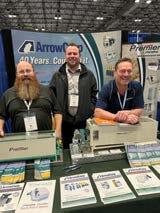
Arrow Corp’s
Platz
Thiessen
Winnipeg, Canada - were in attendance to help any grain processor, from on-farm to export terminals, with efficient particle separation. And not just for high volume wheats but also for peas and canola terminals (notice they have our Milling and Grain Directory on their stand)
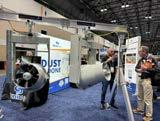
Dust control equipment was in evidence everywhere, but no more so that on the SonicAire stand that promoted its Air Barrier Technology that knocks dust down from elevated areas to the floor and eliminates costly and time consuming cleaning. Moving dust to collection points constantly avoids a build-up of dust and minimises fire and explosion risks within the operating areas of the factory. Joss of SonicAire explaining the operation to Roger Gilbert

Brooke Dessert promotes a range of flour milling and other components from Great Western Manufacturing, a company Milling and Grain had the pleasure of visiting while in Kansas

Dust control baffles that are simple but extremely effective in controlling dust that would otherwise escape into the environment. Under the brands CEG, Kock Filters and United Air Specialists, this company supplies solution to receiving pits, railcar loading and wharf hoppers with a simplistic, mechanical solution. Bob Barbour (left) with colleague Bernard Varela from Houston, Texas

Grain safety was also a key topic on the Central Life Sciences stand where Tony Trash and Nancy Stratinsky from Kearney, Nebraska and Polos Hills Illinois respectively, were winning the battle to alert grain handlers and processors of the dangers of grain infestations and options to treat and prevent. Their product, Deacon IGR, prevents laval development for longterm protection to other production for bin-prep and on-grain applications, including fog and mill sprays

The most impressive equipment on display at GEAPS Exchange 2024 was in our view the BoMill. This modular machine is capable of processing up to 20 tonnes per hour, separating grains of wheat according to their protein content. This is likely to be a game changer in segregating wheat values according to the required flour or product specification being produced and lessen the need for imports of high-protein wheats to produce some flours that standardised wheat sampling does not pick up or allow for separation. Conversely, lower-protein wheats can be specifically identified for products that require less proteins in their make-up
Patrick
(left), Matthew Willis and Scott
- all of
Milling and Grain - April 2024 | 69

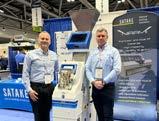
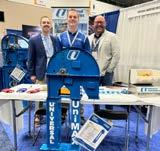


 Betsy Polis, Adrianne Fjerstad-Miller, Brittany Labatt at the GEAPS Exchange 2024 Welcome Desk
Satake Corporation of Japan manufactures and services sophisticated optical sorters for a range of food products. The Satake optical sorters includes Evolution RGB, MIR, the RNEZS, RNEZX, RGBR and the FMSR-IR, Beltuza and the FMS2000. This range gives Satake the capability to sort a very large range of food products. From left is Joe Escamilla and Peter Matthews of Stafford, Texas
Johannes Karcher and Ted Smith of FrigorTec with Darren Parris of Milling and Grain discussing grain cooling and the conservation of grain, rice and seeds using the unique grain chiller GrainFrigor. This machine has been installed in over 70 countries since 1963 - made in Germany
The team from 4B Components at GEAPS 2024: From left are Randy, and colleague, Nilton, Brian, Roger, president Johnny Wheat and Gil
Jordan, Nick and Chris of Universal Industries were keen to show us their of elevators
Betsy Polis, Adrianne Fjerstad-Miller, Brittany Labatt at the GEAPS Exchange 2024 Welcome Desk
Satake Corporation of Japan manufactures and services sophisticated optical sorters for a range of food products. The Satake optical sorters includes Evolution RGB, MIR, the RNEZS, RNEZX, RGBR and the FMSR-IR, Beltuza and the FMS2000. This range gives Satake the capability to sort a very large range of food products. From left is Joe Escamilla and Peter Matthews of Stafford, Texas
Johannes Karcher and Ted Smith of FrigorTec with Darren Parris of Milling and Grain discussing grain cooling and the conservation of grain, rice and seeds using the unique grain chiller GrainFrigor. This machine has been installed in over 70 countries since 1963 - made in Germany
The team from 4B Components at GEAPS 2024: From left are Randy, and colleague, Nilton, Brian, Roger, president Johnny Wheat and Gil
Jordan, Nick and Chris of Universal Industries were keen to show us their of elevators
Dosing & weighing experts since 1973 Easy maintenance Track & trace Reporting Continuity Employee shortage Health safety and environment Accuracy Short batch times Micro dosing and weighing equipment for: Offering a solution to your challenges such as: www.ksegroup.com 70 | April 2024 - Milling and Grain
Essmueller is the USA’s heavy-duty grain handling equipment provider servicing customers at home and worldwide. From drag conveyors, bucket elevators, turnhead distributors to industrial screw feeders with capacities exceeding 80,000 bushels per hour. It is proud to manufacture the Abel line of slide gates and diverter valves. From left: Chris MaLean, Matthew McLean, Jamison Anding, Jay Perkins and Darren Parris
SHIPLOADER SPECIALIST
NEUERO produces the most reliable and high-quality bulk ship loaders worldwide | neuero.de/en




















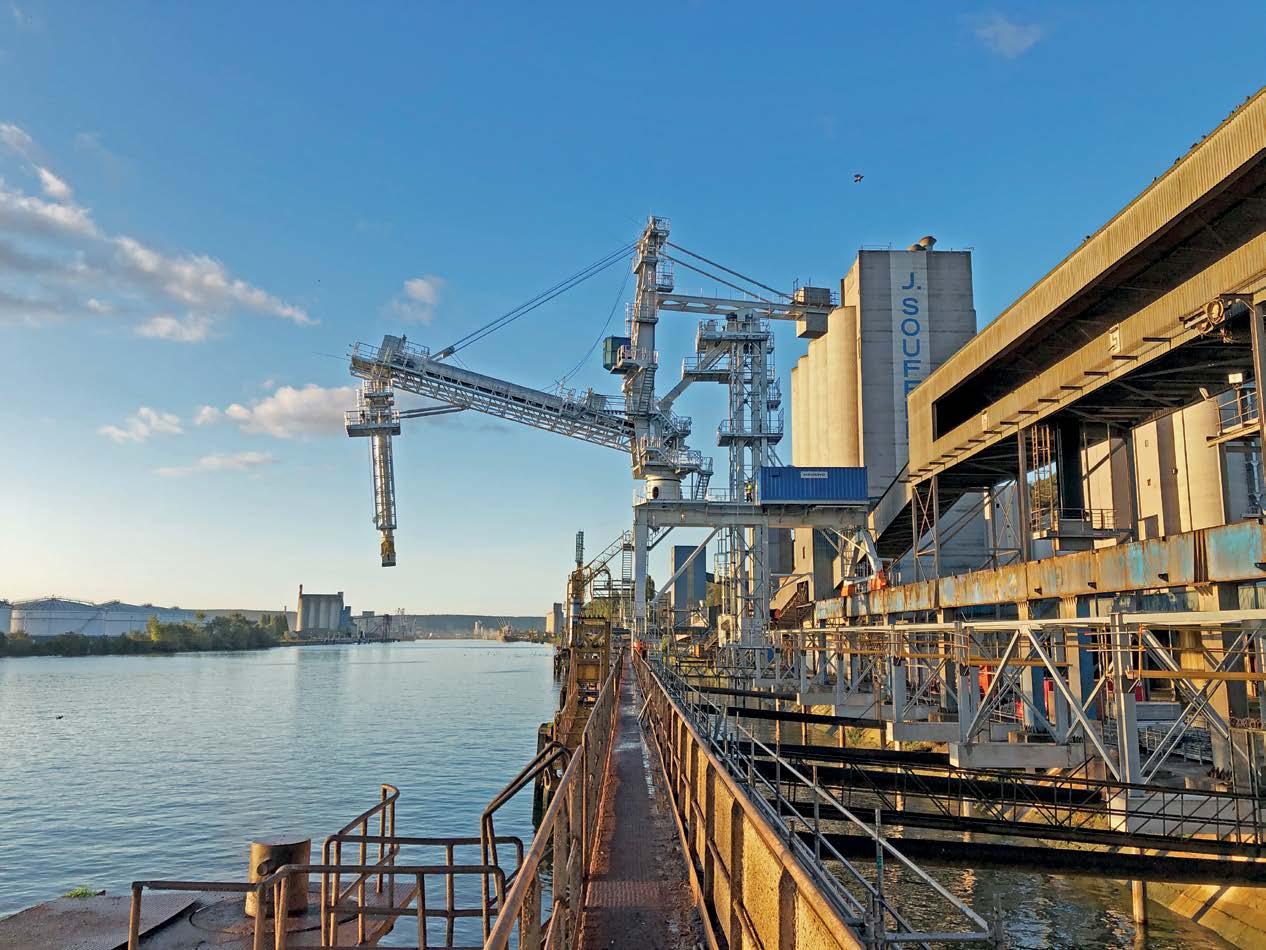


LESS EFFORT AND ENERGY IS MORE PRODUCTIVITY
The age of dark factories has arrived that offer more productivity with less consumption.
With +1000 turnkey projects in 120 countries, Alapala is one step ahead of the era...
alapala.com





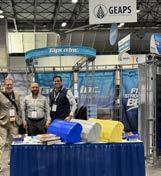


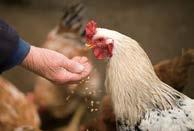

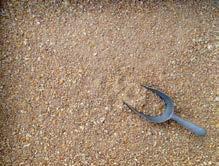 The Brock team at GEAPS. It was difficult to gather all members of the team from left is: Tim Stinson, John Tuttle, Terry Nierengarten, Tony Rabey, Ernesto Dalponte, Mike Manheim and Bill Winchell. Brock’s commercial line of bucket elevators and drag conveyors with models capable of handling up to 25,000 bushels (680 metric tonnes) are well recognised for their reliability and rugged quality. Brock exhibited its breakthrough technology with their TrueGrain™ Moisture Sensor System offering improved accuracy for measuring direct grain flow moisture levels exiting the dryer amount other technologies
Cenk Apa of Tanis Seed Processing Tech, Turkey was exhibiting & promoting its range of grain cleaning and sorting equipment
Roger Gilbert with Tapco’s Luis Avalos and Jon Rue talking strength in elevator buckets
Roger Gilbert talks with Kirk Nelson of Behlen Grain Systems. Behlen is a leading supplier of commercial grain storage systems offering a full line of commercial hopper tanks and steel storage bins with a wide range of options and capacities, including the largest bins available in the market
The Brock team at GEAPS. It was difficult to gather all members of the team from left is: Tim Stinson, John Tuttle, Terry Nierengarten, Tony Rabey, Ernesto Dalponte, Mike Manheim and Bill Winchell. Brock’s commercial line of bucket elevators and drag conveyors with models capable of handling up to 25,000 bushels (680 metric tonnes) are well recognised for their reliability and rugged quality. Brock exhibited its breakthrough technology with their TrueGrain™ Moisture Sensor System offering improved accuracy for measuring direct grain flow moisture levels exiting the dryer amount other technologies
Cenk Apa of Tanis Seed Processing Tech, Turkey was exhibiting & promoting its range of grain cleaning and sorting equipment
Roger Gilbert with Tapco’s Luis Avalos and Jon Rue talking strength in elevator buckets
Roger Gilbert talks with Kirk Nelson of Behlen Grain Systems. Behlen is a leading supplier of commercial grain storage systems offering a full line of commercial hopper tanks and steel storage bins with a wide range of options and capacities, including the largest bins available in the market
OFFICIAL WEBSITE AN EVENT OF MY EXHIBITION CO., Ltd. 9th TAIWAN SMART AGRIWEEK 11-13 SEPTEMBER 2024 TaiNEX 1 - TAIPEI - TAIWAN Elevate Agri-Feed Excellence: Exhibit Your Solutions in Taiwan Secure your space now! www.taiwanagriweek.com/en Milling and Grain - April 2024 | 73 F
Also in the grain transportation business is Renold, headquartered in Morristown, Tennessee with over 130 years of history in the sector, and offers a full chain product line including roller chain, custom and standard attachment chain, as well as solutions chains

Romer Labs, diagnostic testing solutions provider for the food and feed industries, offers one of the most comprehensive testing portfolios for the agricultural markets. From rapid, water-based mycotoxin detection and quantification test system to fast and easy-to-use GMO detection solutions. Here, Paul Moylan and Kelsey Hoagland of Union and Newark respectively pose for a picture
His engaging performance and messages, set the scene for the rest of this three-day outstanding event.
GEAPS Exchange 2024 provided the resources that everyone in the grain handling, storage and flour and feed milling industries needed following years disrupted by the Covid pandemic.
The event took place from February 25–27, 2024, in Kansas City, Missouri, USA, with an additional day prior to the event that included various meetings, a Mixer and a Get Acquainted Party.
November, 2023.
“GEAPS Exchange is such a valuable opportunity for face-to-face networking, learning and so much fun. I’m already looking forward to next year!”
He also mentions how the sold-out show is an opportunity “for growth and expansion” with demand having to place nearly two dozen on a waiting list to exhibit.
This totals nearly 400 more attendees than last year alongside almost 30 more exhibitors, an incredible feat for GEAPS.
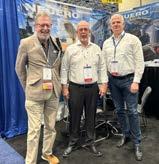
It has been one of the biggest years yet for GEAPS as it set numerous records for the events. Brimming with people, the show hosted a phenomenal 3716 people amongst 391 exhibitors.
“2024 Exchange has been absolutely exceptional.
With Roger Gilbert is Jack Fox (centre) and Andreas Hindenburg on the Neuero Industrietechnik stand at GEAPS. This company is the worldwide leader with more than 100 years experience in the design, engineering, manufacture and delivery of ship loader and ship unloader systems. Sizes range from barges up to and including Capesize vessels. Capacities of 3500 tonnes per hour have been achieved.
“We are shattering records. A record number of attendants, a record number of exhibitors in our sold-out expo and over 45 hours of educational sessions,” says Mr Caupert, the new GEAPS Executive Director who has only recently taken up his role in
“Exchange is an opportunity for all our exhibitors to tell their own stories about what new things they have,” says Adrianne Fjerstad-Miller, GEAPS’ conference and expo director.
“Our exhibitors take a lot of pride in their booths and really work to give our attendees a great representation of what they do and how they can be of service. Yes, Exchange is about relationships and connecting with customers, but it’s also such a wonderful opportunity for our exhibitors to showcase the best of themselves.”
Milling and Grain were one such exhibitor

Silo inventory management with Bin Auditor Radar
Know
Advantages:
• Tracks level, volume and weight
• Level accuracy +/- 10 mm
• Records all movements in and out in real time
• Immune to dust build up
• Maintenance free
• Suitable for all commodities
• Remote data via iGRAIN Smart App, iGRAIN Dashboard Manager or PLC/SCADA systems
The system is designed especially for the dusty conditions in grain, flour and feed silos and has an unsurpassed accuracy.
Combine the radar with iGRAIN software and you have precise content, in and out movement and history of each silo at your finger tips.

iGRAIN - Denmark - info@i-grain.net
Smart design and intelligent algorithms make the system independent of filling or emptying grain surface slope

in
time with the iGRAIN Bin Auditor Radar. Advanced radar technology at
with
meassuring distance of up to 50 metres and a level accuracy of +/÷ 10 mm Emptying slope Filling slope 1/3 x r 1/3 x r Bottom Unload Bottom Unload
your exact silo content
real
120 GHz
a maximum
- www.i-grain.net MAG Half Page 04-2024 Bin Auditor Radar.indd 1 20/02/2024 15.47.02 74 | April 2024 - Milling and Grain F




aker REPRESENTATION FOR: Azerbaijan Georgia Kazakhstan Turkey Turkmenistan Uzbekistan Crepe-tape Pull-off Device 29950F BAG CLOSING SYSTEMS & BAG MAKING SEAMING-CONVERSION MACHINES NEW 8C200 SERIES 56100 BAG SEAMING www.unionspecialturkey.com unionspecialbags@bakermagnetics.com.tr NEW 80800 SERIES 2200 HEAVY DUTY PORTABLE Protection Against Rust GENUINE SPARE PARTS & NEEDLES WORLDWIDE EXPRESS DELIVERY TURKEY Tiirkiye Temsilcisi & Distributor BM Baker Magnetik Willy Brandt Sok. No: 16/1 Cinnah 06690 Cankaya-Ankara, Turkey Tel: +90 312 441 68 01 - 441 6883 Fax: +90 312 441 61 65
Supply
www.bmbaker.eu
www.bakermagnetics.com www.bakermagnetics.com.tr BM Online
Chain Platform:
REDlJ.)RVE � STATEC BINDER
Representatives and Services
Union Special Industry Sewing Heads & Equipment, Bagging and Packaging System.
4B Electronic Components & Monitoring Systems Elevator & Conveyor Components and Electronic Safety Components & Elevator Buckets.
Grain Dryers & Cleaners, Grain Storage
Steel Silos & Grain Handling Equipments.
Grain Temperature Monitoring System
Pellet Mill, Dies & Roller Shells
Magnets & Magnetic Systems & Separators
Recycling & Enviromental Technologies & Sorting Equipments
TURN-KEY PROJECTS The Member of Baker GROUP since 1964
Our
-
-
-
-
-
-
-
-

that was incredibly grateful to be able to showcase its latest magazine. Alongside this, having the opportunity to meet so many new people at the network gatherings and throughout the show such as SonicAire, Authorized Grain Service and Universal Industries are something we are ecstatic about. We were also incredibly happy to reconnect with old friends such as FrigorTec, iGrain and Romer Labs.
Outside of the exhibition itself, the three B2B days for GEAPS were a full itinerary with 45 hours-worth of education sharing a wealth of knowledge that proved to be abundant with innovation and insight.
Split into four education tracks, the sessions were placed into maintenance, employee development, safety and grain operations. The educational tracks allowed the attendees an easier way to decide which sessions met their needs in the simplest way possible.
Amongst these sessions were also demonstrations, innovation showcases, and multiple Grain Entrapment Rescue Demo’s each day.
To open the event were The Mixer and the ‘hoedown-themed’ Get Acquainted Party on the day prior to the start of the show.
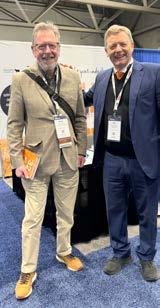
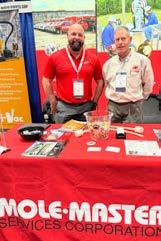
Feeding the world is a daily commitment in which technical and practical knowledge must be precise, synchronized, and balanced. It’s a microbiome that requires the right nutrients, information, advise, and high performing solution that are simple for you and your animals.
At Jefo, it’s more than a gut feeling; it’s science, it’s partnership.
We know you . You aim for the You follow the
Roger Gilbert met with Peer Hansen of iGrain on the floor of the GEAPS Exchange 2024
Michael Bailey and Dan Bruenderman, Mole Master Services Corp the most experience in the silo and bin cleaning industry. For more than 35 years, Mole•Master has created a legacy of safety and commitment in solving the world’s toughest cleaning problems. Its Safe-T-Shot Do-It-Yourself CO2 Blasting Equipment is a powerful yet safe and effective method for removing hardened or compacted material.
jefo.com Milling and Grain - April 2024 | 77 F
At the end of the first day, which started with a highlight inspirational address from rock drummer and speaker Sandy Gennaro, the Sunday concluded with a Welcome Reception to wind down to end a successful first day of the exhibition.
To wrap up the whole show however, GEAPS Exchange 2024 ended with a brief recap by Chuck Kunisch, GEAPS International Board of Directors President and a Music Bingo to win some fun prizes, proving that the GEAPS Exchange is a true epitome of work hard-play hard.
We hope to see you next year at GEAPS Exchange from February 2225, 2025, in its now ‘usual location’ of the KC Convention Centre, Kansas City, Missouri, USA. Booth sales will begin later this year. For more information on GEAPS then visit their website: https://www.geaps.com/ exchange/
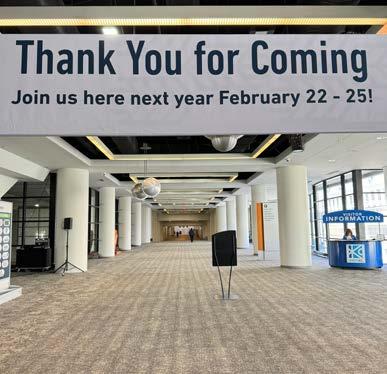



ANDRITZ FEED & BIOFUEL andritz.com/feed-and-biofuel-en Upgrade your operations with ANDRITZ Feed & Biofuel’s advanced, risk-free automation and digitalization integration. Leveraging our 25 years of cross-sector success, our platform blends human and digital intelligence to enhance processing efficiency and support growth, while delivering 7%-16% throughput increases. Our solution encompasses an evolving, vendor-neutral solution supported by state-of-the-art automation and digitalization technology. Send us a request to get a personal consultation: fb-automation@andritz.com FEED & BIOFUEL AUTOMATION & DIGITALIZATION NEVER STAND STILL ANDRITZ WILL BE WITH YOU EVERY STEP OF THE WAY IN YOUR DIGITALIZATION JOURNEY, ENSURING YOUR PLANT AND YOUR BUSINESS NEVER STAND STILL. 78 | April 2024 - Milling and Grain F
The drum set that enthused GEAPS membership
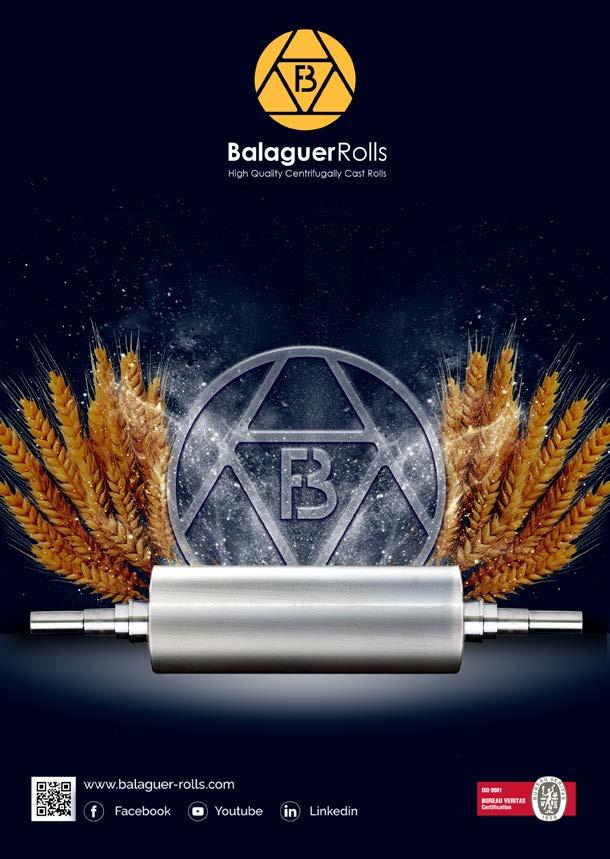
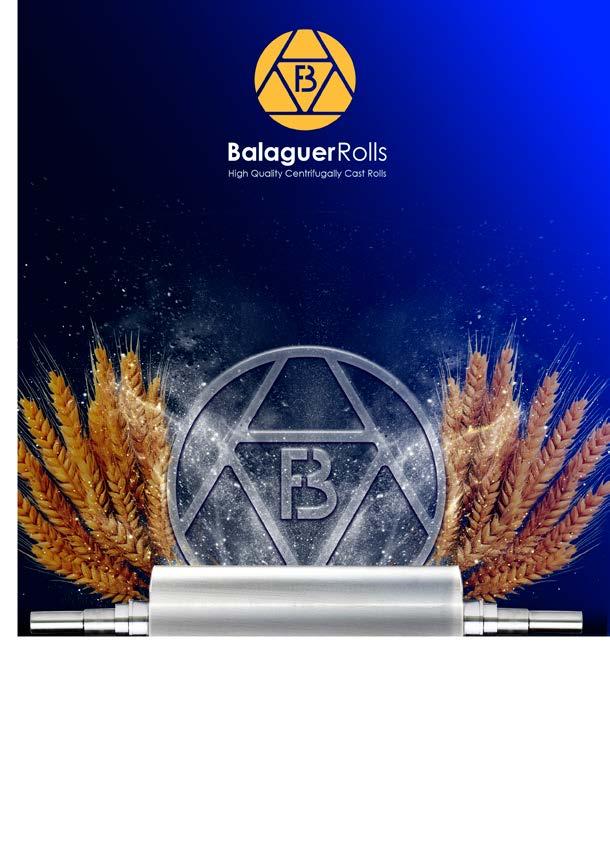

GrainCorp
First GrainCorp grain train runs on Narrabri to North Star line
Another major milestone has been reached on the Narrabri to North Star section of Inland Rail with the first GrainCorp train in more than six years traveling on the track north of Moree, to load canola from the GrainCorp silos in Croppa Creek

The Pacific National train loaded up to 55 tonnes of canola into each of its 48 wagons at the Croppa Creek GrainCorp site, carrying a total of approximately 2600 tonnes of product. It is the first of a dozen trains that will be leaded out of Croppa Creek in the next month.
The canola was transported to the Port of Newcastle, from where it would be sent on to Europe. Transporting this volume of canola by road would have required 50 B-double trucks driving across New South Wales, increasing transport carbon emissions.
Residents in the region are advised that with commercial trains now accessing the line North of Moree, once again all road users are reminded to look out for trains at level crossings.
The Narrabri to North Star project started construction back in 2021 and major construction on Phase 1 of the project was completed in October last year.
The Narrabri to North Star Phase 1 project included upgrading 176km of track along the existing rail corridor. Inland Rail also completed upgrades to seven bridges, enhanced safety at 57 level crossings with 10 passive level crossings upgraded to active with bells, lights, and boom gates, and has improved telecommunications for local communities.
The upgrades deliver a more efficient and reliable line for local producers, boosting resilience against extreme weather events, with the track withstanding the worst floods in a decade to hit Moree in 2022.
Regional communities in northwest New South Wales received an economic boost from the project, with US$244 million spent with 137 local businesses, including nearly US$9 million spent with First Nations businesses. Over 2000 people worked on the project, including 678 locals. Phase two of the Narrabri to North Star project, which
involves further upgrades and building two kilo meters of new track north of Moree, is currently in approvals with Inland Rail now preparing a Preferred Infrastructure Report and a Response to Submission for the NSW Department of Planning, Housing and Infrastructure.
Once Phase two is completed, the upgraded track between Narrabri and North Star will allow freight customers to transport heavier freight volumes at higher speeds through its access to the Australian Rail Track Corporation Hunter Valley Rail Network, boosting their productivity and efficiency.
Peter Borrelli, Inland Rail Project Director Narrabri to North Star, said:
“It is a great moment for us to see the first GrainCorp train using the upgraded line to access their facility at Croppa Creek.
“Delivering the N2NS Phase 1 project was always about building a better, safer, and more resilient rail line that would create new opportunities for primary producers in regional Australia and tis milestone is evidence of that.
“The Narrabri to North Star Phase 1 project Brought with it an economic boost to communities in Northwest New South Wales, and we are looking forward to seeing more regional benefits in coming years with construction between Parkes and Albury prioritised for completion by 2027.
“Inland Rail will enhance our national freight and supply chain capabilities, connecting existing freight routes through rail, roads, and ports and supporting Australia’s growth.”
Mick Grant, GrainCorp Area Manager, Moree North Cluster, said “Inland Rail’s upgrades to the rail line and the siding at Croppa Creek have enabled a safe and efficient transport of a bumper Canola harvest from our facility to the port of Newcastle.
“We are proud to do our part utilising Inland Rail to reduce the carbon emissions of Australia’s freight industry – with each of our grain trains getting the equivalent freight volume of 50 B-double trucks off New South Wales roads.”
80 | April 2024 - Milling and Grain CASE STUDY


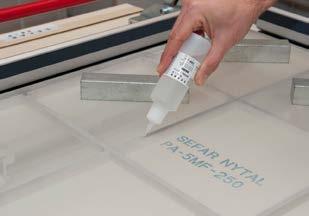

SEFAR NYTAL ® . The name you can trust. Since 1830, Sefar is the single-source supplier to millers for all products for sieving, grading, and dust filtration as well as connector sleeves, sieve cleaners and tensioning equipment. FOOD SAFETY FDA COMPLIANT Headquarters Sefar AG Hinterbissaustrasse 12 9410 Heiden – Switzerland Phone +41 898 57 00 filtration@sefar.com www.sefar.com As your trusted supplier of precision woven fabrics, Sefar is proud to introduce our newest complimentary innovation: SEFAR NYTAL® Sieve Cleaners
Grain Market Report - Ukraine World Markets
by Jyothsna Nelloolichalil, Milling and Grain magazine
Ukraine is one of the world’s largest exporters of grain. Ukraine accounts for ten percent of the world wheat market, 15 percent of the corn market, and 13 percent of the barley market. After the Russian invasion, Ukraine’s export dropped by over 90 percent in 2022. The export volume grew later in the year but they were still much lower than in 2021. The Black Sea grain deal tremendously helped increase the export from Ukraine, but Russia called off the deal in July this year, which in turn negatively impacted the exports.
The Ukraine Grain and Feed Update Report for Marketing Year (MY) 2024 provides insights into the production, exports, consumption, and stocks of grains in Ukraine. This report focuses on revised forecasts for wheat, barley, rye, and corn for MY 2023/24, based on data provided by the Ministry of Agrarian Policy and Food of Ukraine (MAPF), the State Statistics Service of Ukraine (SSSU), and industry sources.
Ukraine’s MY2023/24 harvest features higher grain production volumes across the board than the previous year. By the end of 2023, Ukraine independently resumed operations of its major marine ports on the Black Sea, Chornomorsk, Odesa, and Pivdennyi. It increased the throughput of the Danube River export routes. December’s exports show sufficient export bandwidth to export MY2023/24 beginning stocks down to average historical levels alongside shipping out nearly the entire MY2023/24 crop of major grains. This report features higher MY2023/24 export estimates and lower MY2023/24 ending stocks for all grains compared to estimates made in October 2023.
Production
The MY2023/24 harvest for barley, wheat, and rye has concluded, with notable increases in production for some grains. Barley production is estimated at 5.9 million metric tons (MMT), representing a two-percent increase from the previous year. Wheat production has seen a significant boost, reaching 22.5 MMT, an 11-percent increase compared to MY2022/23. However, rye production witnessed a decrease, with an estimate of 240,000 metric tons, marking a 24-percent decline from the previous year. Corn harvesting is still underway, with an estimated production of 31.5 MMT, based on preliminary data.
Exports
After the full-scale invasion in late February 2022 and the blockade of Ukraine’s Black Sea ports, until the start of the UN-brokered
Black Sea Grain Initiative (BSGI) in late July 2022, exports of all significant grains out of Ukraine were at minimal levels for almost five months (see Figure 1). Ukraine lost access to its most costefficient Black Sea ports during that period. Ukraine was limited by the existing transhipment capacity of railroads, trucks heading across EU borders, and barges and vessels dispatched from Danube River ports. During this time, though, exports from these alternative routes ramped up, and these overland routes and Ukraine’s ports on the Danube are now important transportation options for exporters. The BSGI, which was in place from the end of July 2022 to the end of July 2023, allowed Ukraine to increase grain exports to high levels again during MY2022/23. BSGI facilitated Ukraine’s use of their Black Sea ports of Chornomorsk, Odesa, and Pivdennyi.
After Russia terminated the BSGI in July 2023, Ukraine initiated the movement of civilian vessels through a new Ukrainian corridor to Chornomorsk, Odesa, and Pivdennyi ports in October 2023.
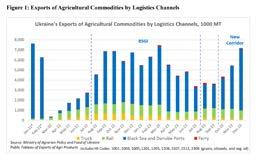
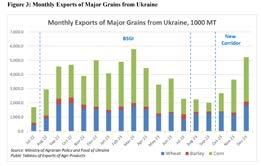

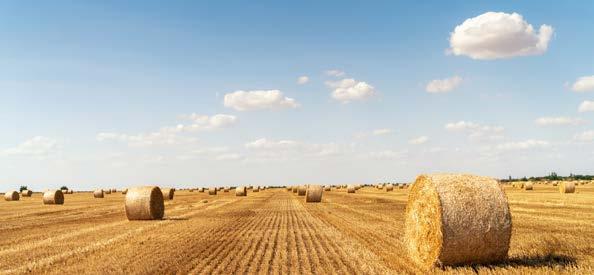

82 | April 2024 - Milling and Grain Commodities - April 2024





















Improving the Safety & Efficiency of Your Plant www.go4b.com 4B DESIGNS AND MANUFACTURES COMPONENTS FOR BUCKET ELEVATORS AND CONVEYORS ELEVATOR BUCKETS ELEVATOR BOLTS BELTING & SPLICES PREVENTATIVE MAINTENANCE & HAZARD MONITORING SYSTEMS CONVEYOR CHAIN BEARING TEMPERATURE SENSORS SPEED SWITCHES BELT MISALIGNMENT SENSORS Engineering Solutions Since 1888 A Worldwide Manufacturer LEVEL & PLUG SWITCHES

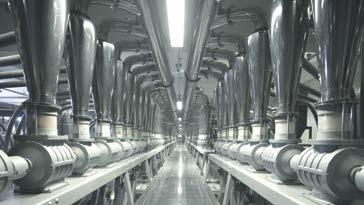





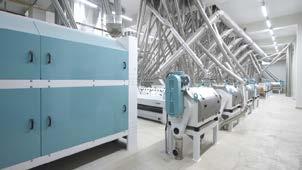



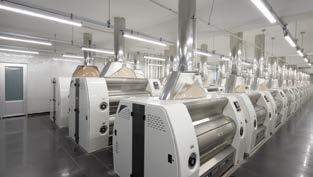
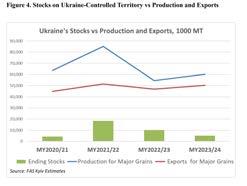

According to press reports, vessels using the corridor follow neighboring countries’ territorial waters to reach the Bosphorus. They enter Ukrainian territorial waters from Romanian waters near the mouth of the Danube River Afterward, they follow the specified route alongside coasts to a respective seaport. Based upon the high December 2023 export rate, if Ukraine maintains average monthly exports of around 4 MMT for all grains combined for the remainder of the marketing year, they will export the vast majority of the harvest and reach the export estimates in this report, leaving an estimated 5MMT total for all grains remaining as ending stocks for MY2023/24 (see Figure 4). Historically, over the last few years, Ukraine exported, on average, 3.8 MMT of grains (corn, wheat, and barley combined) each month. January exports are on track to be slightly below the
1 2024/3/18 17:38:09
Ms.Haidee Wang
Mob: +86 138 1775 2961
haidee.wang@globusevents.com
Mr. Philippe Verstuyft(based in Europe)
Tel: +31 6 1517 3564
philippe.verstuyft@vnuexhibitions.com
December peak. Concerns about transiting the Red Sea do not yet seem to have significantly impacted Ukraine’s exports, and according to exporters, the situation has only slightly increased bulk freight rates.
Ukraine predominantly imports corn seeds for planting. However, these volumes are gradually decreasing as major global seed companies have already established their seed multiplication facilities in Ukraine.
Consumption
Domestic grains consumption estimates for MY2023/24 have been adjusted upward based on the return of refugees to Ukraine, as reported by the UNHCR. Post estimates feed consumption to remain at the same level as the previous year, while food, seed, and industrial (FSI) consumption have seen slight adjustments based on population estimates.
Stocks
Ending stocks for MY2023/24 are estimated at 5 MMT, representing a 50-percent decrease compared to the previous year. This decrease is attributed to increased export estimates for the current year, reducing the available grain stocks in Ukraine. The Ukraine Grain Market for MY2024 reflects notable changes in production, exports, consumption, and stocks compared to the previous year. Despite challenges such as the termination of the BSGI and ongoing geopolitical tensions, Ukraine has managed to increase its export capacity and maintain a strong presence in the global grain market. Looking ahead, continued efforts to enhance transportation infrastructure and mitigate risks will be crucial for sustaining growth in the Ukrainian grain sector.

Exhibition Area 500+ Exhibitors 30000+ Visitors 200+ Delegations 20+ Conferences 210+ Media & Partners International Trade Show from Feed to Food We are recruiting Exhibitors Hosted Buyers! Ask us to apply Now! www.VIVchina.nl www.VIVworldwide.cn Welcome to China!
50,000m2
C M Y CM MY CY CMY K
VIV24 媒体广告190x132mm.pdf
Milling and Grain - April 2024 | 85 Commodities
INDUSTRY EVENTS
2024


April
15 - 19
128th Annual IAOM Conference & Expo
Salt Lake City, USA
www.iaom.org
29 - 3
Agrishow 2024
Ribeirão Preto, Brazil
www.agrishow.com.br/en/home.html
2024 May

2-4
IDMA
İstanbul, Türkiye
www.idma.com.tr
International Flour, Feed, Corn, Semolina, Rice, Bulghur Milling
Machinery & Pulses, Pasta, Biscuit Technologies Exhibition
IDMA Fairs, organized by Idma International Fair, have been bringing together the representatives of the grain and pulses processing industry for 16 years.

13 - 15
PIX/AMC
Broadbeach, Australia
https://pix.au
22 - 23
Livestock Philippines 2024
Pasay City, Philippines
www.livestockphilippines.com

22-24
AgriTechnica Asia
Bangkok, Thailand
www.agritechnica-asia.com
29 - 31

ILDEX Vietnam
SECC, Ho Chi Minh City, Vietnam
www.ildex-vietnam.com
2024 June
5-6
Fenagra 2024
São Paulo, Brazil
www.fenagra.com.br

11 - 12
Cereals 2024
Bygrave Woods, England
www.cerealsevent.co.uk

11-12
IGC 2024
London, England
www.igc.int
11-13
DLG-Feldtage
Lipptstadt, Germany
www.dlg-feldtage.de
19-21
Livestock Taiwan 2024
Taipei, Taiwan
www.livestocktaiwan.com
2024 July

17-19
IndoLivestock 2024
Jakarta, Indonesia
https://indolivestock.com


11 - 12 JUNE 2024
2024 86 | April 2024 - Milling and Grain
IGC GRAINS CONFERENCE













C M Y CM MY CY CMY K ai171048219644_Iklan Prendale 210 x 297.pdf 1 15/03/2024 12:56:40
iennialSummit BiennialSummit
INNOVATION, DISCUSSION AUSTRALASIAN MILLING CONFERENCE B
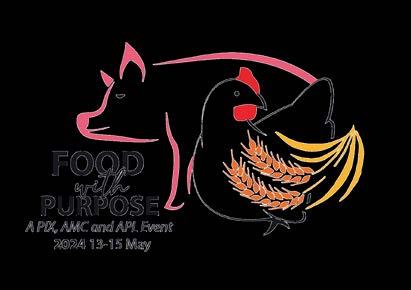
PLENARY SPEAKERS BERNARD SALT AND MELISSA CLARK - REYNOLDS
13- 15 MAY 2024 AND INSIGHTS
OVER 200 EXHIBITION BOOTHS
Gold Coast Convention and Exhibition Centre, Australia NEW PROGRAM FORMAT
WWW.PIX.AU


AUSTRALIA AND REGION FEEDING A GREATER HUMANITY: HOW THE DEMOGRAPHICS OF AGRIBUSINESS WILL FLOURISH IN THE NEXT DECADE
The 21st century’s great challenge will be to feed an even greater humanity. In this world the demand for poultry, for pork and for milled grain—for stock and human consumption—must increase.
In this session author, business advisor, speaker Bernard Salt takes us deep into the compelling world of demography and shows us why we should have confidence in the future of agribusiness down under!
DRIVERS OF CHANGE AFFECTING THE FOOD INDUSTRY
Melissa is widely recognised as an inspirational role model and business leader.
A futurist, who is equally passionate about food, sustainability and climate change. Melissa is incredibly quick to jump onto signals and foresee patterns that help her to advise companies of disruptions, challenges and opportunities.


IAOM ANNUAL CONFERENCE AND EXPO 2024
The 128th IAOM annual conference and expo will be held from April 15 – April 19 at Salt Lake City, Utah.
Grain milling professionals consistently find that the IAOM conference experience affords them an opportunity to enhance and advance their careers through comprehensive education programs, to connect with their industry peers at exciting networking events, and to develop relationships with vendors who offer the products and services they need to efficiently do their job.
The IAOM Annual Conference & Expo is the premier educational event for grain milling and seed processing professionals. The annual event gathers milling and allied trade professionals from around the world for three days of education, networking and fellowship. Educational and technical programs presented at the conference assist millers in improving yields, productivity, customer satisfaction and safety. The programs are presented by seasoned professionals in the field who have experienced the issues affecting millers first-hand.
In addition, the annual conference also includes the world’s largest Expo for milling professionals, typically featuring over 140 companies displaying milling and processing equipment and related services.

The IAOM Program Committee has developed an expansive lineup of educational programming for this year’s conference. Attendees will gain extensive knowledge from presenters from around the globe on topics addressing Employee Management, Product Protection, Technical Operations and Facility Management.
An IAOM Women in Milling World Cafe is scheduled from 3:30-5 p.m. on Tuesday, April 16. All female attendees, committee and board members are invited to attend.
On April 17, our educational tracks will commence with our keynote speaker, Peter Levangie, President & CEO of Bay State Milling. Following the keynote address, we have a lineup of additional educational sessions. These topics will include career development, staffing your workforce, FDA inspections, the impact of flow sheet management, leveling up your foggings and fumigations, staying compliant with NFPA 70B and 70E, and more. The main line sessions on April 18 will include a much-anticipated panel discussion and capturing the science in the “art” of milling.
For more information about exhibiting and sponsorship opportunities, contact Whitney at whitney.fox@iaom.org for more information.
















































INDUSTRY EVENTS 90 | April 2024 - Milling and Grain






Scan code to watch video




brockgrain.com/walkarounds-int BROCK ® Mid-Roof Walkarounds give workers safe, 360-degree access for equipment inspection and maintenance. They are pre-engineered to integrate seamlessly with Brock’s EVEREST ® bins, stairways and ladders.
BROCK® Mid-Roof Walkarounds
E ciency Maintenance Confidence Safety Storage | Handling | Drying & Conditioning | Structures +1 866.658.4191 brockgrain.com

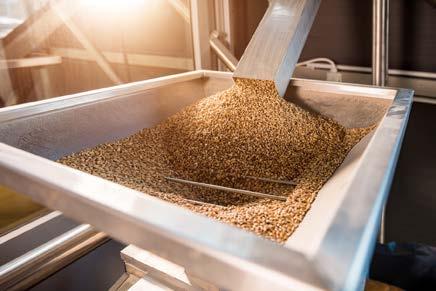


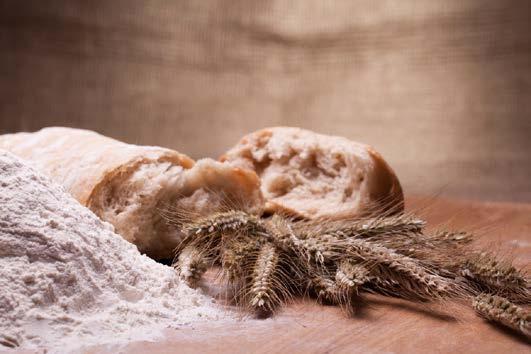
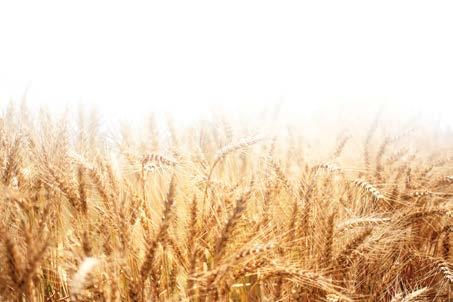




INDUSTRY EVENTS MORE INFORMATION nickmouthaan@victam.com +31 6 2126 4398 victaminternational.com PRE BOOKING RATE : until October 31st, 2024 * EARLY BIRD RATE : until October 31st, 2025 * SEE YOU IN 2026 * Sales starts in March 2024 and as the event takes place in different halls, the stand allocation is done on a first come first serve basis JUNE 2-4, 2026 JAARBEURS, UTRECHT, THE NETHERLANDS JOIN OUR 60TH ANNIVERSARY 190 x 132 Perendale Int2026.indd 1 25-03-2024 10:48 BOOK YOUR STAND BEFORE APRIL 1, 2024 AND TAKE ADVANTAGE OF THE EARLY BIRD SALES DISCOUNT . CONNECTING ALL AMERICAN CONTINENTS BRAZIL São Paulo JOIN US in 2025 FEED INGREDIENTS LATIN AMERICA 2025 FEED INGREDIENTS LATIN AMERICA 2025 SEPTEMBER 16-18, 2025 EXPO CENTER NORTE, WHITE PAVILION, SÃO PAULO, BRAZIL victamlatam.com 190 x 132 Perendale.indd 1 25-03-2024 11:15 Milling and Grain - April 2024 | 93

Amino acids

Evonik Operations GmbH
+49 6181 59 12437
www.evonik.com/animal-nutrition
PROFILE: mymag.info/GJqQ
Bagging systems




Behn + Bates
+49 251 9796 252
www.behnbates.com
PROFILE: mymag.info/PaXw
Bühler AG
+41 71 955 11 11
www.buhlergroup.com
PROFILE: mymag.info/dZxH
FAWEMA
+49 2263 716-0
www.fawema.com
PROFILE: mymag.info/bdRz
Maxtex Trading Group Co. Ltd.
+66 29488281
www.maxtex.net
PROFILE: mymag.info/TQpr
Statec Binder
+43 3112 38 5800
www.statec-binder.com
PROFILE: mymag.info/Tbyt

Golden Grain Group
+86 371 68631308
www.g-grain.com
PROFILE: mymag.info/eCyP
Bakery improvers
Bastak
+90 312 395 67 87
www.bastak.com.tr
PROFILE: mymag.info/VDLI
ERKAYA
+90 312 395 2986
www.erkayagida.com.tr
PROFILE: mymag.info/Ojcm
Bulk storage

AGI
www.aggrowth.com
PROFILE: mymag.info/clVX







Behlen
+1 402 564 3111
www.behlengrainsystems.com
PROFILE: mymag.info/hncS
Brock
+1 866 658 4191
www.brockgrain.com
PROFILE: mymag.info/GGYu
Bühler AG
+41 71 955 11 11
www.buhlergroup.com
PROFILE: mymag.info/dZxH
Silo Construction & Engineering
+32 51723128
www.sce.be
PROFILE: mymag.info/UOay
Symaga
+34 926640475
www.symaga.com
PROFILE: mymag.info/vxbf
The Essmueller
+1 800 325 7175
www.essmueller.com
PROFILE: mymag.info/MdZl
TSC Silos
+31 543 473979
www.tsc-silos.com
PROFILE: mymag.info/HTSY
Van Aarsen International
+31 475 579 444
www.aarsen.com
PROFILE: mymag.info/JUgk
Cereal and pulse conditioning

Bühler AG
+41 71 955 11 11
www.buhlergroup.com
PROFILE: mymag.info/dZxH
Friedrich Electronic
+49 6406 923350
www.friedrich-electronic.de
PROFILE: mymag.info/gbBd
Vibrafloor
+33 3 85 44 06 78
www.vibrafloor.com
PROFILE: mymag.info/cgrU
vibronet-Gräf GmbH & Co.KG
+49 6441 62031
www.vibronet.com
PROFILE: mymag.info/icHn
Colour sorters




Bühler A G
+41 71 955 11 11
www.buhlergroup.com
PROFILE: mymag.info/dZxH
Cimbria Srl
+39 0542 361423
www.cimbria.com
PROFILE: mymag.info/XYRL
Maxtex Trading Group Co. Ltd.
+66 29488281
www.maxtex.net
PROFILE: mymag.info/TQpr
Satake
+81 82 420 8560
www.satake-group.com
PROFILE: mymag.info/Lwtk
Business Services

Bourne Recruitment
+44 161 262 1069
www.bournerecruitment.co.uk
profile: mymag.info/SWzY
Computer software

iGrain
+45 31633900
https://crop-protector.com
PROFILE: mymag.info/FxFP
Inteqnion
+31 543 49 44 66
www.inteqnion.com
PROFILE: mymag.info/ZyIm


KSE
+31 497 383818
www.ksegroup.com
PROFILE: https://mymag.info/fhSV
Van Aarsen International
+31 475 579 444
www.aarsen.com
PROFILE: mymag.info/JUgk
Conveyor Chains

VAV Conveyor Components & Solutions
+31 7140 23701
www.vav-nl.com
PROFILE: mymag.info/aPKR
MAG TV MAG TV is Milling and Grain magazine’s video channel. Featuring content about new products, interviews with industry professionals, industry event content and much more QR codes We use QR codes to take you directly to more information on the web myMAG links myMAG links are shortened hyperlinks that will take you directly to content when typed into a browser mymag.info/e/37 What is The Market Place The Market Place is a collaboration between Milling and Grain magazine and our sister titles, The International Milling Directory and The Global Miller. It aims to connect the print and the digital world, bringing more content that will be of interest, as well as direct links to the content that you want to see.
94 | April 2024 - Milling and Grain
millingandgrain.com/the-market-place
Coolers & driers

Bühler AG
+41 71 955 11 11
www.buhlergroup.com
PROFILE: mymag.info/dZxH
Consergra s.l
+34 938 772207
www.consergra.com
PROFILE: mymag.info/GPtm
FrigorTec GmbH
+49 7520 91482-0
www.frigortec.com
PROFILE: mymag.info/fRiz
FAMSUN
+86 85828888
www.famsungroup.com
PROFILE: mymag.info/opGO

iGrain
+45 31633900
https://crop-protector.com
PROFILE: mymag.info/FxFP
Eye-Grain ApS (iGRAIN®) provides a range of solutions for post-harvest protection of stored grain.
Marketed under iGRAIN®, CROP-PROTECTOR® and TOXI-SCRUB® brands.
The iGRAIN® product portfolio also includes advanced automated aeration control for any climatic zone.
The iGRAIN Smart App provides the user with handy information about the grain condition and predicts the longest safe storage time in each silo. All iGRAIN® solutions integrates with other platforms and PLC/SCADA solutions.
iGRAIN® systems can be tailored to suit the needs from small-scale farmers as well as large-scale industrial storages of grain, beans, cocoa, coffee as well as flour, feed, and oil mills.


Wenger Manufacturing
+1 785-284-2133
www.wenger.com
PROFILE: mymag.info/QiGw
Van Aarsen International
+31 475 579 444
www.aarsen.com
PROFILE: mymag.info/JUgk
Yemmak
+90 266 7338363
www.yemmak.com
PROFILE: mymag.info/QBbm
Yemtar Feed Mill Machines
+90 266 733 8550
www.yemtar.com
PROFILE: mymag.info/aPXh
Dosing


Bühler AG
+41 71 955 11 11
www.buhlergroup.com
PROFILE: mymag.info/dZxH
Friedrich Electronic
+49 6406 923350
www.friedrich-electronic.de
PROFILE: mymag.info/gbBd
KSE
+31 497 383818
www.ksegroup.com
PROFILE: https://mymag.info/fhSV
Tietjen Verfahrenstechnik GmbH
+49 4106 6333 0
www.tietjen-original.com
PROFILE: mymag.info/uyGD
Van Aarsen International
Elevator buckets

4B Braime
+44 113 246 1800
www.go4b.com
PROFILE: mymag.info/HiwC
CESCO
+49 7531 122860
https://cesco-group.com
PROFILE: mymag.info/VkQk
Tapco Inc

+1 314 739 9191
www.tapcoinc.com
PROFILE: mymag.info/ogOz

VAV Conveyor Components & Solutions
+31 7140 23701
www.vav-nl.com
PROFILE: mymag.info/aPKR
Yemtar Feed Mill Machines
+90 266 733 8550
www.yemtar.com
PROFILE: mymag.info/aPXh
Elevator & conveyor components




4B Braime
+44 113 246 1800
www.go4b.com
PROFILE: mymag.info/HiwC
Bühler AG
+41 71 955 11 11
www.buhlergroup.com
PROFILE: mymag.info/dZxH
Henry Simon
+44 161 804 2800
www.henrysimonmilling.com
PROFILE: mymag.info/tYpO
Tapco Inc
+1 314 739 9191
www.tapcoinc.com
PROFILE: mymag.info/ogOz
Yemtar Feed Mill Machines
+90 266 733 8550
www.yemtar.com
PROFILE: mymag.info/aPXh
Van Aarsen International


Enzymes
+31 475 579 444
www.aarsen.com
PROFILE: mymag.info/JUgk
VAV Conveyor Components & Solutions
+31 7140 23701
www.vav-nl.com
PROFILE: mymag.info/aPKR
Bastak
+90 312 395 67 87
www.bastak.com.tr
PROFILE: mymag.info/qHkV
ERKAYA
+90 312 395 2986
www.erkayagida.com.tr
PROFILE: mymag.info/Ojcm
PLP
+39 05 23 89 16 29
www.plp-systems.com
PROFILE: mymag.info/PGWg


Bühler AG
+41 71 955 11 11
www.buhlergroup.com
PROFILE: mymag.info/dZxH
Wenger Manufacturing
+1 785-284-2133
www.wenger.com
PROFILE: mymag.info/QiGw
Yemmak
+90 266 7338363
www.yemmak.com
PROFILE: mymag.info/QBbm
Yemtar Feed Mill Machines
+90 266 733 8550
www.yemtar.com
PROFILE: mymag.info/aPXh
Feed nutrition

Anpario
+44 1909 537 380
www.anpario.com
PROFILE: mymag.info/wAMV
dsm-firmenich
+44 1452 306129
www.dsm.com/anh
PROFILE: mymag.info/ksCT


Feed milling
Evonik Operations GmbH
+49 6181 59 12437
www.evonik.com/animal-nutrition
PROFILE: mymag.info/GJqQ
Romer Labs Division Holding
GmbH
+43 2782 803 0
www.romerlabs.com
PROFILE: mymag.info/PnKH
ALAPALA Feed Tech
+90 212 465 60 40
https://alapala.com
/en/feed-mill-machinery
PROFILE: mymag.info/CbJl

Bühler AG
+41 71 955 11 11
www.buhlergroup.com
PROFILE: mymag.info/dZxH
CESCO
+49 7531 122860
https://cesco-group.com
PROFILE: mymag.info/VkQk
milltech

+90 332 5021300
www.milltech.com.tr
PROFILE: mymag.info/hfOy
Dinnissen BV
+31 77 467 3555
www.dinnissen.nl
PROFILE: mymag.info/pUDK
FAMSUN
+86 85828888
www.famsungroup.com
PROFILE: mymag.info/opGO
Ottevanger Milling Engineers
+31 79 593 22 21
www.ottevanger.com
PROFILE: mymag.info/mlzK
PLP
+39 05 23 89 16 29

+31 475 579 444
www.aarsen.com
PROFILE: mymag.info/JUgk
Extruders

Almex
+31 575 572666
www.almex.nl
PROFILE: mymag.info/IMiV
www.plp-systems.com
PROFILE: mymag.info/PGWg
Milling and Grain - April 2024 | 95


Sangati Berga
+55 11 2663 9990
www.sangatiberga.com.br
PROFILE: mymag.info/dxie
Tietjen Verfahrenstechnik GmbH
+49 4106 6333 0
www.tietjen-original.com
PROFILE: mymag.info/uyGD
Van Aarsen International
+31 475 579 444
www.aarsen.com
PROFILE: mymag.info/JUgk
VAV Conveyor Components & Solutions
+31 7140 23701
www.vav-nl.com
PROFILE: mymag.info/aPKR
vibronet-Gräf GmbH & Co.KG
+49 6441 62031
www.vibronet.com
PROFILE: mymag.info/icHn
Yemmak
+90 266 7338363
www.yemmak.com
PROFILE: mymag.info/QBbm


Zheng Chang
+86 2164184200
www.zhengchang.com
PROFILE: mymag.info/wecN
Golden Grain Group
+86 371 68631308
www.g-grain.com
PROFILE: mymag.info/eCyP
Feed Mill Automation
ALAPALA Feed Tech
+90 212 465 60 40
https://alapala.com/en/ feed-mill-machinery
PROFILE: mymag.info/qmHZ



Bühler AG
+41 71 955 11 11
www.buhlergroup.com
PROFILE: mymag.info/dZxH
KSE
+31 497 383818
www.ksegroup.com
PROFILE: https://mymag.info/fhSV
Van Aarsen International
+31 475 579 444
www.aarsen.com
PROFILE: mymag.info/JUgk
Flour Improvers
Bastak
+90 312 395 67 87
www.bastak.com.tr
PROFILE: mymag.info/VDLI
Flour milling



Henry Simon
+44 161 804 2800
www.henrysimonmilling.com
PROFILE: mymag.info/tYpO
Maxtex Trading Group Co. Ltd.
+66 29488281
www.maxtex.net
PROFILE: mymag.info/TQpr
milltech
+90 332 5021300
www.milltech.com.tr
PROFILE: mymag.info/hfOy
Grain handling systems





Behlen
+1 402 564 3111
www.behlengrainsystems.com
PROFILE: mymag.info/hncS
Brock
+1 866 658 4191
www.brockgrain.com
PROFILE: mymag.info/GGYu
Bühler AG
+41 71 955 11 11
www.buhlergroup.com
PROFILE: mymag.info/dZxH
CESCO
+49 7531 122860
https://cesco-group.com
PROFILE: mymag.info/VkQk
Cimbria A/S
+45 96 17 90 00
www.cimbria.com
PROFILE: mymag.info/XYRL
Henry Simon
+44 161 804 2800
www.henrysimonmilling.com
PROFILE: mymag.info/tYpO
iGrain
+45 31633900
https://crop-protector.com
PROFILE: mymag.info/FxFP
Sangati Berga
+55 11 2663 9990
www.sangatiberga.com.br
PROFILE: mymag.info/dxie
Symaga


+34 91 726 43 04
www.symaga.com
PROFILE: mymag.info/vxbf
Tapco Inc
+1 314 739 9191
www.tapcoinc.com
PROFILE: mymag.info/ogOz
Tapco was conceived in the early 1970s by Paul D Taylor, President and Ted W Beaty, Retired, to fill a void in the elevator bucket industry. At that time, there was only one manufacturer of non-metallic buckets in the USA all the other buckets were made from fabricated steel. With the inherent problems of steel buckets and the limited range of the existing polyethylene brand, the time was right for Tapco.
The company has been in its own 92,500 square foot facility for over 50 years. This has allowed them to utilise injection moulding ‘in house’ for better control and cost effectiveness. Tapco has nine injection moulding machines ranging from a small 150 tonne to a very large 1000 tonne press. Allowing them to make an entire range of buckets in the most expedient and quality controlled manner.
According to their website, “Tapco stocks the largest inventory of elevator buckets and bolts in the world, with over 1 million buckets and 15 million bolts. We also have the largest inventory of abrasion resistant sheeting, drag flights and hanger bearings in North America”.

The Essmueller
+1 800 325 7175
www.essmueller.com
PROFILE: mymag.info/MdZl
Yemtar Feed Mill Machines
+90 266 733 8550
www.yemtar.com
PROFILE: mymag.info/aPXh

Golden Grain Group
+86 371 68631308
www.g-grain.com
Hammermills
PROFILE: mymag.info/eCyP
Alapala
+90 212 465 60 40
www.alapala.com
PROFILE: mymag.info/CbJl
ALAPALA Feed Tech
+90 212 465 60 40
https://alapala.com/en/ feed-mill-machinery
PROFILE: mymag.info/qmHZ

Bühler AG
+41 71 955 11 11
www.buhlergroup.com
PROFILE: mymag.info/dZxH
Dinnissen BV
+31 77 467 3555
www.dinnissen.nl
PROFILE: mymag.info/pUDK
Ottevanger Milling Engineers
+31 79 593 22 21
www.ottevanger.com
PROFILE:mymag.info/mlzK
Selis
+90 222 236 12 33
www.selis.com.tr
PROFILE: mymag.info/dfff

Tanis Machine Technologies
+90 (342) 337 22 22
www.tanis.com.tr/en
PROFILE: mymag.info/VIED
Tietjen Verfahrenstechnik GmbH
+49 4106 6333 0
www.tietjen-original.com
PROFILE: mymag.info/uyGD
Van Aarsen International

+31 475 579 444
www.aarsen.com
PROFILE: mymag.info/JUgk
Yemmak
+90 266 7338363
www.yemmak.com
PROFILE: mymag.info/QBbm
Yemtar Feed Mill Machines
+90 266 733 8550
www.yemtar.com
PROFILE: mymag.info/aPXh

Zheng Chang
+86 2164184200
www.zhengchang.com/eng
PROFILE: mymag.info/wecN
Laboratory equipment
Bastak
+90 312 395 67 87
www.bastak.com.tr
PROFILE: mymag.info/qHkV

Bühler AG
+41 71 955 11 11
www.buhlergroup.com
PROFILE: mymag.info/dZxH
ERKAYA
+90 312 395 2986
www.erkayagida.com.tr
PROFILE: mymag.info/e/596
Tekpro

+44 1692 403403
www.tekpro.com
PROFILE: mymag.info/susS
Loading/un-loading equipment

Bühler AG
+41 71 955 11 11
www.buhlergroup.com
PROFILE: mymag.info/dZxH
Dinnissen BV
+31 77 467 3555
www.dinnissen.nl
PROFILE: mymag.info/pUDK
96 | April 2024 - Milling and Grain

KSE
+31 497 383818
www.ksegroup.com
PROFILE: https://mymag.info/fhSV
Neuero Industrietechnik
+49 5422 95030
www.neuero.de
PROFILE: mymag.info/nHrj
Van Aarsen International

+31 475 579 444
www.aarsen.com
PROFILE: mymag.info/JUgk
Vigan Engineering
+32 67 89 50 41
www.vigan.com
PROFILE: mymag.info/wFAz
Mill design & installation
Alapala
+90 212 465 60 40
www.alapala.com
PROFILE: mymag.info/CbJl
Alapros
+39 049 099 0 383
www.alapros.com
PROFILE: mymag.info/vOLu


Bühler AG
+41 71 955 11 11
www.buhlergroup.com
PROFILE: mymag.info/dZxH
Henry Simon
+44 161 804 2800
www.henrysimonmilling.com
PROFILE: mymag.info/tYpO
IMAS - Milleral
+90 332 2390141
www.milleral.com
PROFILE: mymag.info/VcHy
Ocrim
+39 0372 4011
www.ocrim.com
PROFILE: mymag.info/ckSh
Ottevanger Milling Engineers
+31 79 593 22 21
www.ottevanger.com
PROFILE: mymag.info/mlzK
Sangati Berga
+55 11 2663 9990
www.sangatiberga.com.br
PROFILE: mymag.info/dxie
Satake

+81 82 420 8560
www.satake-group.com
PROFILE: mymag.info/Lwtk
Selis
+90 222 236 12 33
www.selis.com.tr
PROFILE: mymag.info/dfff
Silo Construction & Engineering



Van Aarsen International
+31 475 579 444
www.aarsen.com
PROFILE: mymag.info/JUgk
Yemtar Feed Mill Machines
+90 266 733 8550
www.yemtar.com
PROFILE: mymag.info/aPXh
Hydronix


+44 1483 468900
www.hydronix.com
PROFILE: mymag.info/xkjs
Golden Grain Group
+86 371 68631308
www.g-grain.com
PROFILE: mymag.info/eCyP
Moisture measurement
Bastak
+90 312 395 67 87
www.bastak.com.tr
PROFILE: mymag.info/VDLI

Bühler AG
+41 71 955 11 11
www.buhlergroup.com
PROFILE: mymag.info/dZxH
Friedrich Electronic
+49 6406 923350
www.friedrich-electronic.de
PROFILE: mymag.info/gbBd
Hydronix


+44 1483 468900
www.hydronix.com
PROFILE: mymag.info/xkjs
iGrain
+45 31633900
https://crop-protector.com
PROFILE: mymag.info/FxFP
Vibrafloor
+33 3 85 44 06 78
www.vibrafloor.com
PROFILE: mymag.info/cgrU
Vibronet-Gräf GmbH & Co.KG
+49 6441 62031
www.vibronet.com
PROFILE: mymag.info/icHn
Packaging

+32 51723128
www.sce.be
PROFILE: mymag.info/UOay
Tanis Machine Technologies
+90 (342) 337 22 22
www.tanis.com.tr/en
PROFILE: mymag.info/VIED
Tietjen Verfahrenstechnik GmbH
+49 4106 6333 0
www.tietjen-original.com
PROFILE: mymag.info/uyGD


Bühler AG
+41 71 955 11 11
www.buhlergroup.com
PROFILE: mymag.info/dZxH
Dinnissen BV
+31 77 467 3555
www.dinnissen.nl
PROFILE: mymag.info/pUDK
FAWEMA
+49 22 63 716 0
www.fawema.com
PROFILE: mymag.info/bdRz
Maxtex Trading Group Co. Ltd.
+66 29488281
www.maxtex.net
PROFILE: mymag.info/TQpr
Statec Binder
+43 3112 38 5800
www.statec-binder.com
PROFILE: mymag.info/Tbyt
Yemmak
+90 266 7338363
www.yemmak.com
PROFILE: mymag.info/QBbm
Yemtar Feed Mill Machines
+90 266 733 8550
www.yemtar.com
PROFILE: mymag.info/aPXh
Palletisers



Pellet press
Behn + Bates
+49 251 9796 252
www.behnbates.com
PROFILE: mymag.info/PaXw
Bühler AG
+41 71 955 11 11
www.buhlergroup.com
PROFILE: mymag.info/dZxH
Statec Binder
+43 3112 38 5800
www.statec-binder.com
PROFILE: mymag.info/Tbyt
Golden Grain Group
+86 371 68631308
www.g-grain.com
PROFILE: mymag.info/eCyP
ALAPALA Feed Tech
+90 212 465 60 40
https://alapala.com/en/
feed-mill-machinery
PROFILE: mymag.info/qmHZ

Bühler AG
+41 71 955 11 11
www.buhlergroup.com
PROFILE: mymag.info/dZxH
Pelleting Technology Netherlands
(PTN)
+3 73 54 984 72
www.ptn.nl
PROFILE: mymag.info/gvcv
Van Aarsen International

+31 475 579 444
www.aarsen.com
PROFILE: mymag.info/JUgk
Yemtar Feed Mill Machines
+90 266 733 8550
www.yemtar.com
PROFILE: mymag.info/aPXh
Yemmak
+90 266 7338363
www.yemmak.com
PROFILE: mymag.info/QBbm
Plant

Bühler AG
+41 71 955 11 11
www.buhlergroup.com
PROFILE: mymag.info/dZxH
Sangati Berga
+55 11 2663 9990
www.sangatiberga.com.br
PROFILE: mymag.info/dxie
Yemtar Feed Mill Machines
+90 266 733 8550
www.yemtar.com
PROFILE: mymag.info/aPXh
Milling and Grain - April 2024 | 97

Zheng Chang
+86 2164184200
www.zhengchang.com/eng
PROFILE: mymag.info/wecN
Process control



Bühler AG
+41 71 955 11 11
www.buhlergroup.com
PROFILE: mymag.info/dZxH
Henry Simon
+44 161 804 2800
www.henrysimonmilling.com
PROFILE: mymag.info/tYpO
iGrain
+45 31633900
https://crop-protector.com
PROFILE: mymag.info/FxFP
Inteqnion
+31 543 49 44 66
www.inteqnion.com
PROFILE: mymag.info/ZyIm

KSE
+31 497 383818
www.ksegroup.com
PROFILE: https://mymag.info/fhSV
Ottevanger Milling Engineers
+31 79 593 22 21
www.ottevanger.com
PROFILE: mymag.info/mlzK
Van Aarsen International

+31 475 579 444
www.aarsen.com
PROFILE: mymag.info/JUgk
Yemmak
+90 266 7338363
www.yemmak.com
PROFILE: mymag.info/QBbm
Rolls


Bühler AG
+41 71 955 11 11
www.buhlergroup.com
PROFILE: mymag.info/dZxH
Fundiciones Balaguer, S.A.
+34 965564075
www.balaguer-rolls.com
PROFILE: mymag.info/osew
Statec Binder
+43 3112 38 5800
www.statec-binder.com
PROFILE: mymag.info/Tbyt
Yenar
+90 332 2391073
www.yenar.com.tr
PROFILE: mymag.info/MwJo
Alapala
+90 212 465 60 40
www.alapala.com
PROFILE: mymag.info/CbJl
Alapros
+39 049 099 0 383
www.alapros.com
PROFILE: mymag.info/vOLu


milltech
+90 332 5021300
www.milltech.com.tr
PROFILE: mymag.info/hfOy
IMAS - Milleral
+90 332 2390141
www.milleral.com
PROFILE: mymag.info/VcHy

Henry Simon
+44 161 804 2800
www.henrysimonmilling.com
PROFILE: mymag.info/tYpO
Ocrim
+39 0372 4011
www.ocrim.com
PROFILE: mymag.info/ckSh
Pelleting Technology Netherlands (PTN)
+3 73 54 984 72
www.ptn.nl
PROFILE: mymag.info/gvcv
Pingle

+86 311 88268111
www.plflourmill.com
PROFILE: mymag.info/Khfi
Sangati Berga
+55 11 2663 9990
www.sangatiberga.com.br
PROFILE: mymag.info/dxie
Selis
+90 222 236 12 33
www.selis.com.tr
PROFILE: mymag.info/dfff
Since 1964, Selis has been one of the most dynamic and innovative companies in the industry of manufacturing machines and equipment for the flour and semolina industry. As well as manufacturing equipment, the undertake turnkey plants in every capacity as well as modernisation of the existing plants.
High quality equipment is manufactured under the assurance of ISO 9001/2000 quality system, experienced technical and management staff and the equipment pool which is endowed with the latest technology CNC machines.
In terms of equipment sold or plants realised, customer satisfaction is always paramount, by acting as a solution partner for their customers. High quality after sales service is given with experienced technical personnel.
Yemtar Feed Mill Machines
+90 266 733 8550
www.yemtar.com
PROFILE: mymag.info/aPXh

Golden Grain Group
+86 371 68631308
www.g-grain.com
PROFILE: mymag.info/eCyP
Roll fluting


Bühler AG
+41 71 955 11 11
www.buhlergroup.com
PROFILE: mymag.info/dZxH
Scalling

Sifters


Bühler AG
+41 71 955 11 11
www.buhlergroup.com
PROFILE: mymag.info/dZxH
Alapros
+39 049 099 0 383
www.alapros.com
PROFILE: mymag.info/vOLu
Brock
+1 866 658 4191
www.brockgrain.com
PROFILE: mymag.info/GGYu
Bühler AG
+41 71 955 11 11
www.buhlergroup.com
PROFILE: mymag.info/dZxH
Dinnissen BV
+31 77 467 3555
www.dinnissen.nl
PROFILE: mymag.info/pUDK
Filip GmbH



+49 5241 29330
www.filip-gmbh.com
PROFILE: mymag.info/eKdq
Gazel
+90 364 2549630
www.gazelmakina.com
PROFILE: mymag.info/XPuP
Henry Simon
+44 161 804 2800
www.henrysimonmilling.com
PROFILE: mymag.info/tYpO
Sefar AG
+41 898 57 00
www.sefar.com
PROFILE: mymag.info/qzxb
Selis
+90 222 236 12 33
www.selis.com.tr
PROFILE: mymag.info/dfff


Silos

Bühler AG
+41 71 955 11 11
www.buhlergroup.com
PROFILE: mymag.info/dZxH
Fundiciones Balaguer, S.A.
+34 965564075
www.balaguer-rolls.com
PROFILE: mymag.info/osew
Yenar
+90 332 2391073
www.yenar.com.tr
PROFILE: mymag.info/MwJo
Reclaim system
Vibrafloor
+33 3 85 44 06 78
www.vibrafloor.com
PROFILE: mymag.info/cgrU

Tanis Machine Technologies
+90 (342) 337 22 22
www.tanis.com.tr/en
PROFILE: mymag.info/VIED
Golden Grain Group
+86 371 68631308
www.g-grain.com
PROFILE: mymag.info/eCyP
AGI
www.aggrowth.com
PROFILE: mymag.info/clVX
Altinbiliek
+90 222 236 13 99
www.abms.com.tr
PROFILE: mymag.info/Kcbx
Behlen
+1 402 564 3111
www.behlengrainsystems.com
PROFILE: mymag.info/hncS
Bühler AG
+41 71 955 11 11
www.buhlergroup.com
PROFILE: mymag.info/dZxH
CESCO
+49 7531 122860
https://cesco-group.com
PROFILE: mymag.info/VkQk
Roller mills
98 | April 2024 - Milling and Grain




A/S Cimbria
+45 9617 9000
www.cimbria.com
PROFILE: mymag.info/XYRL
CSI
+90 322 394 54 60
www.cukurovasilo.com
PROFILE: mymag.info/IdLT
The Essmueller
+1 800 325 7175
www.essmueller.com
PROFILE: mymag.info/MdZl
iGrain
+45 31633900
https://crop-protector.com
PROFILE: mymag.info/FxFP
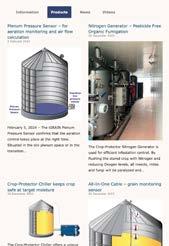



MySilo
+90 382 266 22 45
www.mysilo.com
PROFILE: mymag.info/Hmwu
Obial
+90 382 2662120
www.obial.com.tr
PROFILE: mymag.info/qYti
Silo Construction & Engineering
+32 51723128
www.sce.be
PROFILE: mymag.info/UOay
Symaga
+34 91 726 43 04
www.symaga.com
PROFILE: mymag.info/vxbf


Top Silo Constructions (TSC)
+31 543 473 979
www.tsc-silos.com
PROFILE: mymag.info/HTSY
Van Aarsen International
+31 475 579 444
www.aarsen.com
PROFILE: mymag.info/JUgk
Temperature monitoring


iGrain
+45 31633900
https://crop-protector.com
PROFILE: mymag.info/FxFP

Inteqnion
+31 543 49 44 66
www.inteqnion.com
PROFILE: mymag.info/ZyIm
vibronet-Gräf GmbH & Co.KG
+49 6441 62031
www.vibronet.com
PROFILE: mymag.info/icHn
Training



Bühler AG
+41 71 955 11 11
www.buhlergroup.com
PROFILE: mymag.info/dZxH
Bühler AG
+41 71 955 11 11
www.buhlergroup.com
PROFILE: mymag.info/dZxH
IAOM
+1 913 338 3377
www.iaom.info
PROFILE: mymag.info/pZZa
IFF
+495307 92220
www.iff-braunschweig.de
PROFILE: mymag.info/XbmE
Kansas State University
+1 785 532 6161
www.grains.k-state.edu
PROFILE: mymag.info/xsza

OMS
+441242 267700
www.onlinemillingschool.com
PROFILE: https://millingandgrain. com/oDQm
Ocrim
+39 0372 4011
www.ocrim.com
PROFILE: mymag.info/ckSh
UK Flour Millers
+44 2074 932521
www.ukflourmillers.org
PROFILE: mymag.info/xWwB
Vibrators
Vibrafloor
+33 3 85 44 06 78
www.vibrafloor.com
PROFILE: mymag.info/cgrU
Weighing equipment


Bühler AG
+41 71 955 11 11
www.buhlergroup.com
PROFILE: mymag.info/dZxH
Friedrich Electronic
+49 6406 923350
www.friedrich-electronic.de
PROFILE: mymag.info/gbBd
KSE
+31 497 383818
www.ksegroup.com
PROFILE: https://mymag.info/fhSV
PLP
+39 05 23 89 16 29
www.plp-systems.com
PROFILE: mymag.info/PGWg
Van Aarsen International

+31 475 579 444
www.aarsen.com
PROFILE: mymag.info/JUgk
Vibrafloor
+33 3 85 44 06 78
www.vibrafloor.com
PROFILE: mymag.info/cgrU
vibronet-Gräf GmbH & Co.KG
+49 6441 62031
www.vibronet.com
PROFILE: mymag.info/icHn
Yeast products

Leiber GmbH
+49 5461 93030
www.leibergmbh.de
PROFILE: mymag.info/wpdz
Milling and Grain - April 2024 | 99
SCE
Silo Construction & Engineering
Belgium
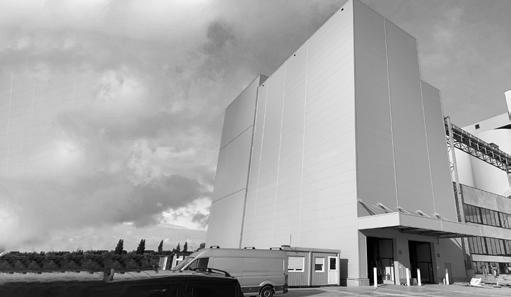
A technically challenging project with a tight and rapidly approaching deadline? SCE is never daunted by a challenge. This was proven once again by the fully customised project SCE realised in the Port of Zeebrugge for Borlix, a supplier and producer of raw materials for the feed and food industry and part of Maselis.
Borlix processes various ingredients and raw materials such as oats, soybeans, linseed, lupins and other cereals in Zeebrugge. The company recently invested in a new production unit. The silo building had to be completed as soon as possible. “Due to the proximity to the sea and the high wind load, we opted for a galvanised steel structure. This will make the building better resistant to corrosion and able to withstand the saline environment and often harsh weather conditions on the coast,” explains sales manager Koen Verbrugge. “It took four months to complete the shell. After this, we installed the insulating sandwich panels.”
Precision work
Inside, you will find 21 square SCE silos equipped with patented butterfly hoppers to guarantee a smooth outflow of product. Seven of these silos are intended for intermediate storage, and fourteen for the discharge of by-products. Supply

lines fill the seven silos allocated for intermediate storage, facilitating the supply of raw materials to the production lines. After-production, the by-products are transported to the square silos and subsequently discharged for further processing, primarily into animal feed. “To ensure an adequate production flow, the silo building had to be connected directly to the production hall. This is custom work, in which precision is key,” recalls Koen. “We also installed 14 round silos equipped with a weighing solution. Other advantages include the flat floors, which require little maintenance and ensure safe working conditions, and the additional awning above the gates. This guarantees dry loading and unloading conditions.”
An enriching experience
Despite the compact surface area, SCE was able to construct a silo building that allows Borlix’s production flow to run perfectly smoothly. Koen concludes: “The rapid delivery and integration of different systems posed an additional challenge. We provided Borlix with professional support, with a positive result. What also made this project so special was inviting all our employees to visit the site during the assembly phase to show them how a silo like this is built. This was a truly enriching experience for everyone at SCE.” Silo Construction & Engineering +32
The demand for food is becoming bigger and bigger with an increasing global population, which is why companies will have to produce more efficiently and effectively. Bulk

• A brand new feed mill in Germany by SCE
• We’ve got ten more years to bring our food chain under control
• What if mass flow in silos can make your life easier?
51723128 www.sce.be PROFILE: mymag.info/UOay
installation
Industry Profile 100 | April 2024 - Milling and Grain
storage | Mill design &
| Silos mymag.info/UOay

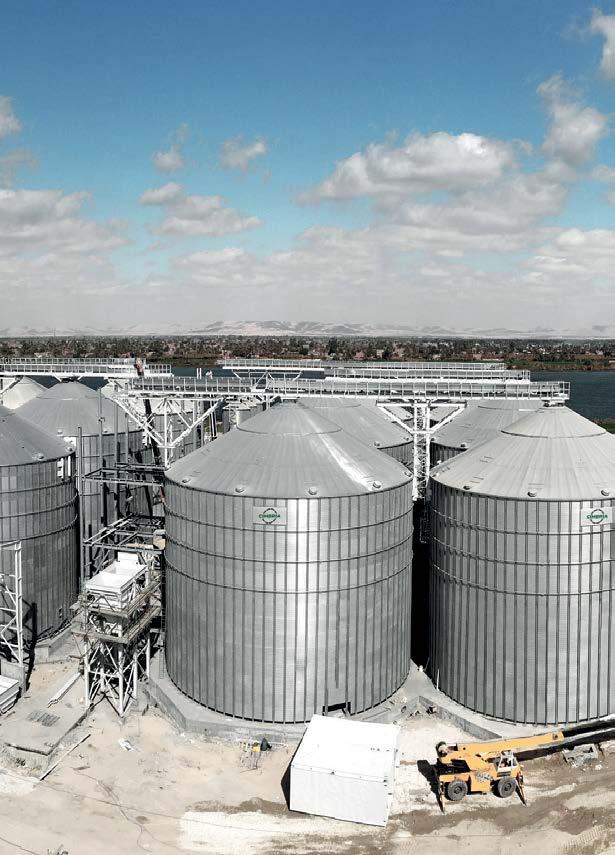


CHARITIES DIRECTORY
Milling and Grain is hosting a directory of milling industry charities and charitable organisations working in the milling sector under its UK Milling 4 Life CIO Charity. The aim of the directory is to build greater awareness of the work these charities do and how you might be able to donate funds to their specific projects and activities. Milling 4 life is not affiliated with these charities, but lists those working in the milling sector here along with their contact details for information and direct donations. Milling and Grain will feature each charity in turn in this section of the magazine in order to provide background information on each
Flour to the People by Scotland the bread Scotland
REGISTERED CHARITY No.-SC048892
https://scotlandthebread.org
Scotland The Bread is a collaborative project to establish a Scottish flour and bread supply that is healthy, equitable, locally controlled and sustainable.
Our idea is simple: grow nutritious wheat and bake it properly close to home.
Donations to support our work are urgently needed and very welcome. Thank you for your contribution.

Milling 4 Life
UK / International
REGISTERED CHARITY No. 1172699
https://millingforlife.com
Our goal is to help relieve malnutrition and poverty through the development and uptake of food and feed milling technology and processes; by encouraging agricultural improvements in the first instance followed by encouraging the adoption of the proper handling and storage of raw material and the uptake of milling processes to provide safe and affordable food products for both people and livestock (including fish) in transitional countries.
The George Family Foundation
UK
https://whitworthbros.ltd.uk/charitable-foundation
The George Family Foundation was established in 2020 as a registered charity independent of the Whitworths Holdings Group. It is run by three trustees, two of which are members of the George family and one who is independent. Currently the Foundation plans to donate a minimum of £100,000 per year to individuals and organisations whose purposes align with the values of the George Family.

The Green's Windmill Trust
UK
REGISTERED CHARITY No. 1163116
www.greensmill.org.uk
Green’s Windmill Trust started over 13 years ago as a small group of people who wished to help preserve the milling heritage of the windmill, promote George Green’s reputation as one of the greatest scientists of his age and further the educational and public activities of the Science Centre.
In 2012 we became a registered charity and began taking over day-to-day operations at the Mill and Science Centre from Nottingham City Council.

The Mills Archive Trust UK
REGISTERED CHARITY No. 1155828
https://new.millsarchive.org/
The Mills Archive is a permanent repository for the documentary and photographic records of traditional and contemporary mills and milling, as well as similar structures dependent on traditional power sources. It makes that material freely available for public inspection and use in research and learning.
The Mills Archive is one of the world’s great mill collections. It has rescued over the million documents and images that might otherwise have ended up in a landfill site. It is an Aladdin’s cave filled with memories and free to users. The collections show the rich and diverse crafts, buildings, machinery, equipment and people involved with mills in the UK and around the world.

Flour World Museum
Germany
REGISTERED CHARITY No. 1155828
https://mehlwelten.de/english/index.php
The FlourWorld Museum in Wittenburg is an invitation to millers and friends of flour and bread from all over the world to rediscover this vital basic food with all their senses.
The FlourWorld Museum in Wittenburg is also a tribute to the millers of the world and a gesture of thanks for our close partnership with the international Milling Family, whose inspiration and active support enabled us to transform an eccentric idea into a museum that is unique in the world.

THE JORDAN TRUST UK https://jordansmill.com
The Jordan Trust, run in association with Jordans Mill is registered as a charity, limited by guarantee and is based on the River Ivel at Holme Mills, Biggleswade.
The objectives of the Trust are to protect and preserve the character of the River Ivel site where flour milling was recorded in the Domesday Book of 1086.
Central to Holme Mills is the unique water driven Mill building which was last rebuilt following a fire in 1899. Visitors to the mill are able to gain an understanding from staff and volunteers about the process involved to produce a variety of flour products from wheat varieties grown in the Ivel Valley over the last 1000 years. In its day, this mill was a technologically advanced example of a milling system based on steel rolls rather than the millstones which had been powered for centuries by the power created by a six foot drop in water level on the Ivel river.

If you would like to list you charity under this directory, please email us at editorial@ perendale.co.uk
SETS THE STANDARD IN SQUARE SILOS
Bauck Mühle, Germany
“The biggest challenge during installation was working simultaneously with the concrete builder. This required good cooperation and planning. The installation went smoothly, with a great result. And so we contributed to one of the most modern bio-mills in Europe.”
Dennis Haman, Project leader

Scan this QR code for our references!
Location: Application: Rosche, Germany Bio grainhandling and flour Capacity 5.700 m³ Project details Bins 51 Width 11 m Length 35 m
Milling and Grain - April 2024 | 103
the interview
Stefan Scheiber, CEO, Bühler, Switzerland
Stefan Scheiber graduated in Business Administration from the University of Applied Science in St. Gallen and later continued his education at the Institute IMD Lausanne and the Harvard Business School. In 1986, Stefan Scheiber started as a management trainee at Bühler and has spent more than 30 years with Bühler in different functions. From 1988 onwards, he has worked in various international management positions within Bühler worldwide, including East and South Africa, Eastern Europe, and Germany. Furthermore, Stefan Scheiber is a Member of the Board of Directors of the Kistler Group and Bucher Industries AG, and a Member of the Executive Committee of Swissmem as well as of economiesuisse.
There is a strong drive by Bühler to help the food industry develop alternative protein food stuffs. You mentioned in the Bühler earlier this year that there is a slight drawback from alternatives to meat in 2023. What do you believe the future is for a meat replacement coming out of the Milling sector?
A couple of years before we had seen a hype of investments into processing technologies. In the meantime, I believe the industry reset its focus a bit more towards clean label products, more sustainable products, new recipes based on raw materials which we can actually track through the whole value chain. I do believe that consumers in Europe, America and also in Asia have accepted many of the new products which came onto the market. Now the industry is refocusing a little bit on the on the raw material side. And as this is progressing, I believe the industry will come back with higher Investments over the next couple of years because sustainability remains a very important aspect for the players in the industry as well as for consumers.
I think in the last 30 years, Bühler has shown itself to be a leader in the technology that the milling industry is adopting. Do you see that trend continuing into smart milling or smart manufacturing? Or have we reached a plateau where we need to pause a little bit and integrate these technologies into our businesses? I believe that at any point in time we look back and actually feel “that’s it’’. We have achieved the highest level of industrialization, digitalization, automatization, the stateof the-art modernization. And yet when we look at the milling industry over the past decade and there is always innovation. Sometimes on the mechanical side, then again more on the digital side. Bühler have been and will be continuing to invest into these new technologies because I believe there will be never an end to the need of the population on this planet for good and healthy food.
Skills that are needed to run the modern mill is changing and particularly with reference to a more rural environment where there’s a lack of traditional workers or workforce that we might have appreciated in the past. Do you see training is particularly important to the milling industry at this time?
Yes, absolutely. Training has been and will remain to be super important to us. That’s why Bühler also continues to invest internally and also for our customers into the profession
of the milling industry. We collaborate with universities and schools across the world. We operate own schools across the globe and I think this collaboration and this investment is absolutely essential because we need to keep these professions and the millers of high appreciation in the society. I have to reiterate that indeed the topic of access to skills, retention of skills and continuous training remains key wherever I go, in nearly all markets in the world.
Do you think by the industry focusing more on young people coming in that we will go some way to addressing the legitimate impact that milling has on the environment?
I believe it’s very important that we continue playing this role of educating and addressing sustainability issues as well that the people continue to understand how good bread and good food is being produced and what it needs to produce good food on a sustainable basis for a population of eight billion people on the planet. At the same time with climate change, with perhaps less arable land available and with water issues here across the globe, we need to address the topic of sustainability and we can with education, with responsible entrepreneurship and then also with new technologies. I believe the combination of all these efforts will contribute to the solution of these challenges we see ahead. We also see that the consumers are playing an important role, they demand more information about raw material and carbon footprint. I think if we see this not as a threat but as an opportunity to show the whole society what we are doing in our industry.
Do you think there’s a bit of confusion out there about the difference between sustainability, environmental impact etc? Do you think they fully recognise now the task in front of them in the focus and have a clear picture of the direction they should be going in as a group?
Of course, there are many questions and I understand that sometimes people are indeed confused. But I think it’s important that we share learnings and that we focus on science and technology, that we create awareness of the problem. We always start by creating transparency and this is also a service which Bühler has developed over time. We have a team which consults millers across the world about, for instance, what is the current CO2 footprint and what are the drivers of the CO2 footprint within their processes and how can we best tackle them etc. I think the awareness
104 | April 2024 - Milling and Grain

and also technical ability to control these processes better can solve the questions which many of the miller still have and potentially also solve the uncertainties which we have.
Do you see that the developments we’re making to reduce CO2 is a cost that gets passed on or are we trying to do that within the affordability of the products that we make?
First of all, I do believe that cost does play a role. It’s important to address this and not neglect this. I think it’s important that you have to see it as an investment into the future, that you make your assets more modern. You improve the yields out of the raw material and produce a good end product quality through this. You actually address also sustainability issues because it’s not a big surprise that a lot of the CO2 footprints of a miller is in the raw material and not necessarily in their assets. So the making best use of the raw material is the essence of also becoming more sustainable and here I do see how this actually develops and that is also a driver for new business.
PEOPLE THE INDUSTRY FACES



Gina Tumbarello to serve US advisory committee
The American Feed Industry Association (AFIA) announced that Gina Tumbarello, AFIA’s senior director of global strategies, policy and trade, has been appointed by US Secretary of Commerce Gina Raimondo to serve on the Advisory Committee on Supply Chain Competitiveness. Tumbarello will be instrumental in advising the committee on the development and administration of programs and policies to strengthen the competitiveness and resiliency of US supply chains used throughout the animal food chain.
“Over the past several years, our members across the animal food industry have experienced challenges fulfilling customers’ orders in a timely and cost-effective way due to labour disputes, weak transportation infrastructure and political conflicts. While many issues have been resolved, we know challenges lurk around the corner,” said AFIA President and Chief Executive Constance Cullman. “We are grateful that Gina Tumbarello will be able to serve as the industry’s voice as it looks to proactively improve America’s competitiveness in the future.”
Established in November 2011, the committee advises the commerce secretary on crafting a comprehensive and integrated national freight infrastructure and policy framework geared toward supporting US export growth and national economic competitiveness. This framework is intended to propel US export expansion, fortify national economic competitiveness and elevate the efficiency of domestic and global supply chains, including those used by the feed and petfood sector.
Schule Mühlenbau appoints new Managing Director
FH Schule Mühlenbau GmbH, a Kahl Group company, has appointed Heiko Otte-Witte as its new Managing Director. The 54-year-old succeeds Uwe Wehrmann. Together with Marius Hermes, he takes over the management of the specialist milling company. Schule Mühlenbau builds and sells rice and oat mills worldwide, as well as plants for processing pulses, oilseeds and specialty products such as bulgur, buckwheat and spelt. Heiko Otte-Witte is no stranger to the company based in Reinbek near Hamburg. From 2021 to 2023, he was responsible for managing major projects there. Since January, he has been supporting Marius Hermes in the management. Thanks to his many years of experience in the milling industry, he is well qualified for his new position. A miller by trade, he has held various positions in the industry during his career, including production manager of a hulling mill, engineering manager and technical director.
His new responsibilities include further developing the machines and plants and opening up new areas of business, such as protein extraction. The focus of these measures is the strengthening of Schule Mühlenbau’s competitiveness. “I’m looking forward to the new challenge,” says Heiko Otte-Witte. “We want to continue to supply high-quality machines and plants worldwide and be a reliable and competent partner for our existing and new customers, true to our Schule slogan: Your Partner in Milling”.
Camryn Wilder receives the Frank Perdue Scholarship Student of the Year Award
Camryn Wilder, Texas A&M University, was awarded the Frank Perdue Scholarship Student of the Year during the USPoultry Foundation’s College Student Career Program, held in conjunction with the 2024 International Poultry Production Expo (IPPE).
The scholarship is named in Frank Perdue’s honour, for his dedication to aspiring young people studying for careers in the poultry industry. Perdue was a long-time supporter of the College Student Career Program and attended the program and interviewed students for many years. Abigail Flores, Texas A&M University, and Zachery Keeter, North Carolina State University, were recognised in second and third place.
“We received many high-caliber applicants this year for the Student of the Year, making it difficult to choose a winner. It is rewarding to see this program continue to grow and expose talented future leaders to the poultry and egg industry,” commented Kevin McDaniel, senior vice president and general manager, Fresh Division at Wayne-Sanderson Farms, USPoultry Board member and College Student Career Program Advisory Committee chair.
106 | April 2024 - Milling and Grain
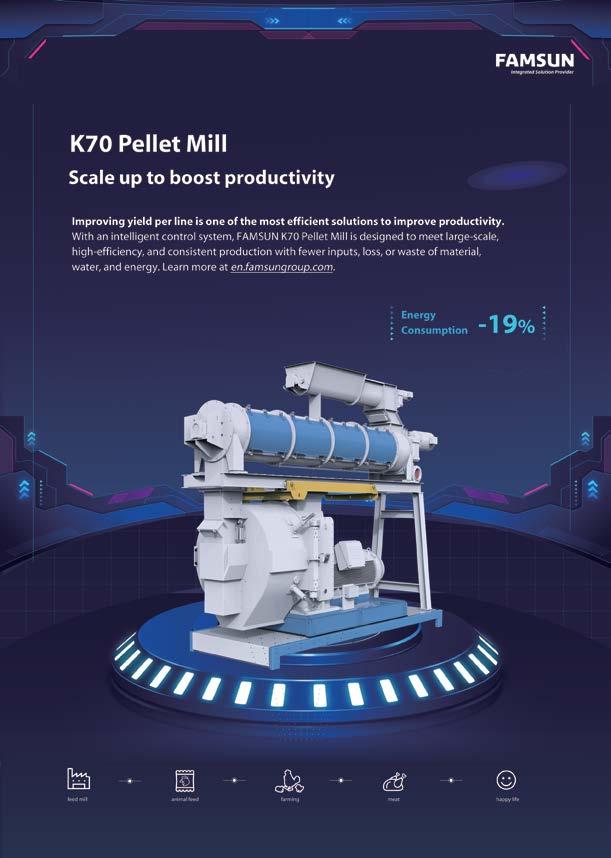
Downtime happens.
We train daily to minimize it.
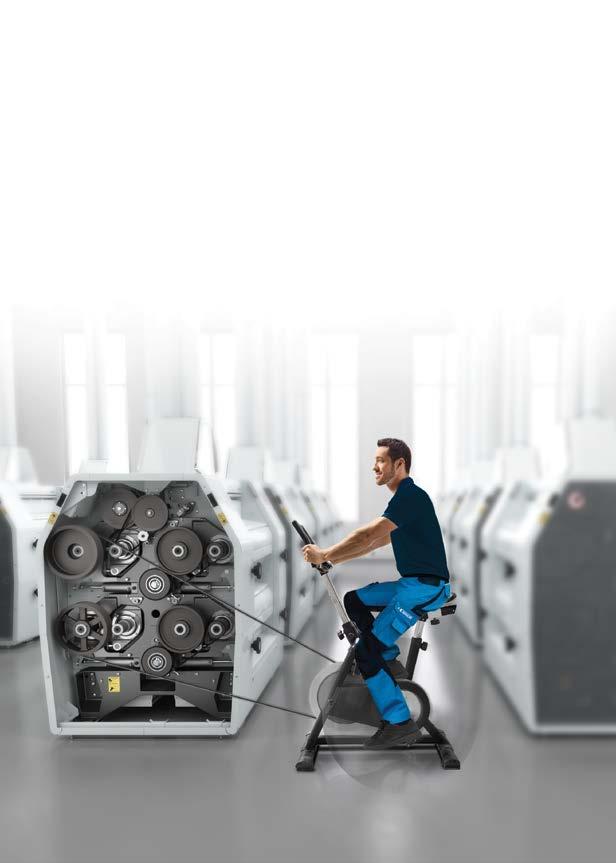
Let’s talk. Together we can discuss the possibilities around downtime reduction
For more information on our downtime saving portfolio
Please scan the QR code

Innovations for a better world.












 Roger Gilbert
Roger Gilbert































 A line of Simon Plansifters Further Simon Plansifters showing exhaust trunking and sampling table
A line of Simon Plansifters Further Simon Plansifters showing exhaust trunking and sampling table























 by Dr Mahmoud Riyad, Secretary-General, Egyptian Milling Association, Egypt
by Dr Mahmoud Riyad, Secretary-General, Egyptian Milling Association, Egypt
















































































































 by Mehmet Ugur Gurkaynak, Milling and Grain, Türkiye
by Mehmet Ugur Gurkaynak, Milling and Grain, Türkiye















 by Markus Wiltafsky-Martin, Director Service Commercialization, Evonik Animal Nutrition, Germany
by Markus Wiltafsky-Martin, Director Service Commercialization, Evonik Animal Nutrition, Germany












 On the Chief Agri stand were (from left) Jeff Schmidt, Travys Woodside and Paul Allen. Chief has been exhibiting and supporting GEAPS for 37 years
Dillon Phillips, milling sales with Britney proudly presents the Cimbria SEA.IQ high-end optical sorter at GEAPS 2024
Tom Boehm and Hamza Aziz of Rayhawk from Saskatoon, Canada are making efficiencies and savings in railcar top-loading solutions using computer vision, machine learning and autonomous operations combined to open and close railcars for grain loading while minimising worker risks and speeding up throughput
On the Chief Agri stand were (from left) Jeff Schmidt, Travys Woodside and Paul Allen. Chief has been exhibiting and supporting GEAPS for 37 years
Dillon Phillips, milling sales with Britney proudly presents the Cimbria SEA.IQ high-end optical sorter at GEAPS 2024
Tom Boehm and Hamza Aziz of Rayhawk from Saskatoon, Canada are making efficiencies and savings in railcar top-loading solutions using computer vision, machine learning and autonomous operations combined to open and close railcars for grain loading while minimising worker risks and speeding up throughput






























 Betsy Polis, Adrianne Fjerstad-Miller, Brittany Labatt at the GEAPS Exchange 2024 Welcome Desk
Satake Corporation of Japan manufactures and services sophisticated optical sorters for a range of food products. The Satake optical sorters includes Evolution RGB, MIR, the RNEZS, RNEZX, RGBR and the FMSR-IR, Beltuza and the FMS2000. This range gives Satake the capability to sort a very large range of food products. From left is Joe Escamilla and Peter Matthews of Stafford, Texas
Johannes Karcher and Ted Smith of FrigorTec with Darren Parris of Milling and Grain discussing grain cooling and the conservation of grain, rice and seeds using the unique grain chiller GrainFrigor. This machine has been installed in over 70 countries since 1963 - made in Germany
The team from 4B Components at GEAPS 2024: From left are Randy, and colleague, Nilton, Brian, Roger, president Johnny Wheat and Gil
Jordan, Nick and Chris of Universal Industries were keen to show us their of elevators
Betsy Polis, Adrianne Fjerstad-Miller, Brittany Labatt at the GEAPS Exchange 2024 Welcome Desk
Satake Corporation of Japan manufactures and services sophisticated optical sorters for a range of food products. The Satake optical sorters includes Evolution RGB, MIR, the RNEZS, RNEZX, RGBR and the FMSR-IR, Beltuza and the FMS2000. This range gives Satake the capability to sort a very large range of food products. From left is Joe Escamilla and Peter Matthews of Stafford, Texas
Johannes Karcher and Ted Smith of FrigorTec with Darren Parris of Milling and Grain discussing grain cooling and the conservation of grain, rice and seeds using the unique grain chiller GrainFrigor. This machine has been installed in over 70 countries since 1963 - made in Germany
The team from 4B Components at GEAPS 2024: From left are Randy, and colleague, Nilton, Brian, Roger, president Johnny Wheat and Gil
Jordan, Nick and Chris of Universal Industries were keen to show us their of elevators















 The Brock team at GEAPS. It was difficult to gather all members of the team from left is: Tim Stinson, John Tuttle, Terry Nierengarten, Tony Rabey, Ernesto Dalponte, Mike Manheim and Bill Winchell. Brock’s commercial line of bucket elevators and drag conveyors with models capable of handling up to 25,000 bushels (680 metric tonnes) are well recognised for their reliability and rugged quality. Brock exhibited its breakthrough technology with their TrueGrain™ Moisture Sensor System offering improved accuracy for measuring direct grain flow moisture levels exiting the dryer amount other technologies
Cenk Apa of Tanis Seed Processing Tech, Turkey was exhibiting & promoting its range of grain cleaning and sorting equipment
Roger Gilbert with Tapco’s Luis Avalos and Jon Rue talking strength in elevator buckets
Roger Gilbert talks with Kirk Nelson of Behlen Grain Systems. Behlen is a leading supplier of commercial grain storage systems offering a full line of commercial hopper tanks and steel storage bins with a wide range of options and capacities, including the largest bins available in the market
The Brock team at GEAPS. It was difficult to gather all members of the team from left is: Tim Stinson, John Tuttle, Terry Nierengarten, Tony Rabey, Ernesto Dalponte, Mike Manheim and Bill Winchell. Brock’s commercial line of bucket elevators and drag conveyors with models capable of handling up to 25,000 bushels (680 metric tonnes) are well recognised for their reliability and rugged quality. Brock exhibited its breakthrough technology with their TrueGrain™ Moisture Sensor System offering improved accuracy for measuring direct grain flow moisture levels exiting the dryer amount other technologies
Cenk Apa of Tanis Seed Processing Tech, Turkey was exhibiting & promoting its range of grain cleaning and sorting equipment
Roger Gilbert with Tapco’s Luis Avalos and Jon Rue talking strength in elevator buckets
Roger Gilbert talks with Kirk Nelson of Behlen Grain Systems. Behlen is a leading supplier of commercial grain storage systems offering a full line of commercial hopper tanks and steel storage bins with a wide range of options and capacities, including the largest bins available in the market

































































































